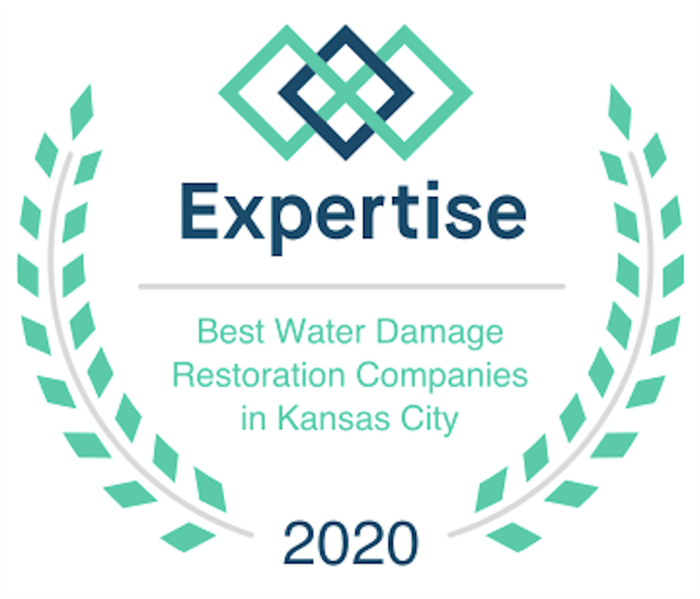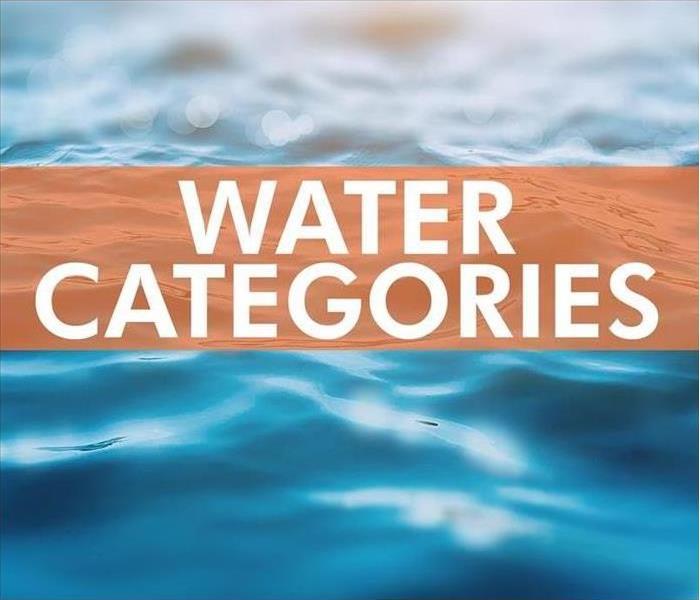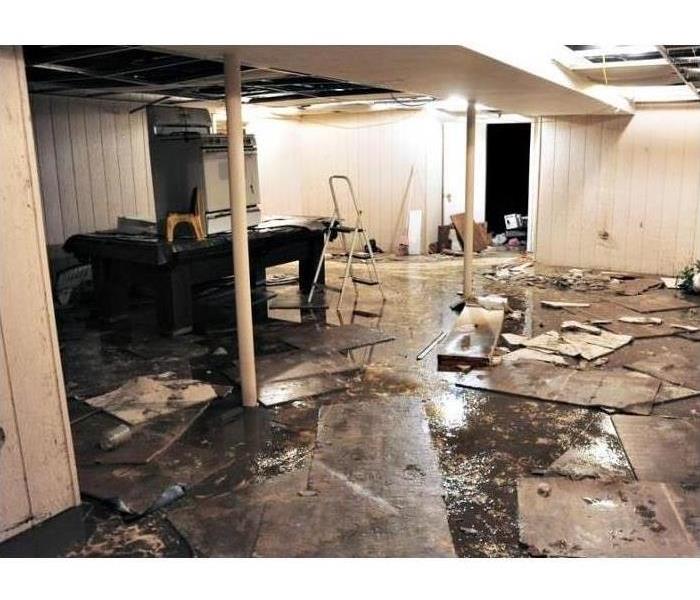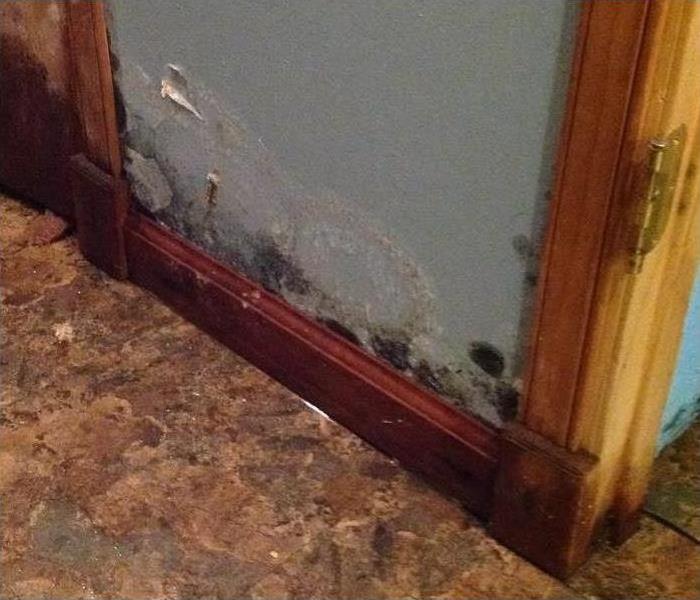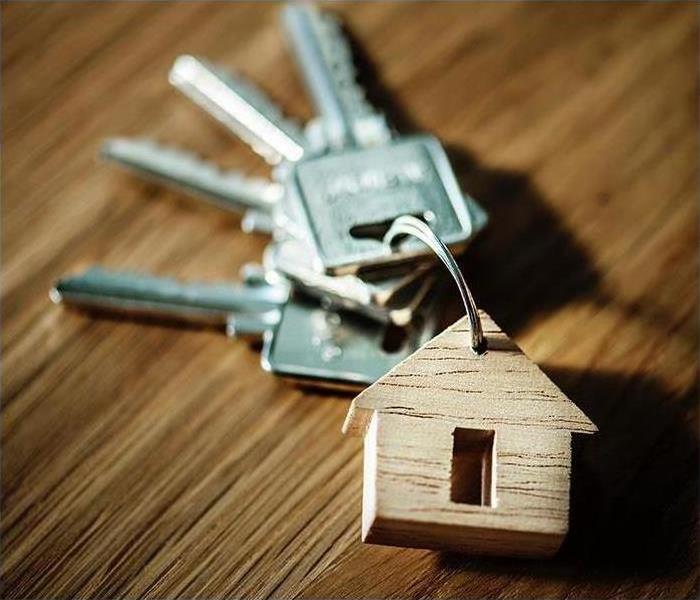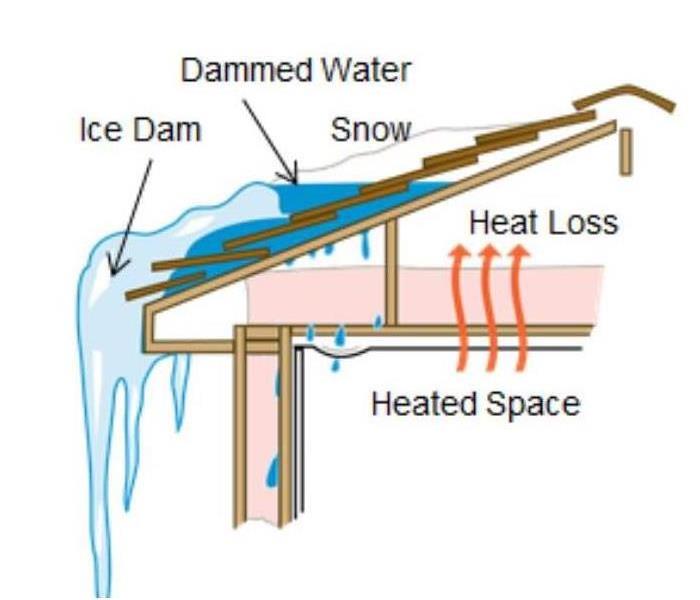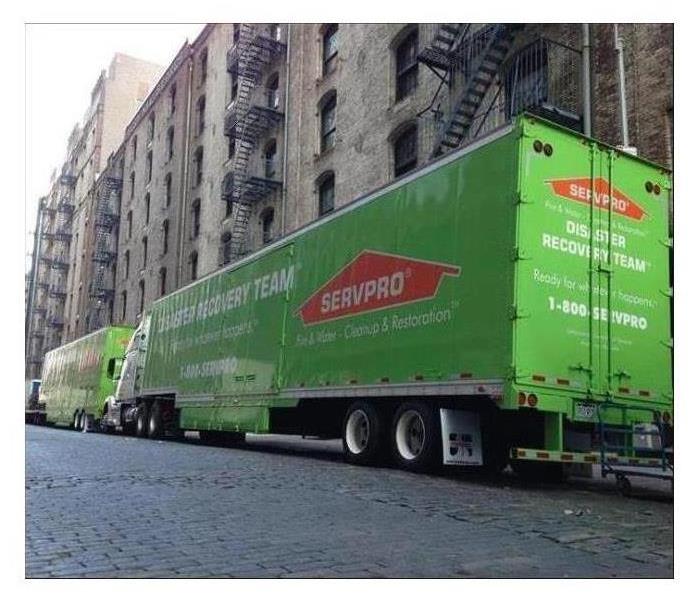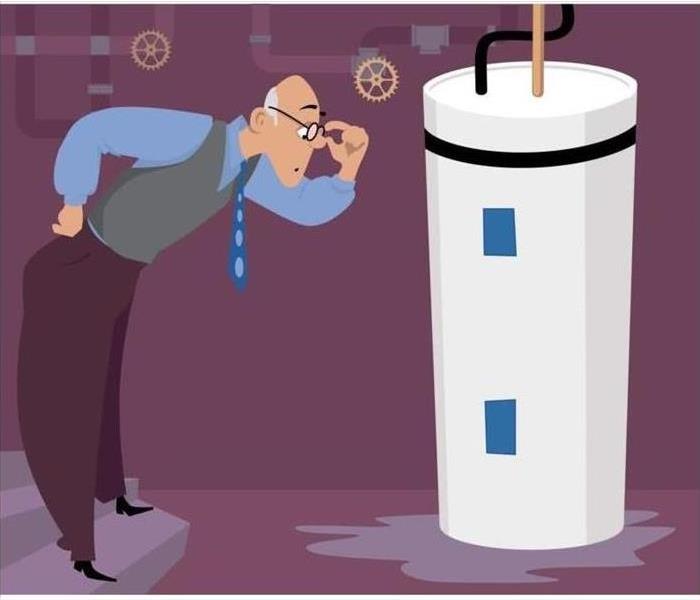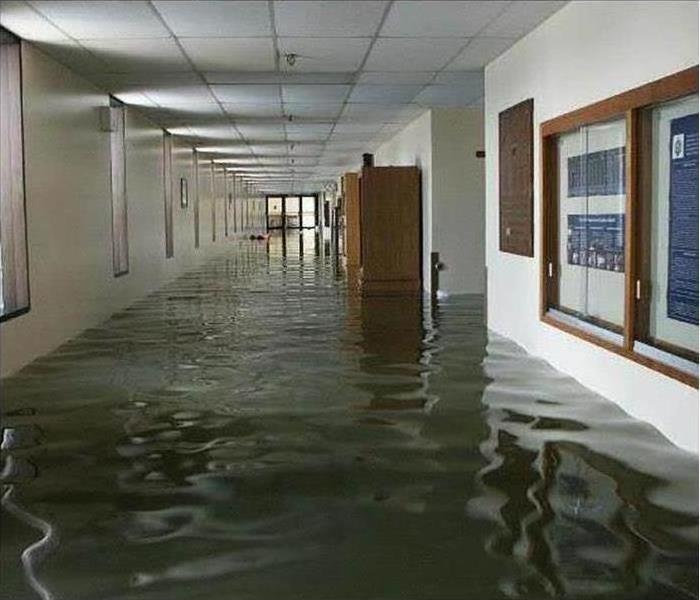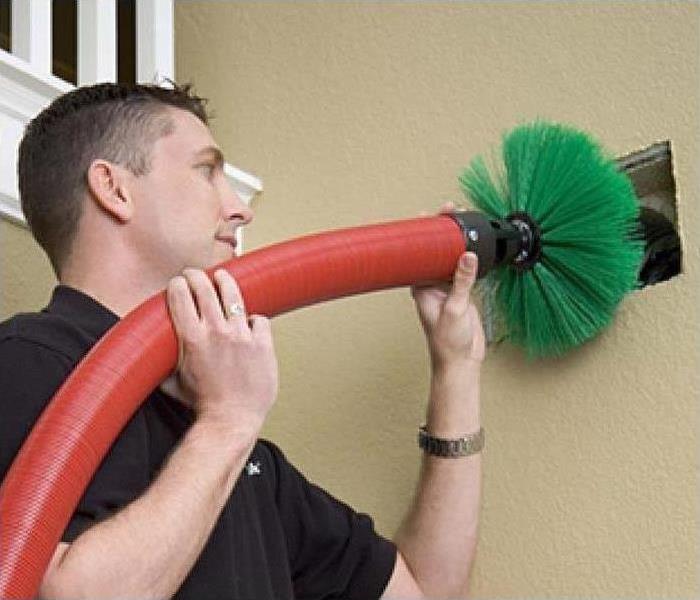Archived Blog Posts
How to Use Building Envelopes to Keep Your Property Dry
12/20/2022 (Permalink)
Rain damage can harm a commercial building in several ways. It creates an overflow of water, which may necessitate expensive flood cleanup. The water can destroy both the structure of a building and the contents inside it. Rain damage can also lead to a buildup of black mold.
Thankfully, there are ways to prevent major storm damage to your property. One common tactic is securing the building envelope. This envelope consists of the wall systems and the roof, and it has several functions. They include:
- Resisting the escape of cool or hot air
- Diverting water to the storm drains
- Protecting and supporting equipment
- Defending the building from snow or rain
Securing the Envelope
Water penetration is responsible for the majority of harm to buildings. Flood damage, in particular, can be costly. Worst of all, water does not need a lot of space to get inside a property. A hole as small as 0.005 inches is all it takes.
This hole can result from cracks in the plaster and brick that make up the walls. Poorly installed joints can cause gaps, as well. To limit the rain damage to your property, be sure to seal as many of these openings as possible.
Designing the Envelope
When building or remodeling the envelope for your property, you should take certain additional steps to keep the area secure. If possible, limit the number of protrusions you use. You should also avoid using too many different cladding materials. You may want to include rain screens and capillary breaks, as well.
There are backup systems you can install, too. You can utilize weep holes that drain excess water to the outside of the building. You can also use through-wall flashing to divert moisture to the exterior.
Proper maintenance of your commercial building envelope can prevent rain damage. However, if your property does sustain a leak, storm cleanup specialists can assist with the restoration process.
Three Reasons Why Your Toilet Is Leaking
12/15/2022 (Permalink)
A leaking toilet can be a major nuisance, especially when the underlying cause is unknown. If your home has a bathroom leak that goes untreated, the resulting damage can be costly. The following are three possible reasons why your toilet leaks with every flush.
1. Malfunctioning Wax Ring
A common cause of this type of leak is the failure of the wax seal underneath the toilet. When working properly, the wax ring functions as a barrier between the toilet and floor flange to keep water from seeping out. When this wax seal is malfunctioning, it could be that the wax has become dry over time and no longer functions as a barrier, or that the seal was improperly installed with the toilet.
2. Broken Tank Flange
Another potential cause of a leaking toilet is a broken tank flange. If the flange is not properly installed, it can shift out of place and crack under pressure. Because your toilet is a relatively high-traffic area of your home, even a small crack in a tank flange can quickly become a cause for concern and require replacement.
3. Loose Tank
Bathroom leaks that are not pooling on the floor near the base of the toilet can sometimes be traced back to the tank itself. If your toilet is leaking from the tank, but you see no obvious cracks or damage through which water might escape, your tank might just be loose. The connection between the tank and the rest of the toilet can become loose over time and will most likely cost less to repair than to replace entirely.
A leaking toilet can be a headache to deal with on your own. Hiring a professional specializing in water damage repair can help fix existing issues and minimize costly water damage in your bathroom to make it seem "Like it never even happened."
The Top Five Places Where Mold Might Be Hiding
11/24/2022 (Permalink)
Top Five Places Where Mold Might Be Lurking
While you can call a remediation company if you suspect a mold problem in your home, a team of professionals is not always immediately necessary. There are varying degrees of mold growth, from itemized occurrences to full-scale infestations. The best way to understand your current mold problem is to inspect your home and know the top five places where mold might be lurking.
- Behind walls
- Under flooring
- HVAC systems
- Beneath Sinks
- Mechanical Closet
Behind Walls
Mold exists in dark, damp spaces. Wall cavities provide an excellent environment for spores to thrive. While you might not expect a significant issue when you come across a small area of moldy drywall, know that when mold presents on the surface of a wall, it is likely well-developed behind as well.
Under Flooring
Similar to moldy walls, mold on wood floors typically suggests a more substantial issue beneath the floorboards. However, that doesn't only go for wood floors. Some flooring types exacerbate the problem because there are limited if any, visual clues. For example, linoleum flooring is nonporous, which means that mold cannot penetrate through to the surface.
HVAC Systems
Unfortunately, when mold growth occurs anywhere in the house, your HVAC system may have been infiltrated as well. Look for signs of discoloration of vent covers and a musty odor coming through as well.
Beneath Sinks
Another common space for mold to develop is underneath sinks. While these areas are not as hidden as some, homeowners typically store cleaners and supplies under sinks, making it difficult to discern whether there are minor leaks that could create an environment for spores to settle and multiply.
Mechanical Closet
Last, similar to cabinets under sinks, a home's mechanical closet - the area where the water heater is found - is also a prime location for mold development. These spaces are often humid and dark, and because they are not checked on regularly, leaks do occur, leading to the growth and reproduction of spores.
No homeowner wants mold growth developing in their home. Therefore, it is necessary to inspect your house vigilantly and to call for professional help when needed.
Be Safer With a Home Fire Extinguisher
11/24/2022 (Permalink)
Small incidental fires can begin at home for several reasons; a cigarette, a grease fire on the stovetop, or a lit candle or space heater left unattended. A small home fire can often be put out with a fire extinguisher, rather than calling the fire department in Raytown, MO. That, of course, depends on the size of the fire and the type of extinguisher you have.
Get the Right Extinguisher
Part of fire preparedness is knowing which kind of fire extinguisher is best for certain fires. Understanding the difference is of great importance, as some can do more harm than good. The following list explains the difference.
Type A – Suitable for everyday combustibles such as paper, fabric, and wood
Type B – Works best for fuels like gasoline, butane, and cooking oils
Type C – A most appropriate choice for electrical fires
Additional Information
Not only do extinguishers have different types, but they have other variations besides. Type A and B have a number before the letter to designate their effectiveness. A 4-A works better on a paper fire than a 2-A. If the unit has a C but no number ahead of it, it means it will not conduct electricity.
Which Extinguisher is Best?
The kind you decide to keep in your home depends on where you intend to keep it. You may decide you need more than one at hand for the greatest safety. For instance, you would do well to keep a type B in the kitchen where you are most likely to experience a grease fire. You might want to keep a type C near the breaker box and a type A near a home den, library, or craft room.
In the event, a larger blaze breaks out and you require more than a fire extinguisher, call 911 immediately. Then get help to assess the fire damage and manage fire cleanup, call the fire and water restoration service in Raytown, MO for help. They can handle the fire damage cleanup and help get things back to normal. Preparation can help you avoid a disaster, however, so keep a couple of extinguishers at hand.
3 Tips for Recovering From Storm Damage
11/13/2022 (Permalink)
When a serious storm is in the forecast, the potential for property damage is always present. Do you know what to do in the wake of an extreme weather event? Here are some storm tips to minimize the destruction and get back to normal after a storm hits your property.
Types of Storm Damage
Storms can bring countless types of damage, from hail devastation to broken windows. Some of the most common and destructive forms of storm damage include:
- Wind destruction
- Flood problems
- Electrical issues from lightning strikes
Any of these types of damage can result in extensive property destruction and considerable expense, especially if you don’t know how to handle the aftermath.
Contact Your Insurer
It may seem obvious, but many homeowners wait too long to contact their insurance providers after a storm. Getting in touch with your insurer to describe the wreckage as soon as possible can help you get a claim filed quickly. It can also prevent taking any steps that could void a claim so make the call as soon as you can.
Take Pictures
When you fail to document affected items with images, you run the risk of underestimating just how much damage was done. So whether it’s on a camera or with your phone, taking pictures is one of the most important storm tips you can follow.
Secure Your Property
The only thing worse than sustaining damage in a storm is getting new damage on top of that. Invest in tarps to cover roof holes, board up broken windows with plywood or take any other steps necessary to prevent new wind or water damage from getting inside your home.
What you do after a storm can be just as important as what you do before it. Use these storm tips in the initial wake of a storm and contact the right insurance agent and water cleanup companies to get your property back in tip-top condition.
ERP's and Why They Are Important
8/19/2022 (Permalink)
Being a business owner can have many responsibilities, and you may have to take on multiple roles.
In most cases, disaster is the last thing you are thinking about, but every business owner, regardless of how new or old your business is, should have a plan and guide for what to do in the event of a disaster.
SERVPRO of Lee's Summit offers a free community service called the "Emergency Ready Plan" or an ERP.
ERPs are handy little guides that we make at SERVPRO that contain basic information regarding your property, who owns the property, and where your emergency shut-off locations are.
We document and photograph, where your electrical, water, and gas shut-offs, are, as well as your sprinkler system and security system. We also have the contacts for those utility companies in the event that you must make contact.
Key contacts are also listed in the ERP, such as the owner, the insurance agent for the property, the SERVPRO representative, and the managers of the building.
The emergency contacts and services page has the fire department and police department's emergency and non-emergency numbers as well, that way, if contact is needed, you know where to find all those phone numbers and contact points.
It's very beneficial to have an ERP because although the business owner might know where everything is and who to contact, your employees might not know. Having a guide like this can help so much if the business owner is not present.
ERPs are very convenient as well, we are able to provide a paper copy, and we can provide a digital version on the Ready Plan app! This makes ERPs very easy to access in times of need.
When you run a business, it's good to prepare for not just the next day's shift, but for the things that happen unexpectedly.
SERVPRO of Lee's Summit is always here to help!
Flood Risks
8/1/2022 (Permalink)
Is your home in a flood zone area?
If you’re in the process of buying a house or you’re looking for a new homeowners insurance policy, you might be familiar with what a flood zone is. If you don’t know what they are, you might want to start reading about them.
Zoning for Floods?
A flood zone is an area in a specific geographical space that the Federal Emergency Management Agency has determined has at least some risk of flooding. There are four primary types of zones, which correlate to the severity or category of excessive water events that can occur in that area.
- Moderate to Low-Risk Areas
- High-Risk Areas
- High Risk – Coastal Areas
- Undetermined Risk Areas
How to Find Your Zone
Each area’s zones are depicted on a community's Flood Insurance Rate Map, also known as FIRM, which can be found online at https://www.fema.gov/flood-insurance-rate-map-firm. You can also contact your local municipality or look on their website, most cities will have zoning information available online. You can try searching for the term “flood elevation certificate” for faster results.
Some people may think that these zones can only be found next to a large body of water or along a river or stream, but that’s not the case. Houses that are nowhere near a body of water can experience a flood if there’s a large rainstorm.
Emergency Preparedness
Knowing what kind of flood zone you live in can also be helpful for storage options and emergency preparedness. If you live in a high-risk zone, for example, you probably don’t want to put boxes directly on the floor, and you might want to increase the number of your emergency supplies.
If you weren’t aware that your home is potentially at risk for a flood, and a storm causes water-related damage, you should contact a storm damage specialist in your area to determine your best course of action and get the damage repaired as quickly as possible.
Is Your Business Prepared?
7/29/2022 (Permalink)
Up to 50% of businesses never reopen following a disaster. This usually happens because the amount of damage was too large and too expensive to recover. Your business should be prepared to minimize the damage to your business so that doors can open back for business.
There are a few things you can do to make sure your establishment is ready.
Continuity Plan
A business that does reopen after a disaster must have a preparedness plan. You must identify the components of your business that are essential for it to continue running. Prepare a plan with the appropriate staff as well. Your staff must know who and what should happen in the case of an emergency.
Prepare your Emergency Plan
Have a plan in place. Letting SERVPRO prepare an Emergency Ready Plan (ERP) will help minimize the damage by having a quick response to an emergency. Knowing what and when to do will ensure that the right steps are taken. Something as simple as just knowing where the shutoff valves are can save you from extensive water damage.
Review Your Insurance
Make sure you are familiar with your insurance. You need to know who to call when you need answers regarding your business. Understanding your policies will help you be able to know what is not covered and reassess if your needs require more coverage.
Cyber Security
The physical damages to your property but also internal damage to important files and data. Be sure to have all your data backed up.
How to Reduce the Chance of a Kitchen Fire
7/29/2022 (Permalink)
Though fires can start in any area of the home, many fires often begin in kitchens, and kitchen fires can cause widespread damage to homes. Fortunately, there are various tips you can follow to help to reduce the chance of a kitchen fire occurring in your home.
1. Don't Leave Cooking Food Unattended
When cooking, it can be easy to become distracted. Though you may be tempted to leave your kitchen while cooking, however, this can result in a fire. Items left on a stovetop can burn and catch fire in a short period of time if high heat is used, and if you are out of the room when the fire begins, you may not be able to stop the fire from getting out of control. For these reasons, it's generally best to stay in the kitchen when cooking.
2. Clean Your Kitchen Often
When it comes to fire prevention tips, cleaning your kitchen can be beneficial. If grease has spilled on your stovetop or in your oven, or if you use a dirty, greasy pan, a fire can start quickly. A grease fire can be particularly dangerous because it can spread at an accelerated rate and cause major damage to your home. Cleaning your kitchen often, however, can reduce the likelihood of grease causing a fire.
3. Keep a Fire Extinguisher Nearby
Though a flame in a kitchen doesn't necessarily spell disaster if it is quickly extinguished, fires that aren't quickly controlled can cause devastation to homes. If a home has been affected by major fire damage, many homeowners find it helpful to contact emergency restoration services. However, the sooner you are able to extinguish a fire, the less likely it is that your home will sustain major damage. Having an ABC fire extinguisher (an extinguisher that can put out fires caused by trash, grease, or electricity) in your kitchen can be wise.
Since kitchen fires are incredibly common, knowing tips to prevent this type of fire can be useful to homeowners. Preventative methods can include remaining in your kitchen when cooking, frequently cleaning your kitchen, and keeping a fire extinguisher in your kitchen.
Five Methods to Quickly Extinguish a Fire
7/29/2022 (Permalink)
Oil can catch fire when cooking if frying food is left unattended, allowed to splatter, or heated to too high of a temperature. One of the most disastrous mistakes you can make when dealing with a grease fire is to try and use water to put out the flames as this will only make the fire spread. Instead, try any of the following five methods to quickly extinguish the fire before needing to call in the aid of the fire department and a fire cleanup company.
1. Turn Off the Heat
The first thing you should always do if grease catches fire while you are cooking is to turn off the heat. While you might be tempted to move the pot, leave it where it is.
2. Cover the Flames
If the fire is confined to a single pot or is only in a small area, covering it with an inflammable object like a metal lid can help put out the flames. Make sure not to use a glass lid that can shatter.
3. Baking Soda
If you have a large supply of baking soda on hand, dump as much as you can on the grease fire. The carbon dioxide released by baking soda helps to smother the fire.
4. Salt
Another effective way to put out a kitchen fire is to reach for the salt since it helps prevent the flames from accessing more oxygen. Typically, you require less salt to put out the fire than you need if using baking soda.
5. Fire Extinguisher
A fire extinguisher can be used as a last resort if you have one located nearby in your kitchen. Make sure to only use a Class B or K extinguisher to put out a fire caused by grease.
Experiencing a grease fire can be extremely frightening as the flames often spread quickly. Remember to put down the bucket of water and instead try one of these methods to safely extinguish the fire.
Why The Chemical Mercaptan is a Lifesaver
7/18/2022 (Permalink)
The gas that heats many homes and provides energy for water heaters and clothes dryers is colorless and odorless. If it leaks from pipes or hoses it creates a dangerous situation due to its extreme combustibility. To make gas more detectable, engineers have added the chemical mercaptan, making it easily identifiable by its sulfurous, rotten egg smell. It is hard to estimate how many times a gas fire has been prevented by this chemical.
When a homeowner smells mercaptan it is a sure sign that somewhere in your home there is a gas leak. When this happens, immediate steps should be taken to shut off the gas or at least get people and pets out of the home and call the fire department.
The Best Actions To Take With a Natural Gas Leak
Specific actions can reduce the likelihood of a gas fire in a home or apartment. The goal is to stop the gas leak or increase the safety of everyone in the home. Here are the most effective actions to take:
Check all the appliances that use natural gas, beginning with the stove since this is the most likely source. Many times burners do not light, or go out, allowing gas to leak into the home. If you can find the source of the leak and stop it the emergency is over.
Increase the ventilation of your home by opening windows and doors. This enables the gas to dissipate and not collect in a certain area, reducing the likelihood of a gas explosion.
Don't use electrical devices, or even turn on lights, as this could ignite the gas.
Evacuate the home and call in the fire department
The Best Way To Handle Fire Damage
Gas fire in your home is likely to cause soot and smoke damage and loss of property. Call in a fire remediation team that will respond quickly and clean up the damage in a professional manner.
4th of July Summer Safety Tips
7/18/2022 (Permalink)
The 4th of July is one of the best times of the year in Missouri. Many people get together to celebrate freedom, friends, and food. Unfortunately, the holiday can also be dangerous due to the different risks that are present. When trying to stay safe during the holiday, there are a few important safety tips to follow to protect yourself from harm.
Handle Fireworks with Caution
To prevent injuries and fires that are caused by fireworks in the community, certain precautions should be taken. Never allow small children to get near fireworks or handle them. Adults should be the only ones lighting off the fireworks and should do so on the ground at a safe distance from trees or other objects. Keep a fire extinguisher close by and avoid lighting more than one firework at the same time.
Grill Safely
Grilling can also cause fires when you’re spending time flipping hamburgers and hot dogs outdoors. Look for leaks, holes, and cracks in the grill before you start using it on the 4th of July. Avoid grilling indoors or in an enclosed area. This can cause a fire to start and will lead you to hire professionals such as SERVPRO of Raytown/East Kansas City to repair the damage. The grill should also be placed at least two feet away from the deck, branches, or the siding of the house.
Use a Pool Gate
Many people spend time in the pool cooling off from the warm temperatures in Missouri during the summer season. Keep it a safe activity by using a pool gate that will prevent children from getting into the water when they’re not supervised. Wireless outdoor sensors can also be installed to inform you if a child is near the pool. A first aid kit should also be on hand to tend to any injuries that can occur in the water. Kids should also use life jackets and floatation devices while swimming.
Practice Food Safety
Wash your hands and clean the surfaces where you plan to prep food for the holiday. All meat should be cooked with a thermometer used to ensure that it reaches the right temperature to avoid food-borne illness. All leftovers should be refrigerated after two hours and not left outside. Toss out anything that sits outside for too long.
When trying to have a safe and memorable 4th of July, there are several safety practices to follow. With the right caution used, you can protect your family from harm and enjoy the day.
The 3 Essentials of Water-Damage Protection for Your Business
7/18/2022 (Permalink)
Understanding the Three Essentials of Storm Preparedness
The right amount of water in the right place is life-sustaining. When too much water makes its way to the wrong place, it can endanger lives and property. Weather conditions that cause flooding are a primary contributor to commercial property damage. Understanding the three essentials of storm preparedness may help you avoid costly water damage restoration, due to a severe weather event.
Staff Preparation
Preparing your coworkers may prove essential if rising water becomes a reality. Consider the following measures.
Registering with an emergency notification service
Provide your staff with emergency preparedness training by a water emergency specialist
Posting building evacuation routes
Preparing an emergency kit with first aid, water, non-perishable food, flashlights, batteries, towels, and blankets
Choosing an emergency preparedness team leader
With your staff now prepared, you may want to bring your building into compliance with flood-safe practices.
Building Preparation
A few precautions can help you avoid costly water damage to your facility. Winterizing your irrigation backflow preventer in cold winters can prevent broken pipes. It may be useful to equip your sump pump with a battery backup that can allow the pump to run, even in a power outage. Regular cleaning of gutters and storm drains can prevent flood-favorable conditions from developing near your structure. With your staff and facility prepared, the third area to address is your financial protection.
Insurance Coverage
Because water-related damage can result in the destruction of irreplaceable items, insurance coverage is recommended. If your business is located in a high-risk area, you may have been required to purchase a separate flood insurance policy when you purchased the property. Even if your flood risk is low, you may still benefit from a policy that includes coverage for other common types of water damage, such as roof or pipe leaks.
Because water cleanup is generally a disruptive and costly process, you may ultimately be glad you devoted some time to prepare. Taking care of a few preventive measures could prove well worth the trouble by minimizing the impact on your valuable property and your bottom line.
How to Eliminate Mold in Ductwork
7/1/2022 (Permalink)
How To Eliminate Mold In Ductwork
High levels of moisture can cause mold to start growing inside HVAC ducts. Almost any type of mold, including black mold, can be supported by dust and debris inside of a heating and cooling system. Spores can spread throughout a structure through air ducts. If a musty odor is present or mold growth is evident, building owners or managers should take these three steps.
1. Locate the Source of Moisture
A building owner or manager should contact an HVAC specialist to identify the source of moisture and resolve the problem before scheduling a duct cleaning. Excessive moisture or mold growth may be evident in condensate drip pans, coils, or terminal units. It is also possible that a plumbing or roof leak is introducing water directly into the ductwork.
2. Clean the Air Ducts
A duct cleaning company can eliminate many types of mold. These services typically use high-powered vacuums to clean ducts. If black mold or signs of severe contamination are present, a property owner or manager may also want to consult with an indoor environmental professional. More extensive remediation work may be necessary if mold has spread beyond ducts.
3. Inhibit the Mold Growth
A duct cleaning company may also apply a mold inhibitor rated for HVAC use. This treatment can help to prevent mold from returning even if moisture levels increase. Property owners should keep moisture low by taking measures to prevent and quickly fix leaks, maintaining the HVAC system, and ensuring that indoor relative humidity levels remain between 30 percent and 50 percent.
These measures can help eliminate the presence of mold growth from ductwork and prevent fungus from returning. If black mold is found or there is a significant chance that mold has spread to other parts of a structure, a property owner or manager should also contact a mold cleanup and remediation company in Kansas City, MO.
How Do Building Envelopes Work?
7/1/2022 (Permalink)
As a business owner in Unity Village, MO, you know how crucial it is to keep your building safe from all kinds of harm. One of the most dangerous risks that you may face is persistent rain damage. This threat can lead to various problems throughout your business, such as flooding and black mold. Fortunately, you can ensure that your company stays protected by establishing a secure envelope around your building. Here’s everything you need to know about how building envelopes work.
What Are Building Envelopes?
A building envelope refers to the construction and design of a building’s exterior that helps to repel the elements. There are numerous aspects of an envelope that allow it to do its job of keeping a building safe. Some of its most essential features include the following:
- Structural integrity
- Air pressure boundaries
- Temperature control
- Moisture control
Each of these elements plays a critical role in the effectiveness of a building’s envelope. It’s crucial to ensure that your envelope is shielded with these features so that it stays safe from rain damage.
The Importance of Building Envelopes
If you aim to keep your business protected from weather damage, the first place you should look is your building envelope. This structure acts as a major defense against rain, snow, hail, and various other types of water and air intrusion. Once a building’s envelope captures excess water, it sends the water to a drainage system, helping to prevent black mold from forming in your business. A strong envelope around your building also helps to regulate the transfer of heat in and out of your business, which ensures that your employees and customers stay comfortable all year long.
Rain damage can have a severe impact on your business, and strengthening your building’s envelope may help to deter some of the harm. If your company suffers any damage despite having a powerful building envelope, be sure to call commercial building restoration services so your building can make a full recovery.
SERVPRO Professionals are the Storm Damage Experts
6/16/2022 (Permalink)
Quick Response and High Standards Will Leave you Satisfied after Remediation
When heavy rains and high winds hit hard, property destruction and loss can be devastating to you as a homeowner. Structural damage to the exterior of your home is followed by interior devastation from water and winds. Storm damage is rarely isolated to just a few buildings in an area adding the challenge of finding a restoration company that can respond swiftly to your needs in an already anxiety-provoking situation. SERVPRO delivers the help you need swiftly even when a local disaster is widespread as we are able to call upon a network of over 1,650 franchises nationwide to respond if the need is great.
Storm damage can feel overwhelming, but your fear and panic will disappear when our team of professionals responds to your water, wind, and flooding repair and restoration needs. Your particular situation is of paramount importance to us, and you need not worry that your repairs and restoration will take a back seat even when many in your area are struggling to recover from the same issues you face. Choosing our company puts in motion a vast support system, but our local ownership means you will receive a personalized approach to your particular situation, efficiently returning your home back to its pre-storm condition just “Like it never even happened.”
Placing your trust in SERVPRO for your storm damage needs will reap benefits that less qualified companies simply cannot deliver. We use state-of-the-art equipment to clean, repair, and restore your home and in the process, we also restore your and your family’s peace of mind. Our technicians are highly trained and qualified. We also work closely with your insurance company, ensuring that all the work necessary is approved and compensated according to the terms of your policy. Our high standards and relentless drive to do the job on time while meeting local specifications means you and your family will quickly return to the quiet enjoyment of your house and neighborhood. We are not satisfied until you are happily back in your restored dwelling.
Once you make sure that your family is safe after a major storm, your first call should be to SERVPRO. Call 24/7 and begin the road to recovery by scheduling an inspection with our storm damage experts.
Leading Causes of Fires - How to Avoid
6/10/2022 (Permalink)
Cooking is the leading cause of home fires & injuries in the U.S. Cooking fires often result from unattended cooking and human error, rather than mechanical failure of stoves or ovens. Although it is important to make sure your appliances are functioning properly and kept up to date, it is equally important to cook with caution and never get too comfortable in the kitchen.
Heating is the second leading cause of residential fires. However, heating fires are a larger problem in single-family homes than in apartments. Unlike apartments, the heating systems in single-family homes are often not professionally maintained. Make sure your heating systems are being professionally regulated during the colder seasons.
Although accidents happen, it is important to be prepared and alert in order to minimize these chances before they occur. Here are a few simple safety precautions to take to decrease the possibility of a fire.
- Keep flammables away from ignition sources.
- Utilize flammable storage cabinets.
- Know your chemical properties.
- Do not block fire extinguishers with equipment.
- Utilize those with electrical expertise/installations/assistance.
- Do not overload outlets - use a track plug.
- Practice good housekeeping techniques in the lab/office/work area.
- Inspect wires for possible damage and replace them as needed.
When Storms or Floods Hit, SERVPRO is Ready!
6/10/2022 (Permalink)
When Storms or Floods hit, SERVPRO is ready!
SERVPRO specializes in storm and flood damage restoration. Our crews are highly trained and we use specialized equipment to restore your property to its pre-storm condition.
Faster Response
Since we are locally owned and operated, we are able to respond quicker with the right resources, which is extremely important. A fast response lessens the damage, limits further damage, and reduces the restoration cost.
Resources to Handle Floods and Storms
When storms hit, we can scale our resources to handle a large storm or flooding disaster. We can access equipment and personnel from a network of 1,800 franchises across the country and elite Disaster Recovery Teams that are strategically located throughout the United States.
Have Storm or Flood Damage? Call Us Today 1(816)246-5566
Severe Thunderstorm Watch vs. Warning
5/14/2022 (Permalink)
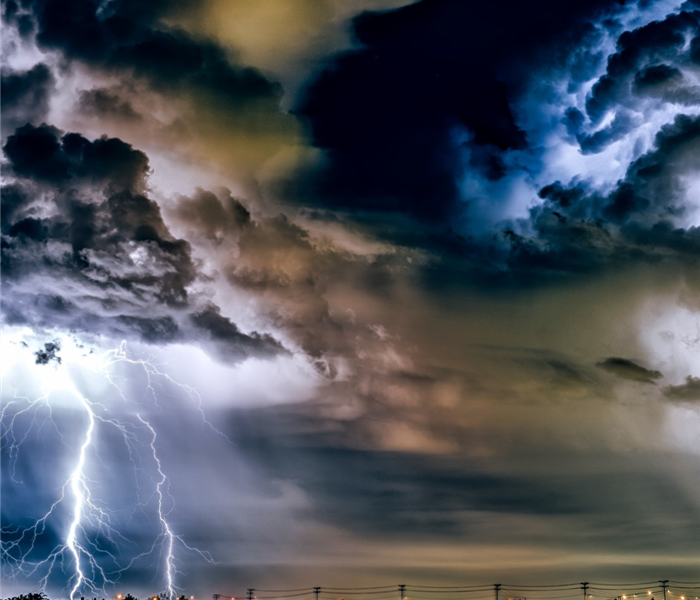 An image of lightning during a thunderstorm.
An image of lightning during a thunderstorm.
It is always important to keep up with what’s happening with the weather in your area. One of the biggest questions asked is, what is the difference between a severe thunderstorm watch and a severe thunderstorm warning? A severe thunderstorm watch is issued by the SPC (Storm Prediction Center) which means that there is potential for the development of thunderstorms that can produce large hail or damaging winds. When a severe thunderstorm is in progress or has developed and is shown on your local news radar it is called a severe thunderstorm warning.
SERVPRO of Raytown/East Kansas City is Missouri State licensed Certified Building Contractor, Mold Remediator, and Mold Assessor. We are IICRC (Institute of Inspection Cleaning and Restoration Certification) certified in Fire/Water/Mold clean-up & restoration. Call us at (816)-246-5566, we are always here to help.
Flood Categories
4/29/2022 (Permalink)
Floods can be categorized based on various factors, such as their cause, duration, severity, and impact. Here are some common categories used to classify floods:
Flash Floods: These floods are sudden, fast-moving, and can occur within minutes or hours of heavy rainfall or a dam/levee failure. They are particularly dangerous due to their rapid onset and can cause significant damage to infrastructure and property.
Riverine Floods: These floods occur when rivers or streams overflow their banks due to heavy rainfall or snowmelt. They can last for several days or weeks and can cause extensive damage to homes, businesses, and agricultural lands.
Coastal Floods: These floods occur when seawater inundates low-lying areas along the coast due to a storm surge or high tide. They can be very destructive, causing erosion, damage to buildings, and displacement of people.
Urban Floods: These floods occur when heavy rainfall overwhelms urban drainage systems and causes water to accumulate in streets, buildings, and other low-lying areas. They can be particularly hazardous for people and vehicles, and can cause significant property damage.
Dam or Levee Failure Floods: These floods occur when a dam or levee fails, causing water to rapidly inundate downstream areas. They can be extremely dangerous and destructive, and can cause loss of life and severe property damage.
Groundwater Floods: These floods occur when the groundwater table rises above the surface, typically due to prolonged rainfall or poor drainage. They can cause damage to basements, foundations, and other below-ground structures.
It's important to note that floods can fall into multiple categories and that their impacts can vary widely depending on local conditions and infrastructure.
Characteristics of a Category 3 Water Damage
4/21/2022 (Permalink)
Category 3 water damage, also known as black water damage, is the most severe type of water damage that can occur in a building. It is highly contaminated and poses a significant health risk to humans and animals. Here are some of the characteristics of Category 3 water damage:
Source: Category 3 water damage typically comes from sewage backups, toilet overflows, or floodwaters from rivers or streams. The water is highly contaminated with pathogens, bacteria, viruses, and other harmful microorganisms.
Color and odor: Category 3 water is typically dark in color and has a foul odor. It may contain sewage, chemicals, and other hazardous substances.
Damage extent: Category 3 water damage can cause extensive damage to building materials, including drywall, carpeting, insulation, and wood. It can also damage electrical systems, appliances, and other electronics.
Health risks: Exposure to Category 3 water can pose serious health risks, including bacterial infections, viral infections, and other illnesses. Anyone who comes into contact with this water should take precautions to protect themselves.
Cleanup and restoration: Cleaning up after Category 3 water damage requires special precautions and expertise. It is essential to remove all contaminated materials and sanitize the affected area thoroughly to prevent the spread of harmful microorganisms. Professional restoration services are often necessary to fully restore a building after Category 3 water damage.
Municipal Flood Prevention
4/21/2022 (Permalink)
Municipal flood prevention refers to the actions taken by local governments to prevent or mitigate the impact of flooding in urban areas. Floods can cause significant damage to buildings, infrastructure, and public safety, and can be particularly devastating in densely populated urban areas.
There are several measures that municipal governments can take to prevent flooding, including:
Constructing and maintaining stormwater drainage systems - this involves installing storm drains, culverts, and catch basins to channel rainwater away from buildings and streets and prevent flooding.
Building flood walls or levees - these structures can be constructed along rivers, streams, or coastlines to prevent water from overflowing and causing flooding.
Implementing zoning regulations - local governments can regulate the use of land in flood-prone areas to prevent development in these areas and limit the risk of flooding.
Creating green infrastructure - planting trees, constructing rain gardens, and using other green infrastructure techniques can help absorb and slow down stormwater runoff, reducing the risk of flooding.
Educating the public - municipalities can work to educate residents and businesses on flood risks and how to prepare for floods, including developing emergency plans and having adequate flood insurance.
Overall, municipal flood prevention is an important aspect of ensuring public safety and protecting infrastructure in urban areas.
Love What's Local
4/16/2022 (Permalink)
"Love What's Local" is a phrase that encourages people to support their local community and economy by choosing to buy products and services from local businesses. This idea is based on the belief that supporting local businesses can help to create a stronger and more vibrant community, while also helping to reduce environmental impact by reducing the need for transportation of goods.
By choosing to "Love What's Local," consumers can help to create a more sustainable and resilient local economy, as well as promoting a sense of community and connection with the people and places around them. This can include everything from buying produce from local farmers' markets to choosing a local coffee shop over a national chain.
Overall, "Love What's Local" is a call to action that encourages people to think about the impact of their purchasing decisions on their community and to prioritize local businesses and products whenever possible.
After a disaster or contamination of any kind, it is often helpful to employ a local restoration franchise. A SERVPRO franchise can manage problems of any size, respond quickly after disasters, and can provide the necessary tools and equipment needed for restoration. Call your local SERVPRO today!
Tasks Property Managers Should Do to Prepare for a Storm
4/16/2022 (Permalink)
As a property manager, there are several tasks you should take to prepare for a storm. Here are some steps you can take:
Create an emergency plan: Create an emergency plan that outlines what your team should do in the event of a storm. This plan should include evacuation procedures, emergency contacts, and a checklist of tasks that need to be completed before and after the storm.
Inspect the property: Inspect the property for any potential hazards, such as loose roof tiles, trees that could fall, or loose objects that could become projectiles in high winds. Address any hazards that you identify before the storm arrives.
Secure loose objects: Secure all outdoor furniture, signage, and other loose objects to prevent them from becoming dangerous projectiles in high winds.
Ensure proper drainage: Make sure that all drainage systems are clear and functioning properly. This will help prevent flooding and water damage.
Stock up on supplies: Stock up on supplies such as sandbags, emergency lighting, first aid kits, and non-perishable food items. You should also make sure that you have enough fuel for backup generators, if necessary.
Communicate with tenants: Keep your tenants informed about the storm and what to expect. Let them know what you are doing to prepare and what they can do to stay safe.
Stay informed: Stay up-to-date on the latest weather forecasts and warnings. This will help you make informed decisions about when to take action and how to keep your property safe.
Tips to Keep Mold Out of Your Bathroom
3/9/2022 (Permalink)
Mold is a common problem in bathrooms due to the combination of moisture and warmth. Here are some tips to keep mold out of your bathroom:
Ventilation: Install a good ventilation fan in your bathroom to remove the excess moisture after showering or bathing. Turn the fan on during your shower and leave it on for at least 30 minutes after you are done.
Wipe down surfaces: After showering, wipe down the walls, shower doors, and any other surfaces that are likely to accumulate moisture. This will help prevent mold from growing.
Fix leaks: If you have any leaks in your bathroom, fix them as soon as possible. Leaks can cause water to accumulate and create the perfect environment for mold to grow.
Use a squeegee: Use a squeegee to remove excess water from your shower walls and doors after each use. This will help prevent mold from growing.
Keep bathroom dry: Keep your bathroom as dry as possible. Use a towel to dry the floor after you shower, and keep any wet items, such as towels and bath mats, off the floor and hung up to dry.
Clean regularly: Regular cleaning can help prevent mold growth. Use a mold-killing cleaner, such as bleach or vinegar, to clean your bathroom at least once a week.
Use mold-resistant materials: If you are remodeling your bathroom, use mold-resistant materials such as mold-resistant drywall, paint, and caulk.
By following these tips, you can help prevent mold from growing in your bathroom and keep your space clean and healthy.
How Do Building Envelopes Work?
3/7/2022 (Permalink)
Building envelopes are the physical barriers that separate the indoor and outdoor environments of a building. They are designed to provide a range of functions, including insulation, air and moisture control, and protection from the elements.
The building envelope typically consists of several layers, each with its own specific function. The outermost layer is often the cladding, which is the visible exterior surface of the building. Cladding materials can vary widely and can include materials such as brick, stone, metal, or glass. The cladding provides protection against weather, as well as an aesthetic finish to the building.
Behind the cladding is the insulation layer, which is designed to reduce heat loss and gain through the building envelope. Insulation can be made from a variety of materials, such as fiberglass, foam, or cellulose, and is typically installed within the walls, floors, and roof of the building.
The air barrier layer is typically located behind the insulation layer and is designed to control the movement of air through the building envelope. It is typically made of airtight materials, such as plastic sheeting or spray foam, and is designed to prevent air leakage and reduce energy costs.
The vapor barrier layer is located on the warm side of the insulation and is designed to control the movement of moisture through the building envelope. It is typically made of plastic or foil and helps to prevent moisture from accumulating within the building envelope, which can lead to mold and structural damage.
Finally, the structural layer is the load-bearing layer of the building envelope that supports the weight of the building and distributes it to the foundation. This layer is typically made of materials such as wood, steel, or concrete, and is designed to withstand the forces of wind, snow, and seismic activity.
Together, these layers work to create a functional and energy-efficient building envelope that protects the building from the elements, while also providing a comfortable and healthy indoor environment.
Buying The Right Fire Extinguisher
2/24/2022 (Permalink)
Buying a fire extinguisher for your home in Kansas City, MO can be confusing. There are so many options available that it’s hard to know which will work best for your family. The two main items to consider include the classification and the size of the unit.
Classification of Extinguishers
Household extinguishers are available in three classifications, or some combination of these, as identified on the label. The classification indicates which type of fire can be extinguished.
A - This class identifies ordinary combustibles like cloth, wood, or paper.
B - Flammable liquids like cooking oil, gasoline, and grease are identified in this classification.
C - Live electricity is handled most effectively with this class of extinguisher.
Many household fire extinguishers are classified with all three designations (A:B: C), which means that they can combat all three types of fires. Most units also include an identifying number directly preceding the letters. The higher the number, the more effective it will be to combat each type of home fire.
Sizes of Extinguishers
There are several sizes of extinguishers. The larger the unit, the more powerful it is. If it’s too heavy to handle, however, it won’t be of much use.
10 pound - This size is most suitable for a home workshop or garage. A rechargeable unit with a hose will make it more user-friendly.
5 pound - This unit can be stored easily under the kitchen sink or in the laundry room. The rechargeable model is the smartest option.
2 pound - This small extinguisher will fit nicely inside your car. The disposable unit comes equipped with a mount so that it will stay firmly in place inside your trunk.
Stovetop - This option can be mounted on your stove range’s hood. Just remember not to place it over a deep fryer.
No matter which unit you choose, it is important to include fire extinguisher training as part of your family’s fire preparedness.
5 Tips to Take After a Toilet Overflow
2/17/2022 (Permalink)
If you’ve had issues with a toilet overflow you may have issues with sewer damage in your Raytown, MO, home. This can be a tricky mess to clean up as sewer waterfalls into the black water category and can require special equipment to ensure it is properly decontaminated. If you’re experiencing this problem here’s what you should do.
1. Call a Professional
One of the first things that should be done if you have a sewage problem in your home is to contact a local water damage restoration service to assess the damage and begin cleanup and repairs. These professionals can locate the source of the problem which may help determine if the sewage company needs to be contacted as well
2. Wear Proper Safety Gear
It's important to wear proper safety gear any time you are dealing with sewage material to avoid the spread of contaminated material. This includes gloves, coveralls, boots, and masks.
3. Remove the Water
Once the professionals have arrived and safety gear is in place the professionals can begin the sewer damage restoration. One of the first steps you may see performed is the removal of any floodwater and sewage materials.
4. Dry the Area
Once the water is removed it’s important to thoroughly dry the area. A dehumidifier may be used during this step.
5. Decontaminate the Area
After cleaning up a flooded toilet, it’s important to decontaminate the area to ensure that no bacteria remain. This is done to help ensure that the area is safe for use. The professionals overseeing your sewer cleanup may use special cleaners for this job.
When dealing with sewer damage it’s important to contact a professional as quickly as possible. They will have the correct equipment to perform the job safely and can remove the water without causing further contamination to your home. These professionals will also be able to dry and decontaminate the space.
What Happens to Your Belongings After A Disaster
2/10/2022 (Permalink)
Water and fire damage affect more than just the structure of your house, but also your belongings. SERVPRO of Raytown/East Kansas City understands that your home is more than a structure, it is your furniture, clothing, keepsakes, and other belongings that are important to you. Your belongings are important to us, which is why we provide the following to help restore and protect your belongings while we are restoring your home.
Move-Outs/Pack-Outs
If your home requires extensive restoration or cleaning, SERVPRO of Raytown/East Kansas City can conduct an organized, efficient move-out of the affected area. A move-out will provide several benefits, including the following:
- A quicker remodeling process
- Protecting items from potential damage
- Protecting contents from further on-site damage
Once restoration is completed, we will coordinate with you to move-in your items according to your needs. We also allow you to mark items of significant necessity in order to ensure those items are restored/cleaned faster so your life can return to normal. The services offered upon move-in may depend on your insurance coverage.
On-Site Storage
We have in-house storage where we can keep your belongings safe from further damage and can provide cleaning and restoration services for your belongings. We have four warehouses dedicated to storage where we can keep your items safe and secure. Your items will be placed in clearly identified and secured containers ready for your property once restored. You can rest assured that your items are being taken care of and handled with care.
Contents Claim Inventory Service
When an emergency strikes, the damage can often feel overwhelming. We can help ease the worry and confusion during the recovery process by offering our Contents Claim Inventory Service (CCIS), which provides a detailed and accurate list of your belongings. We take a room-by-room inventory of your contents, including digital photos, and in some instances, barcoding.
Our Contents Claim Inventory Service:
- Pre-loss list and value of contents
- A detailed and accurate report
- Better information to settle claims quicker
- Assistance with the burden of proof for claims
If your home and belongings need restoration services, rest assured that SERVPRO of Raytown/East Kansas City has you covered. We can pack out, store and restore your belongings. Give us a call today at 816-737-8776.
Important Facts About Mold Growth
1/19/2022 (Permalink)
It always pays to have a little bit of knowledge about certain subjects, and knowing a few facts about mold growth is a good idea. This information may help your business prevent the growth of mold, as well as help to rectify the situation if mold is found. Everyone should know these three facts about mold:
- Mold is a naturally occurring fungus that is found just about everywhere in small amounts
- Mold thrives in damp conditions of high humidity
- Mold can degrade indoor air quality and be an irritant or allergen to many people
A few other facts are relevant here. Mold often exudes a musty odor. Finally, mold spores are microscopic and can be spread throughout a building through the heating and cooling system.
Proven Steps for Mold Cleanup
When mold growth is discovered at your business in Lone Jack, MO, it should be looked into immediately. Calling in a mold mitigation team that is Faster to Any Size Disaster is the place to begin. Each situation is unique, but the process for mold remediation is similar in most respects. It begins with an inspection and damage assessment and looks for instances of water damage, which often paved the way for mold to grow in a commercial building. These initial measures are followed by mold containment and air filtration and then the removal and cleaning of materials affected by mold. The final stages include content cleaning and restoration.
Positive Results
It is essentially impossible to remove every last vestige of mold spores from a building. However, with the right techniques and equipment, mold growth can be stopped to the point where it does not pose a problem for employees and customers. The removal of mold colonies will also address the appearance of the workplace, and the musty odor will be gone, too. With a better understanding of mold, your company can deal with the issue effectively.
Safe Clean Up Of Water Leaking Into Light Fixtures
12/22/2021 (Permalink)
It is not uncommon to find water in light fixtures, or even ceiling damage following a winter with a heavy snow load, or a series of rainstorms. This damage may not always be a major problem, but could definitely develop into such if allowed to continue.
Leaks of this nature may come from a leaking flange around a chimney or vent on the roof which has developed a gap, infiltration by birds or squirrels, or from an aging roof. It may also come from an overhead pipe that is leaking due to settling, loosening of joints, or freezing temperatures. Finding and repairing the point where water is getting in is important and should be given priority attention.
How To Handle Cleanup
In order to prevent worsening damage from the water leaking in through the roof, immediate cleanup needs to take place.
The attic space should be inspected to see if the insulation has become saturated. Not only can that put an excess load on the ceiling, but it can also develop mold if left alone. It may need to be removed and replaced.
If the leak is from a pipe running above the ceiling, be sure to shut the water off as soon as possible to stop the leaking.
If you find water in light fixtures, shut off the electricity to all affected fixtures before attempting to inspect or replace it, and do not turn the electricity back on until certain all water has stopped leaking.
Get Professional Help
Call a water damage cleanup specialist to evaluate any ceiling damage and make a plan for repair. They can determine which materials need to be replaced, ensure that any mold is cleaned and removed, and restore your home to a safe condition.
If you do find water in light fixtures in your home, take it as a serious hint that some repair and cleanup is needed. This will help prevent a worse scenario and help you get your home restored to a safer and healthier condition.
How to Use Building Envelopes to Keep Your Property Dry
12/20/2021 (Permalink)
Rain damage can harm a commercial building in several ways. It creates an overflow of water, which may necessitate expensive flood cleanup. The water can destroy both the structure of a building and the contents inside it. Rain damage can also lead to a buildup of black mold.
Thankfully, there are ways to prevent major storm damage to your property. One common tactic is securing the building envelope. This envelope consists of the wall systems and the roof, and it has several functions. They include:
- Resisting the escape of cool or hot air
- Diverting water to the storm drains
- Protecting and supporting equipment
- Defending the building from snow or rain
Securing the Envelope
Water penetration is responsible for the majority of harm to buildings. Flood damage, in particular, can be costly. Worst of all, water does not need a lot of space to get inside a property. A hole as small as 0.005 inches is all it takes.
This hole can result from cracks in the plaster and brick that make up the walls. Poorly installed joints can cause gaps, as well. To limit the rain damage to your property, be sure to seal as many of these openings as possible.
Designing the Envelope
When building or remodeling the envelope for your property, you should take certain additional steps to keep the area secure. If possible, limit the number of protrusions you use. You should also avoid using too many different cladding materials. You may want to include rain screens and capillary breaks, as well.
There are backup systems you can install, too. You can utilize weep holes that drain excess water to the outside of the building. You can also use through-wall flashing to divert moisture to the exterior.
Proper maintenance of your commercial building envelope can prevent rain damage. However, if your property does sustain a leak, storm cleanup specialists can assist with the restoration process.
Three Reasons Why Your Toilet Is Leaking
12/15/2021 (Permalink)
A leaking toilet can be a major nuisance, especially when the underlying cause is unknown. If your home has a bathroom leak that goes untreated, the resulting damage can be costly. The following are three possible reasons why your toilet leaks with every flush.
1. Malfunctioning Wax Ring
A common cause of this type of leak is the failure of the wax seal underneath the toilet. When working properly, the wax ring functions as a barrier between the toilet and floor flange to keep water from seeping out. When this wax seal is malfunctioning, it could be that the wax has become dry over time and no longer functions as a barrier, or that the seal was improperly installed with the toilet.
2. Broken Tank Flange
Another potential cause of a leaking toilet is a broken tank flange. If the flange is not properly installed, it can shift out of place and crack under pressure. Because your toilet is a relatively high-traffic area of your home, even a small crack in a tank flange can quickly become a cause for concern and require replacement.
3. Loose Tank
Bathroom leaks that are not pooling on the floor near the base of the toilet can sometimes be traced back to the tank itself. If your toilet is leaking from the tank, but you see no obvious cracks or damage through which water might escape, your tank might just be loose. The connection between the tank and the rest of the toilet can become loose over time and will most likely cost less to repair than to replace entirely.
A leaking toilet can be a headache to deal with on your own. Hiring a professional specializing in water damage repair can help fix existing issues and minimize costly water damage in your bathroom to make it seem "Like it never even happened."
Be Safer With a Home Fire Extinguisher
11/24/2021 (Permalink)
Small incidental fires can begin at home for several reasons; a cigarette, a grease fire on the stovetop, or a lit candle or space heater left unattended. A small home fire can often be put out with a fire extinguisher, rather than calling the fire department in Raytown, MO. That, of course, depends on the size of the fire and the type of extinguisher you have.
Get the Right Extinguisher
Part of fire preparedness is knowing which kind of fire extinguisher is best for certain fires. Understanding the difference is of great importance, as some can do more harm than good. The following list explains the difference.
Type A – Suitable for everyday combustibles such as paper, fabric, and wood
Type B – Works best for fuels like gasoline, butane, and cooking oils
Type C – A most appropriate choice for electrical fires
Additional Information
Not only do extinguishers have different types, but they have other variations besides. Type A and B have a number before the letter to designate its effectiveness. A 4-A works better on a paper fire than a 2-A. If the unit has a C but no number ahead of it, it means it will not conduct electricity.
Which Extinguisher is Best?
The kind you decide to keep in your home depends on where you intend to keep it. You may decide you need more than one at hand for the greatest safety. For instance, you would do well to keep a type B in the kitchen where you are most likely to experience a grease fire. You might want to keep a type C near the breaker box and a type A near a home den, library, or craft room.
In the event, a larger blaze breaks out and you require more than a fire extinguisher, call 911 immediately. Then get help to assess the fire damage and manage fire cleanup, call the fire and water restoration service in Raytown, MO for help. They can handle the fire damage cleanup and help get things back to normal. Preparation can help you avoid a disaster, however, so keep a couple of extinguishers at hand.
The Top Five Places Where Mold Might Be Hiding
11/24/2021 (Permalink)
Top Five Places Where Mold Might Be Lurking
While you can call a remediation company, if you suspect a mold problem in your home, a team of professionals is not always immediately necessary. There are varying degrees of mold growth, from itemized occurrences to full-scale infestations. The best way to understand your current mold problem is to inspect your home and know the top five places where mold might be lurking.
- Behind walls
- Under flooring
- HVAC systems
- Beneath Sinks
- Mechanical Closet
Behind Walls
Mold exists in dark, damp spaces. Wall cavities provide an excellent environment for spores to thrive. While you might not expect a significant issue when you come across a small area of moldy drywall, know that when mold presents on the surface of a wall, it is likely well-developed behind as well.
Under Flooring
Similar to moldy walls, mold on wood floors typically suggests a more substantial issue beneath the floorboards. However, that doesn't only go for wood floors. Some flooring types exacerbate the problem because there are limited if any, visual clues. For example, linoleum flooring is nonporous, which means that mold cannot penetrate through to the surface.
HVAC Systems
Unfortunately, when mold growth occurs anywhere in the house, your HVAC system may have been infiltrated as well. Look for signs of discoloration of vent covers and a musty odor coming through as well.
Beneath Sinks
Another common space for mold to develop is underneath sinks. While these areas are not as hidden as some, homeowners typically store cleaners and supplies under sinks, making it difficult to discern whether there are minor leaks that could create an environment for spores to settle and multiply.
Mechanical Closet
Last, similar to cabinets under sinks, a home's mechanical closet - the area where the water heater is found - is also a prime location for mold development. These spaces are often humid and dark, and because they are not checked on regularly, leaks do occur, leading to the growth and reproduction of spores.
No homeowner wants mold growth developing in their home. Therefore, it is necessary to inspect your house vigilantly and to call for professional help when needed.
3 Tips for Recovering From Storm Damage
11/13/2021 (Permalink)
When a serious storm is in the forecast, the potential for property damage is always present. Do you know what to do in the wake of an extreme weather event? Here are some storm tips to minimize the destruction and get back to normal after a storm hits your property.
Types of Storm Damage
Storms can bring countless types of damage, from hail devastation to broken windows. Some of the most common and destructive forms of storm damage include:
- Wind destruction
- Flood problems
- Electrical issues from lightning strikes
Any of these types of damage can result in extensive property destruction and considerable expense, especially if you don’t know how to handle the aftermath.
Contact Your Insurer
It may seem obvious, but many homeowners wait too long to contact their insurance providers after a storm. Getting in touch with your insurer to describe the wreckage as soon as possible can help you get a claim filed quickly. It can also prevent taking any steps that could void a claim so make the call as soon as you can.
Take Pictures
When you fail to document affected items with images, you run the risk of underestimating just how much damage was done. So whether it’s on a camera or with your phone, taking pictures is one of the most important storm tips you can follow.
Secure Your Property
The only thing worse than sustaining damage in a storm is getting new damage on top of that. Invest in tarps to cover roof holes, board up broken windows with plywood or take any other steps necessary to prevent new wind or water damage from getting inside your home.
What you do after a storm can be just as important as what you do before it. Use these storm tips in the initial wake of a storm and contact the right insurance agent and water cleanup companies to get your property back in tip-top condition.
ERP's and Why They Are Important
8/19/2021 (Permalink)
Being a business owner can have many responsibilities, and you may have to take on multiple roles.
In most cases, disaster is the last thing you are thinking about, but every business owner, regardless of how new or old your business is, should have a plan and guide for what to do in the event of a disaster.
SERVPRO of Raytown/East Kansas City offers a free community service called the "Emergency Ready Plan", or an ERP.
ERP's are handy little guides that we make at SERVPRO that contain basic information regarding your property, who owns the property, and where your emergency shut-off locations are.
We document and photograph, where your electrical, water, and gas shut-offs, are, as well as your sprinkler system and security system. We also have the contacts for those utility companies in the event that you must make contact.
Key contacts are also listed in the ERP, such as the owner, the insurance agent for the property, the SERVPRO representative, and the managers of the building.
The emergency contacts and services page has the fire department and police department's emergency and non-emergency numbers as well, that way, if contact is needed, you know where to find all those phone numbers and contact points.
It's very beneficial to have an ERP because although the business owner might know where everything is and who to contact, your employees might not know. Having a guide like this can help so much if the business owner is not present.
ERP's are very convenient as well, we are able to provide a paper copy, and we can provide a digital version on the Ready Plan app! Which makes ERP's very easy to access in times of need.
When you run a business, it's good to prepare for not just the next day's shift, but for the things that happen unexpectedly.
SERVPRO of Raytown/East Kansas City is always here to help!
Flood Risks
8/3/2021 (Permalink)
If you’re in the process of buying a house or you’re looking for a new homeowners insurance policy, you might be familiar with what a flood zone is. If you don’t know what they are, you might want to start reading about them.
Zoning for Floods?
A flood zone is an area in a specific geographical space that the Federal Emergency Management Agency has determined has at least some risk of flooding. There are four primary types of zones, which correlate to the severity or category of excessive water events that can occur in that area.
- Moderate to Low-Risk Areas
- High-Risk Areas
- High Risk – Coastal Areas
- Undetermined Risk Areas
How to Find Your Zone
Each area’s zones are depicted on a community's Flood Insurance Rate Map, also known as FIRM, which can be found online at https://www.fema.gov/flood-insurance-rate-map-firm. You can also contact your local municipality or look on their website, most cities will have zoning information available online. You can try searching for the term “flood elevation certificate” for faster results.
Some people may think that these zones can only be found next to a large body of water or along a river or stream, but that’s not the case. Houses that are nowhere near a body of water can experience a flood if there’s a large rainstorm.
Emergency Preparedness
Knowing what kind of flood zone you live in can also be helpful for storage options and emergency preparedness. If you live in a high-risk zone, for example, you probably don’t want to put boxes directly on the floor, and you might want to increase the number of your emergency supplies.
If you weren’t aware that your home is potentially at risk for a flood, and a storm causes water-related damage, you should contact a storm damage specialist in your area to determine your best course of action and get the damage repaired as quickly as possible.
How To Reduce the Chance of a Kitchen Fire
7/29/2021 (Permalink)
Though fires can start in any area of the home, many fires often begin in kitchens, and kitchen fires can cause widespread damage to homes. Fortunately, there are various tips you can follow to help to reduce the chance of a kitchen fire occurring in your home.
1. Don't Leave Cooking Food Unattended
When cooking, it can be easy to become distracted. Though you may be tempted to leave your kitchen while cooking, however, this can result in a fire. Items left on a stovetop can burn and catch fire in a short period of time if high heat is used, and if you are out of the room when the fire begins, you may not be able to stop the fire from getting out of control. For these reasons, it's generally best to stay in the kitchen when cooking.
2. Clean Your Kitchen Often
When it comes to fire prevention tips, cleaning your kitchen can be beneficial. If grease has spilled on your stovetop or in your oven, or if you use a dirty, greasy pan, a fire can start quickly. A grease fire can be particularly dangerous because it can spread at an accelerated rate and cause major damage to your home. Cleaning your kitchen often, however, can reduce the likelihood of grease causing a fire.
3. Keep a Fire Extinguisher Nearby
Though a flame in a kitchen doesn't necessarily spell disaster if it is quickly extinguished, fires that aren't quickly controlled can cause devastation to homes. If a home has been affected by major fire damage, many homeowners find it helpful to contact emergency restoration services. However, the sooner you are able to extinguish a fire, the less likely it is that your home will sustain major damage. Having an ABC fire extinguisher (an extinguisher that can put out fires caused by trash, grease, or electricity) in your kitchen can be wise.
Since kitchen fires are incredibly common, knowing tips to prevent this type of fire can be useful to homeowners. Preventative methods can include remaining in your kitchen when cooking, frequently cleaning your kitchen, and keeping a fire extinguisher in your kitchen.
Five Methods to Quickly Extinguish a Fire
7/29/2021 (Permalink)
Oil can catch fire when cooking if frying food is left unattended, allowed to splatter, or heated to too high of a temperature. One of the most disastrous mistakes you can make when dealing with a grease fire is to try and use water to put out the flames as this will only make the fire spread. Instead, try any of the following five methods to quickly extinguish the fire before needing to call in the aid of the fire department and a fire cleanup company.
1. Turn Off the Heat
The first thing you should always do if grease catches fire while you are cooking is to turn off the heat. While you might be tempted to move the pot, leave it where it is.
2. Cover the Flames
If the fire is confined to a single pot or is only in a small area, covering it with an inflammable object like a metal lid can help put out the flames. Make sure not to use a glass lid that can shatter.
3. Baking Soda
If you have a large supply of baking soda on hand, dump as much as you can on the grease fire. The carbon dioxide released by baking soda helps to smother the fire.
4. Salt
Another effective way to put out a kitchen fire is to reach for the salt since it helps prevent the flames from accessing more oxygen. Typically, you require less salt to put out the fire than you need if using baking soda.
5.Fire Extinguisher
A fire extinguisher can be used as a last resort if you have one located nearby in your kitchen. Make sure to only use a Class B or K extinguisher to put out a fire caused by grease.
Experiencing a grease fire can be extremely frightening as the flames often spread quickly. Remember to put down the bucket of water and instead try one of these methods to safely extinguish the fire.
Is Your Business Prepared?
7/29/2021 (Permalink)
Up to 50% of businesses never reopen following a disaster. This usually happens because the amount of damage was too large and too expensive to recover from. Your business should be prepared to minimize the damage to your business so that doors can open back for business.
There are a few things you can do to make sure your establishment is ready.
Continuity Plan
A business that does reopen after a disaster must have a preparedness plan. You must identify the components of your business that are essential for it to continue running. Prepare a plan with the appropriate staff as well. Your staff must know who and what should happen in the case of an emergency.
Prepare your Emergency Plan
Have a plan in place. Letting SERVPRO prepare an Emergency Ready Plan (ERP) will help minimize the damage by having a quick response to an emergency. Knowing what and when to do will ensure that the right steps are taken. Something as simple as just knowing where the shutoff valves can save you from extensive water damage.
Review Your Insurance
Make sure you are familiar with your insurance. You need to know who to call when you need answers regarding your business. Understanding your policies will help you be able to know what is not covered and reassess if your needs require more coverage.
Cyber Security
The physical damages to your property but also internal damage to important files and data. Be sure to have all your data backed up.
The 3 Essentials of Water-Damage Protection for Your Business
7/17/2021 (Permalink)
Understanding the Three Essentials of Storm Preparedness
The right amount of water in the right place is life-sustaining. When too much water makes its way to the wrong place, it can endanger lives and property. Weather conditions that cause flooding are a primary contributor to commercial property damage. Understanding the three essentials of storm preparedness may help you avoid costly water damage restoration, due to a severe weather event.
Staff Preparation
Preparing your coworkers may prove essential if rising water becomes a reality. Consider the following measures.
Registering with an emergency notification service
Providing your staff with emergency preparedness training by a water emergency specialist
Posting building evacuation routes
Preparing an emergency kit with first aid, water, non-perishable food, flashlights, batteries, towels, and blankets
Choosing an emergency preparedness team leader
With your staff now prepared, you may want to bring your building into compliance with flood-safe practices.
Building Preparation
A few precautions can help you avoid costly water damage to your facility. Winterizing your irrigation backflow preventer in cold winters can prevent broken pipes. It may be useful to equip your sump pump with a battery backup that can allow the pump to run, even in a power outage. Regular cleaning of gutters and storm drains can prevent flood-favorable conditions from developing near your structure. With your staff and facility prepared, the third area to address is your financial protection.
Insurance Coverage
Because water-related damage can result in the destruction of irreplaceable items, insurance coverage is recommended. If your business is located in a high-risk area, you may have been required to purchase a separate flood insurance policy when you purchased the property. Even if your flood risk is low, you may still benefit from a policy that includes coverage for other common types of water damage, such as roof or pipe leaks.
Because water cleanup is generally a disruptive and costly process, you may ultimately be glad you devoted some time to prepare. Taking care of a few preventive measures could prove well worth the trouble by minimizing the impact on your valuable property and your bottom line.
4th of July Summer Safety Tips
7/17/2021 (Permalink)
The 4th of July is one of the best times of the year in Missouri. Many people get together to celebrate freedom, friends, and food. Unfortunately, the holiday can also be dangerous due to different risks that are present. When trying to stay safe during the holiday, there are a few important safety tips to follow to protect yourself from harm.
Handle Fireworks with Caution
To prevent injuries and fires that are caused by fireworks in the community, certain precautions should be taken. Never allow small children to get near fireworks or handle them. Adults should be the only ones lighting off the fireworks and should do so on the ground at a safe distance from trees or other objects. Keep a fire extinguisher close by and avoid lighting more than one firework at the same time.
Grill Safely
Grilling can also cause fires when you’re spending time flipping hamburgers and hot dogs outdoors. Look for leaks, holes, and cracks in the grill before you start using it on the 4th of July. Avoid grilling indoors or in an inclosed area. This can cause a fire to start and will lead to you to hire professionals such as SERVPRO of Raytown/East Kansas City to repair the damage. The grill should also be placed at least two feet away from the deck, branches, or the siding of the house.
Use a Pool Gate
Many people spend time in the pool cooling off from the warm temperatures in Missouri during the summer season. Keep it a safe activity by using a pool gate that will prevent children from getting into the water when they’re not supervised. Wireless outdoor sensors can also be installed to inform you if a child is near the pool. A first aid kit should also be on hand to tend to any injuries that can occur in the water. Kids should also use life jackets and floatation devices while swimming.
Practice Food Safety
Wash hands and clean the surfaces where you plan to prep food on the holiday. All meat should be cooked with a thermometer used to ensure that it reaches the right temperature to avoid food-borne illness. All leftovers should be refrigerated after two hours and not left outside. Toss out anything that sits outside for too long.
When trying to have a safe and memorable 4th of July, there are several safety practices to follow. With the right caution used, you can protect your family from harm and enjoy the day.
Why The Chemical Mercaptan Is a Lifesaver
7/17/2021 (Permalink)
The gas that heats many homes and provides energy for water heaters and clothes dryers is colorless and odorless. If it leaks from pipes or hoses it creates a dangerous situation due to its extreme combustibility. To make gas more detectable, engineers have added the chemical mercaptan, making it easily identifiable by its sulfurous, rotten egg smell. It is hard to estimate how many times a gas fire has been prevented by this chemical.
When a homeowner smells mercaptan it is a sure sign that somewhere in your home there is a gas leak. When this happens, immediate steps should be taken to shut off the gas or at least get people and pets out of the home and call the fire department.
The Best Actions To Take With a Natural Gas Leak
Specific actions can reduce the likelihood of a gas fire in a home or apartment. The goal is to stop the gas leak or increase the safety of everyone in the home. Here are the most effective actions to take:
Check all the appliances that use natural gas, beginning with the stove since this is the most likely source. Many times burners do not light, or go out, allowing gas to leak into the home. If you can find the source of the leak and stop it the emergency is over.
Increase the ventilation of your home by opening windows and doors. This enables the gas to dissipate and not collect in a certain area, reducing the likelihood of a gas explosion.
Don't use electrical devices, or even turn on lights, as this could ignite the gas.
Evacuate the home and call in the fire department
The Best Way To Handle Fire Damage
A gas fire in your home is likely to cause soot and smoke damage and loss of property. Call in a fire remediation team that will respond quickly and clean up the damage in a professional manner.
How Do Building Envelopes Work?
7/1/2021 (Permalink)
As a business owner in Unity Village, MO, you know how crucial it is to keep your building safe from all kinds of harm. One of the most dangerous risks that you may face is persistent rain damage. This threat can lead to various problems throughout your business, such as flooding and black mold. Fortunately, you can ensure that your company stays protected by establishing a secure envelope around your building. Here’s everything you need to know about how building envelopes work.
What Are Building Envelopes?
A building envelope refers to the construction and design of a building’s exterior that helps to repel the elements. There are numerous aspects of an envelope that allow it to do its job of keeping a building safe. Some of its most essential features include the following:
- Structural integrity
- Air pressure boundaries
- Temperature control
- Moisture control
Each of these elements plays a critical role in the effectiveness of a building’s envelope. It’s crucial to ensure that your envelope is shielded with these features so that it stays safe from rain damage.
The Importance of Building Envelopes
If you aim to keep your business protected from weather damage, the first place you should look is your building envelope. This structure acts as a major defense against rain, snow, hail, and various other types of water and air intrusion. Once a building’s envelope captures excess water, it sends the water to a drainage system, helping to prevent black mold from forming in your business. A strong envelope around your building also helps to regulate the transfer of heat in and out of your business, which ensures that your employees and customers stay comfortable all year long.
Rain damage can have a severe impact on your business, and strengthening your building’s envelope may help to deter some of the harm. If your company suffers any damage despite having a powerful building envelope, be sure to call commercial building restoration services so your building can make a full recovery.
How To Eliminate Mold in Ductwork
7/1/2021 (Permalink)
How To Eliminate Mold In Ductwork
High levels of moisture can cause mold to start growing inside HVAC ducts. Almost any type of mold, including black mold, can be supported by dust and debris inside of a heating and cooling system. Spores can spread throughout a structure through air ducts. If a musty odor is present or mold growth is evident, building owners or managers should take these three steps.
1. Locate the Source of Moisture
A building owner or manager should contact an HVAC specialist to identify the source of moisture and resolve the problem before scheduling a duct cleaning. Excessive moisture or mold growth may be evident in condensate drip pans, coils, or terminal units. It is also possible that a plumbing or roof leak is introducing water directly into the ductwork.
2. Clean the Air Ducts
A duct cleaning company can eliminate many types of mold. These services typically use high-powered vacuums to clean ducts. If black mold or signs of severe contamination are present, a property owner or manager may also want to consult with an indoor environmental professional. More extensive remediation work may be necessary if mold has spread beyond ducts.
3. Inhibit the Mold Growth
A duct cleaning company may also apply a mold inhibitor rated for HVAC use. This treatment can help to prevent mold from returning even if moisture levels increase. Property owners should keep moisture low by taking measures to prevent and quickly fix leaks, maintaining the HVAC system, and ensuring that indoor relative humidity levels remain between 30 percent and 50 percent.
These measures can help eliminate the presence of mold growth from ductwork and prevent fungus from returning. If black mold is found or there is a significant chance that mold has spread to other parts of a structure, a property owner or manager should also contact a mold cleanup and remediation company in Kansas City, MO.
SERVPRO Professionals are the Storm Damage Experts
6/16/2021 (Permalink)
Quick Response and High Standards Will Leave you Satisfied after Remediation
When heavy rains and high winds hit hard, property destruction and loss can be devastating to you as a homeowner. Structural damage to the exterior of your home is followed by interior devastation from water and winds. Storm damage is rarely isolated to just a few buildings in an area adding the challenge of finding a restoration company that can respond swiftly to your needs to an already anxiety-provoking situation. SERVPRO delivers the help you need swiftly even when a local disaster is widespread as we are able to call upon a network of over 1,650 franchises nationwide to respond if the need is great.
Storm damage can feel overwhelming, but your fear and panic will disappear when our team of professionals responds to your water, wind, and flooding repair and restoration needs. Your particular situation is of paramount importance to us, and you need not worry that your repairs and restoration will take a back seat even when many in your area are struggling to recover from the same issues you face. Choosing our company puts in motion a vast support system, but our local ownership means you will receive a personalized approach to your particular situation, efficiently returning your home back to its pre-storm condition just “Like it never even happened.”
Placing your trust in SERVPRO for your storm damage needs will reap benefits that less qualified companies simply cannot deliver. We use state-of-the-art equipment to clean, repair, and restore your home and in the process, we also restore your and your family’s peace of mind. Our technicians are highly trained and qualified. We also work closely with your insurance company, ensuring that all the work necessary is approved and compensated according to the terms of your policy. Our high standards and relentless drive to do the job on time while meeting local specifications means you and your family will quickly return to the quiet enjoyment of your house and neighborhood. We are not satisfied until you are happily back in your restored dwelling.
Once you make sure that your family is safe after a major storm, your first call should be to SERVPRO. Call 24/7 and begin the road to recovery by scheduling an inspection with our storm damage experts.
When Storms or Floods hit, SERVPRO is ready!
6/10/2021 (Permalink)
When Storms or Floods hit, SERVPRO is ready!
SERVPRO specializes in storm and flood damage restoration. Our crews are highly trained and we use specialized equipment to restore your property to its pre-storm condition.
Faster Response
Since we are locally owned and operated, we are able to respond quicker with the right resources, which is extremely important. A fast response lessens the damage, limits further damage, and reduces the restoration cost.
Resources to Handle Floods and Storms
When storms hit, we can scale our resources to handle a large storm or flooding disaster. We can access equipment and personnel from a network of 1,800 franchises across the country and elite Disaster Recovery Teams that are strategically located throughout the United States.
Have Storm or Flood Damage? Call Us Today 1(816)246-5566
Leading Causes of Fires - How to Avoid
6/10/2021 (Permalink)
Cooking is the leading cause of home fires & injuries in the U.S. Cooking fires often result from unattended cooking and human error, rather than mechanical failure of stoves or ovens. Although it is important to make sure your appliances are functioning properly and kept up to date, it is equally important to cook with caution and never get too comfortable in the kitchen.
Heating is the second leading cause of residential fires. However, heating fires are a larger problem in single family homes than in apartments. Unlike apartments, the heating systems in single family homes are often not professionally maintained. Make sure your heating systems are being professionally regulated during the colder seasons.
Although accidents happen, it is important to be prepared and alert in order to minimize these chances before they occur. Here are a few simple safety precautions to take to decrease the possibility of a fire.
- Keep flammables away from ignition sources.
- Utilize flammable storage cabinets.
- Know your chemical properties.
- Do not block fire extinguishers with equipment.
- Utilize those with electrical expertise/installations/assistance.
- Do not overload outlets - use a track plug.
- Practice good housekeeping techniques in the lab/office/work area.
- Inspect wires for possible damage and replace as needed.
Severe Thunderstorm Watch vs. Warning
5/12/2021 (Permalink)
It is always important to keep up with what’s happening with the weather in your area. One of the biggest questions asked is, what is the difference between a severe thunderstorm watch and a severe thunderstorm warning? A severe thunderstorm watch is issued by the SPC (Storm Prediction Center) and means that there is potential for the development of thunderstorms that can produce large hail or damaging winds. When a severe thunderstorm is in progress or has developed and is shown on your local news radar it is called a severe thunderstorm warning.
SERVPRO of Raytown/East Kansas City is Missouri State licensed Certified Building Contractor, Mold Remediator, and Mold Assessor. We are IICRC (Institute of Inspection Cleaning and Restoration Certification) certified in Fire/Water/Mold clean-up & restoration. Call us at (816)-737-8776, we are always here to help.
Flood Categories
4/29/2021 (Permalink)
Flood Categories
Floods are classified into three different categories. These categories can be easily spotted based on the various colors of the water. Floodwaters may be white/clear, gray, and black. Each category requires specific safety precautions and has different levels of mitigation and cleanout. It is crucial to understand the difference in categories to receive the proper assistance and avoid any further damage.
Category One:
White/clear water is the least expensive to remedy. The source is sanitary, meaning that there is no harmful bacteria or sewage present. While this category can be a relief, it is still necessary to act quickly to remove the water and repair the damage. If the water sits for too long, it can be contaminated by other items in the area, causing an elevation in category or classification.
Category Two:
If the water is found to be category two, or greywater, through pretesting, then it is best that you do not go near it. This result indicates that there are organic and inorganic substances in the water and that you may become ill if it is consumed or touched.
Category Three:
Blackwater is the most dangerous water. The level of contamination includes sewage, chemicals, bacteria, and possible toxins. It is likely that your insurance agent and company will recommend a disaster restoration specialist who will probably seal the space as they work to remove the water safely.
Municipal Flood Prevention
4/21/2021 (Permalink)
It is nearly impossible to control natural factors that lead to high water conditions, but many communities try to take steps to reduce the risk of flooding. Various methods of flood control are regularly practiced, such as
- Reforestation
- Levee, dam, and reservoir construction
- Floodwater diversion, including the use of floodways
Many of the modern methods used in urban and rural areas today have their roots in ancient flood prevention practices.
Sponge Cities
This method is commonly used in China and involves creating an urban environment where water can hold, clean, and then drain water naturally. This ecological approach involves using rainwater for daily living, such as irrigation gardens, flushing toilets, and recharging aquifers.
Flood Plains and Overflow Areas
Vast areas of open land around rivers play vital roles in water management and natural flood protection. Additionally, many city planners include "parks" at lower levels than the surrounding neighborhood. These overflow areas become ponds during storms or heavy rainfall and may save surrounding homes from water-filled basements.
Separate Systems for Storm and Wastewater
Many cities have taken an important step by running separate underground pipe systems for draining rainwater out of the sewer systems. This reduces the burden on wastewater treatment plans and improves the efficiency of functionality. Additionally, city workers take steps to keep sediment, debris, and other items out of the sewer system.
Sustainable Drainage
This refers to replacing non-permeable materials with permeable solutions. For example, a concrete walkway up to the front door won't absorb any water, concrete is non-permeable. However, a decorative stone walkway or a gravel path can absorb water. The more water is absorbed by the ground, the less risk of high water and can help stop flooding.
Flood prevention is a continued study that involves improved efforts. If you want tips on how you can help in prevention efforts before high water situations, talk to a flood remediation professional in your area.
Characteristics of a Category 3 Water Damage
4/21/2021 (Permalink)
Category 3 Water Damage
There are three different levels of damage when it comes to water damages. Category 3 damage is by far the worst. Experts have a way to categorize the different levels of water damage that can occur from floodwater. Category 3 isn’t something you want to ignore or even be around. Here are some traits of this type of water:
- Is contaminated with toxic or pathogenic agents
- Occurs due to backup sewers
- Carries feces, pesticides, or heavy metals
Water from this category is often called black water because of the materials found in it. This situation may not be because of a flaw in your building or home. Blackwater can come in due to sewage problems from the main city line. There are also cases where a toilet overflow could cause category 3 concerns.
If you notice black water at any time in your office or home, make sure you evacuate immediately. Identify where the water is located and how much area is affected. You should contact emergency services and your insurance company as well. Don’t go near the water, and don’t try to clean it up yourself. Instead, get in touch with a reputable commercial water damage restoration specialist. A professional crew will extract all the water with high-powered wet vacuums. Once all the water is gone, the team will dry the floor, walls, ceiling, and any other items. A technician will then, sanitize the space to ensure mold doesn’t grow and that there is no presence of harmful materials.
Category 3 flood water is nothing to take lightly. Follow these guidelines and let a seasoned professional take control.
4 Tasks Property Managers Should Do To Prepare for a Storm
4/16/2021 (Permalink)
Commercial property can't be completely ignored when inclement weather comes through, and business owners can't control all elements of storm preparedness, especially if they lease space. With that in mind, managers must take action, doing what they can to protect the assets. Here are four things they can do to help.
1. Establish Communication
Regular updates are important. People need to know if the area is safe or whether evacuation and boarding should occur. Furthermore, everyone should be on the same page about how to prepare for the storm and who has what responsibility. Therefore, property management should compile a list of everyone's phone numbers and email addresses. Send messages often, ensuring that everyone is aware of your progress.
2. Have a Plan
Well before a system appears, sit down and discuss the protocol for storm preparedness. Gather together and upload online important legal and financial documents: This includes contracts, mortgage papers, bank account numbers, and insurance policies. In addition, think ahead of whom to call in an emergency.
3. Prepare the Grounds
Once a watch is issued, property management should begin looking at the facility. Are the shingles loose on the roofs? If so, have them secured or covered. Does the pool area require attention? Have employees clear the deck of any furniture. Also, walk around. Trim tree branches, and pick up any loose debris. Eliminate objects that could be become projectiles from the high winds.
4. Record the Property
Before the gales hit, grab your phone and videotape the building. Make sure this has a timestamp, verifying for insurance that you did attend to the location. Should leaks or structural problems occur, this evidence may help expedite the approval for a storm restoration company's services.
Be proactive. Management companies should consider storm preparedness early, mapping out their tasks and establishing a strong line of contact. Protect the space. It's valuable to many.
Love What's Local
4/16/2021 (Permalink)
When a disaster occurs, working with a company that is local to the area can be useful for a variety of reasons. However, a small local company may only specialize in certain types of disaster responses, and also may not be able to tackle large restoration projects. Regardless of how much or what type of damage has occurred, a local restoration franchise that has been certified can appropriately respond to a disaster of any kind.
Though a corporation may have the experience necessary to respond to major damage, a company that isn’t locally owned may not understand the unique challenges that come with local landscapes. Additionally, a company that isn’t local is likely to have a slower response time, which can ultimately result in a building sustaining additional damage. However, a SERVPRO franchise that is local to a business owner’s area can mitigate the damage by responding quickly.
Often, a local franchise has a myriad of tools that other restoration companies may not have. We have partners that can quickly send the needed tools to the franchise. Additionally, your local SERVPRO is more likely to have spent time studying procedures and practices, meaning that professionals from a local franchise will have up-to-date information on how to best handle any situation.
After a disaster or contamination of any kind, it is often helpful to employ a local restoration franchise. A SERVPRO franchise can manage problems of any size, respond quickly after disasters, and can provide the necessary tools and equipment needed for restoration. Call your local SERVPRO today!
Tips to Keep Mold Out of Your Bathroom
3/9/2021 (Permalink)
Let’s face it, when it comes to parts of our homes we wish we didn’t have to think much about, the bathroom would probably top that list. For most of us, the bathroom is the one part of the house that we want to get away from, just as quickly as we entered. And as a cleaning and restoration company that often finds ourselves entering into some pretty serious bathroom maintenance concerns, we’ve found that mold damage is one of the worst issues to face. That’s why we wanted to share some worthwhile information with you so that the next time you’re cleaning your home or doing various housekeeping chores, you can have some helpful pointers in mind for keeping mold growth at bay in your bathroom.
"Bathrooms are common places to find mold because heat and moisture accumulate on a regular basis, and this happens to be the perfect environment that mold needs to grow." Some common reasons why mold growth is found especially in the bathroom are due to:
- Lack of air circulation and ventilation that traps moisture after bathing
- Leaky toilets, sinks, or pipes
- Improper installation of bathtub pan or shower building materials
- Other damp organic materials such as rugs, paper products, wood, wallpaper, drywall, etc…
There are several different methods you can follow to prevent mold growth.
- Make sure you have a bathroom fan that works and is the right size in relation to the size of your bathroom
- If you don’t have a bathroom fan or window, take some time to dry the wet surfaces (walls, mirror, and ceiling) with a towel after your shower. Squeegee your shower walls to get rid of extra moisture.
- Seal the grout in your tile annually to ensure it's waterproof. Repair or replace damaged grout and caulk.
- Leave bathroom windows and doors open after your shower to let all the steam out. We recommend doing this for at least a half-hour after bathing.
- Clean the bathroom with eco-friendly mold-preventing cleaners like Concrobium or Sporicidin. Also, general household cleaning solutions with bleach can be a great way to lessen the likelihood for mold to grow on dust, dirt, and buildup on surfaces.
- If you’re going out of town, don’t just turn your thermostat off. Keep it at 74 or below to prevent a mold fest.
- Check your sinks for leaks.
- Spread the shower curtain back out after your shower to prevent mold from growing in the folds.
- Clean the bathroom regularly, at least once a week. Don’t forget easy-to-miss places like the shower walls. Wash your cloth shower curtain and rug too!
- Call SERVPRO of Raytown/East Kansas City for additional tips and tricks for what to do (and NOT DO) if you have found mold growing in your bathroom.
How Do Building Envelopes Work?
3/7/2021 (Permalink)
As a business owner in Missouri, you know how crucial it is to keep your building safe from all kinds of harm. One of the most dangerous risks that you may face is persistent rain damage. This threat can lead to various problems throughout your business, such as flooding and black mold. Fortunately, you can ensure that your company stays protected by establishing a secure envelope around your building. Here’s everything you need to know about how building envelopes work.
What Are Building Envelopes?
A building envelope refers to the construction and design of a building’s exterior that helps to repel the elements. There are numerous aspects of an envelope that allow it to do its job of keeping a building safe. Some of its most essential features include the following:
- Structural integrity
- Air pressure boundaries
- Temperature control
- Moisture control
Each of these elements plays a critical role in the effectiveness of a building’s envelope. It’s crucial to ensure that your envelope is shielded with these features so that it stays safe from rain damage.
The Importance of Building Envelopes
If you aim to keep your business protected from weather damage, the first place you should look is your building envelope. This structure acts as a major defense against rain, snow, hail, and various other types of water and air intrusion. Once a building’s envelope captures excess water, it sends the water to a drainage system, helping to prevent black mold from forming in your business. A strong envelope around your building also helps to regulate the transfer of heat in and out of your business, which ensures that your employees and customers stay comfortable all year long.
Rain damage can have a severe impact on your business, and strengthening your building’s envelope may help to deter some of the harm. If your company suffers any damage despite having a powerful building envelope, be sure to call commercial building restoration services so your building can make a full recovery.
Buying the Right Fire Extinguisher
2/24/2021 (Permalink)
Buying a fire extinguisher for your home in Kansas City, MO can be confusing. There are so many options available that it’s hard to know which will work best for your family. The two main items to consider include the classification and the size of the unit.
Classification of Extinguishers
Household extinguishers are available in three classifications, or some combination of these, as identified on the label. The classification indicates which type of fire can be extinguished.
A - This class identifies ordinary combustibles like cloth, wood, or paper.
B - Flammable liquids like cooking oil, gasoline, and grease are identified in this classification.
C - Live electricity is handled most effectively with this class of extinguisher.
Many household fire extinguishers are classified with all three designations (A:B: C), which means that they can combat all three types of fires. Most units also include an identifying number directly preceding the letters. The higher the number, the more effective it will be to combat each type of home fire.
Sizes of Extinguishers
There are several sizes of extinguishers. The larger the unit, the more powerful it is. If it’s too heavy to handle, however, it won’t be of much use.
10 pound - This size is most suitable for a home workshop or garage. A rechargeable unit with a hose will make it more user-friendly.
5 pound - This unit can be stored easily under the kitchen sink or in the laundry room. The rechargeable model is the smartest option.
2 pound - This small extinguisher will fit nicely inside your car. The disposable unit comes equipped with a mount so that it will stay firmly in place inside your trunk.
Stovetop - This option can be mounted on your stove range’s hood. Just remember not to place it over a deep fryer.
No matter which unit you choose, it is important to include fire extinguisher training as part of your family’s fire preparedness.
5 Steps to Take After a Toilet Overflow
2/17/2021 (Permalink)
If you’ve had issues with a toilet overflow you may have issues with sewer damage in your Raytown, MO, home. This can be a tricky mess to clean up as sewer waterfalls into the black water category and can require special equipment to ensure it is properly decontaminated. If you’re experiencing this problem here’s what you should do.
1. Call a Professional
One of the first things that should be done if you have a sewage problem in your home is to contact a local water damage restoration service to assess the damage and begin cleanup and repairs. These professionals can locate the source of the problem which may help determine if the sewage company needs to be contacted as well
2. Wear Proper Safety Gear
It's important to wear proper safety gear any time you are dealing with sewage material to avoid the spread of contaminated material. This includes gloves, coveralls, boots, and masks.
3. Remove the Water
Once the professionals have arrived and safety gear is in place the professionals can begin the sewer damage restoration. One of the first steps you may see performed is the removal of any floodwater and sewage materials.
4. Dry the Area
Once the water is removed it’s important to thoroughly dry the area. A dehumidifier may be used during this step.
5.Decontaminate the Area
After cleaning up a flooded toilet, it’s important to decontaminate the area to ensure that no bacteria remain. This is done to help ensure that the area is safe for use. The professionals overseeing your sewer cleanup may use special cleaners for this job.
When dealing with sewer damage it’s important to contact a professional as quickly as possible. They will have the correct equipment to perform the job safely and can remove the water without causing further contamination to your home. These professionals will also be able to dry and decontaminate the space.
What Happens To Your Belongings After a Disaster?
2/7/2021 (Permalink)
Water and fire damage affect not only the structure of your house but also your belongings. SERVPRO of Raytown/East Kansas City understands that your home is more than a structure. Your furniture, clothing, keepsakes, and other belongings are important to you. Your belongings are important to us, which is why we provide the following to help restore and protect your belongings while we are restoring your home.
Move-Outs/Pack-Outs
If your home requires extensive restoration or cleaning, SERVPRO of Raytown/East Kansas City can conduct an organized, efficient move-out of the affected area. A move-out will provide several benefits, including the following:
- A quicker remodeling process
- Protecting items from potential damage
- Protecting contents from further on-site damage
When restoration is completed, we will work with you to coordinate the move-in according to your needs. The services offered upon move-in may depend on your insurance coverage.
On-Site Storage
We have in-house storage where we can keep your belongings safe from further damage, and can provide cleaning and restoration services for your belongings. We have four warehouses dedicated to storage where we can keep your items safe and secure. Your items will be placed in clearly identified and secured containers. You can rest assured that your items are being taken care of.
Contents Claim Inventory Service
When emergency strikes, the damage can often feel overwhelming. We can help ease the worry and confusion during the recovery process by offering our Contents Claim Inventory Service (CCIS), which provides a detailed and accurate list of your belongings. We take a room-by-room inventory of your contents, including digital photos, and in some instances, bar coding.
Our Contents Claim Inventory Service:
- Preloss list and value of contents
- Detailed and accurate report
- Better information to settle claims quicker
- Assistance with burden of proof for claims
If your home and belongings need restoration services, rest assured that SERVPRO of Raytown/East Kansas City has you covered. We can pack out, store and restore your belongings. Give us a call today at 816-737-8776.
Important Facts About Mold Growth
1/19/2021 (Permalink)
It always pays to have a little bit of knowledge about certain subjects, and knowing a few facts about mold growth is a good idea. This information may help your business prevent the growth of mold, as well as help to rectify the situation if mold is found. Everyone should know these three facts about mold:
- Mold is a naturally occurring fungus that is found just about everywhere in small amounts
- Mold thrives in damp conditions of high humidity
- Mold can degrade indoor air quality and be an irritant or allergen to many people
A few other facts are relevant here. Mold often exudes a musty odor. Finally, mold spores are microscopic and can be spread throughout a building through the heating and cooling system.
Proven Steps for Mold Cleanup
When mold growth is discovered in your business, it should be looked into immediately. Calling in a mold mitigation team that is Faster to Any Size Disaster is the place to begin. Each situation is unique, but the process for mold remediation is similar in most respects. It begins with an inspection and damage assessment and looks for instances of water damage, which often paved the way for mold to grow in a commercial building. These initial measures are followed by mold containment and air filtration and then the removal and cleaning of materials affected by mold. The final stages include content cleaning and restoration.
Positive Results
It is essentially impossible to remove every last vestige of mold spores from a building. However, with the right techniques and equipment, mold growth can be stopped to the point where it does not pose a problem for employees and customers. The removal of mold colonies will also address the appearance of the workplace, and the musty odor will be gone, too. With a better understanding of mold, your company can deal with the issue effectively.
Safe Cleanup if Water Leaking Into Light Fixtures
12/22/2020 (Permalink)
It is not uncommon to find water in light fixtures, or even ceiling damage following a winter with a heavy snow load, or a series of rainstorms. This damage may not always be a major problem, but could definitely develop into such if allowed to continue.
Leaks of this nature may come from a leaking flange around a chimney or vent on the roof which has developed a gap, infiltration by birds or squirrels, or from an aging roof. It may also come from an overhead pipe that is leaking due to settling, loosening of joints, or freezing temperatures. Finding and repairing the point where water is getting in is important and should be given priority attention.
How To Handle Cleanup
In order to prevent worsening damage from the water leaking in through the roof, immediate cleanup needs to take place.
The attic space should be inspected to see if the insulation has become saturated. Not only can that put an excess load on the ceiling, but it can also develop mold if left alone. It may need to be removed and replaced.
If the leak is from a pipe running above the ceiling, be sure to shut the water off as soon as possible to stop the leaking.
If you find water in light fixtures, shut off the electricity to all affected fixtures before attempting to inspect or replace it, and do not turn the electricity back on until certain all water has stopped leaking.
Get Professional Help
Call a water damage cleanup specialist to evaluate any ceiling damage and make a plan for repair. They can determine which materials need to be replaced, ensure that any mold is cleaned and removed, and restore your home to a safe condition.
If you do find water in light fixtures in your home, take it as a serious hint that some repair and cleanup is needed. This will help prevent a worse scenario and help you get your home restored to a safer and healthier condition.
How To Use Building Envelopes To Keep Your Property Dry
12/20/2020 (Permalink)
Rain damage can harm a commercial building in several ways. It creates an overflow of water, which may necessitate expensive flood cleanup. The water can destroy both the structure of a building and the contents inside it. Rain damage can also lead to a buildup of toxic black mold.
Thankfully, there are ways to prevent major storm damage to your property. One common tactic is securing the building envelope. This envelope consists of the wall systems and the roof, and it has several functions. They include:
- Resisting the escape of cool or hot air
- Diverting water to the storm drains
- Protecting and supporting equipment
- Defending the building from snow or rain
Securing the Envelope
Water penetration is responsible for the majority of harm to buildings. Flood damage, in particular, can be costly. Worst of all, water does not need a lot of space to get inside a property. A hole as small as 0.005 inches is all it takes.
This hole can result from cracks in the plaster and brick that make up the walls. Poorly installed joints can cause gaps, as well. To limit the rain damage to your property, be sure to seal as many of these openings as possible.
Designing the Envelope
When building or remodeling the envelope for your property, you should take certain additional steps to keep the area secure. If possible, limit the number of protrusions you use. You should also avoid using too many different cladding materials. You may want to include rain screens and capillary breaks, as well.
There are backup systems you can install, too. You can utilize weep holes that drain excess water to the outside of the building. You can also use through-wall flashing to divert moisture to the exterior.
Proper maintenance of your commercial building envelope can prevent rain damage. However, if your property does sustain a leak, storm cleanup specialists can assist with the restoration process.
Three Reasons Why Your Toilet is Leaking
12/15/2020 (Permalink)
A leaking toilet can be a major nuisance, especially when the underlying cause is unknown. If your home has a bathroom leak that goes untreated, the resulting damage can be costly. The following are three possible reasons why your toilet leaks with every flush.
1. Malfunctioning Wax Ring
A common cause of this type of leak is the failure of the wax seal underneath the toilet. When working properly, the wax ring functions as a barrier between the toilet and floor flange to keep water from seeping out. When this wax seal is malfunctioning, it could be that the wax has become dry over time and no longer functions as a barrier, or that the seal was improperly installed with the toilet.
2. Broken Tank Flange
Another potential cause of a leaking toilet is a broken tank flange. If the flange is not properly installed, it can shift out of place and crack under pressure. Because your toilet is a relatively high-traffic area of your home, even a small crack in a tank flange can quickly become a cause for concern and require replacement.
3. Loose Tank
Bathroom leaks that are not pooling on the floor near the base of the toilet can sometimes be traced back to the tank itself. If your toilet is leaking from the tank, but you see no obvious cracks or damage through which water might escape, your tank might just be loose. The connection between the tank and the rest of the toilet can become loose over time and will most likely cost less to repair than to replace entirely.
A leaking toilet can be a headache to deal with on your own. Hiring a professional specializing in water damage repair can help fix existing issues and minimize costly water damage in your bathroom to make it seem "Like it never even happened."
The Top Five Places Where Mold Might Be Hiding
11/24/2020 (Permalink)
Top Five Places Where Mold Might Be Lurking
While you can call a remediation company, if you suspect a mold problem in your home, a team of professionals is not always immediately necessary. There are varying degrees of mold growth, from itemized occurrences to full-scale infestations. The best way to understand your current mold problem is to inspect your home and know the top five places where mold might be lurking.
- Behind walls
- Under flooring
- HVAC systems
- Beneath Sinks
- Mechanical Closet
Behind Walls
Mold exists in dark, damp spaces. Wall cavities provide an excellent environment for spores to thrive. While you might not expect a significant issue when you come across a small area of moldy drywall, know that when mold presents on the surface of a wall, it is likely well-developed behind as well.
Under Flooring
Similar to moldy walls, mold on wood floors typically suggests a more substantial issue beneath the floorboards. However, that doesn't only go for wood floors. Some flooring types exacerbate the problem because there are limited, if any, visual clues. For example, linoleum flooring is nonporous, which means that mold cannot penetrate through to the surface.
HVAC Systems
Unfortunately, when mold growth occurs anywhere in the house, your HVAC system may have been infiltrated as well. Look for signs of discoloration of vent covers and a musty odor coming through as well.
Beneath Sinks
Another common space for mold to develop is underneath sinks. While these areas are not as hidden as some, homeowners typically store cleaners and supplies under sinks, making it difficult to discern whether there are minor leaks that could create an environment for spores to settle and multiply.
Mechanical Closet
Last, similar to cabinets under sinks, a homes mechanical closet - the area where the water heater is found - is also a prime location for mold development. These spaces are often humid and dark, and because they are not checked on regularly, leaks do occur, leading to growth and reproduction of spores.
No homeowner wants mold growth developing in their home. Therefore, it is necessary to inspect your house vigilantly and to call for professional help when needed.
Be Safer With a Home Fire Extinguisher
11/24/2020 (Permalink)
Small incidental fires can begin at home for several reasons; a cigarette, a grease fire on the stovetop, or a lit candle or space heater left unattended. A small home fire can often be put out with a fire extinguisher, rather than calling the fire department in Raytown, MO. That, of course depends on the size of the fire and the type of extinguisher you have.
Get the Right Extinguisher
Part of fire preparedness is knowing which kind of fire extinguisher is best for certain fires. Understanding the difference is of great importance, as some can do more harm than good. The following list explains the difference.
Type A – Suitable for everyday combustibles such as paper, fabric and wood
Type B – Works best for fuels like gasoline, butane and for cooking oils
Type C – Most appropriate choice for electrical fires
Additional Information
Not only do extinguisher have different types, but they have other variations besides. Type A and B have a number before the letter to designate its effectiveness. A 4-A works better on a paper fire than a 2-A. If the unit has a C but no number ahead of it, it means it will not conduct electricity.
Which Extinguisher is Best?
The kind you decide to keep in your home depends on where you intend to keep it. You may decide you need more than one at hand for the greatest safety. For instance, you would do well to keep a type B in the kitchen where you are most likely to experience a grease fire. You might want to keep a type C near the breaker box and a type A near a home den, library or craft room.
In the event a larger blaze breaks out and you require more than a fire extinguisher, call 911 immediately. Then get help to assess fire damage and manage fire cleanup, call the fire and water restoration service in Raytown, MO for help. They can handle the fire damage cleanup and help get things back to normal. Preparation can help you avoid a disaster however, so keep a couple extinguishers at hand.
3 Tips for Recovering From Storm Damage
11/13/2020 (Permalink)
When a serious storm is in the forecast, the potential for property damage is always present. Do you know what to do in the wake of an extreme weather event? Here are some storm tips to minimize the destruction and get back to normal after a storm hits your property.
Types of Storm Damage
Storms can bring countless types of damage, from hail devastation to broken windows. Some of the most common and destructive forms of storm damage include:
- Wind destruction
- Flood problems
- Electrical issues from lightning strikes
Any of these types of damage can result in extensive property destruction and considerable expense, especially if you don’t know how to handle the aftermath.
Contact Your Insurer
It may seem obvious, but many homeowners wait too long to contact their insurance providers after a storm. Getting in touch with your insurer to describe the wreckage as soon as possible can help you get a claim filed quickly. It can also prevent taking any steps that could void a claim so make the call as soon as you can.
Take Pictures
When you fail to document affected items with images, you run the risk of underestimating just how much damage was done. So whether it’s on a camera or with your phone, taking pictures is one of the most important storm tips you can follow.
Secure Your Property
The only thing worse than sustaining damage in a storm is getting new damage on top of that. Invest in tarps to cover roof holes, board up broken windows with plywood or take any other steps necessary to prevent new wind or water damage getting inside your home.
What you do after a storm can be just as important as what you do before it. Use these storm tips in the initial wake of a storm and contact the right insurance agent and water cleanup companies to get your property back in tip-top condition.
Expertise 2020 Award
8/20/2020 (Permalink)
Presented by Expertise is an award badge SERVPRO of Raytown/East Kansas City earned for being published in their 2020 release of the Best Water Damage Restoration Services in Kansas City.
Flood Risks
8/4/2020 (Permalink)
If you’re in the process of buying a house or you’re looking for a new home owners insurance policy, you might be familiar with what a flood zone is. If you don’t know what they are, you might want to start reading up on them.
Zoning for Floods?
A flood zone is an area in a specific geographical space that the Federal Emergency Management Agency has determined has at least some risk of flooding. There are four primary types of zones, which correlate to the severity or category of excessive water events that can occur in that area.
- Moderate to Low Risk Areas
- High Risk Areas
- High Risk – Coastal Areas
- Undetermined Risk Areas
How to Find Your Zone
Each area’s zones are depicted on a community's Flood Insurance Rate Map, also known as FIRM, which can be found online at https://www.fema.gov/flood-insurance-rate-map-firm. You can also contact your local municipality or look on their website, most of cities will have zoning information available online. You can try searching for the term “flood elevation certificate” for faster results.
Some people may think that these zones can only be found next to a large body of water or along a river or stream, but that’s not the case. Houses that are nowhere near a body of water can experience a flood if there’s a large rain storm.
Emergency Preparedness
Knowing what kind of flood zone you live in can also be helpful for storage options and emergency preparedness. If you live in a high-risk zone, for example, you probably don’t want to put boxes directly on the floor, and you might want to increase the number of your emergency supplies.
If you weren’t aware that your home is potentially at risk for a flood, and a storm causes water related damage, you should contact a storm damage specialist in your area to determine your best course of action and get the damage repaired as quickly as possible.
Firework Safety
7/30/2020 (Permalink)
A holiday weekend like the Fourth of July brings much fun, but can also lead to disaster if the right precautions are not taken. Here a few quick and helpful tips to stay safe and enjoy your holiday.
- Never hold lighted fireworks in your hands
- Never light fireworks indoors
- Keep fireworks away from houses and flammable material
- Never point or throw fireworks toward another person
- Only light one device at a time
- Maintain a safe distance after lighting a firework
Although sparklers are a simple and fun firework for kids to use, they can still be quite dangerous if not handled properly. Sparkles can quickly ignite clothing, and children have received severe burns from dropping sparklers on their feet. Sparkles are not advised to children under the age of five, unless accompanied by and adult. Consider using safer alternatives, such as glow sticks, confetti poppers, or colored streamers for children when trying to celebrate safely this Fourth of July!
Checking For Mold
7/30/2020 (Permalink)
Mold is not only detected visibly, but also through air sampling. Air sampling is used when mold may be in hidden spots. An industrial hygienist helps to get the most effective results when testing for mold. They are trained to know the ins and outs of how mold shows up in the air in your home. To get rid of mold, you must first recognize it. This involves air and surface samples. Industrial hygienists collect these samples to determine if mold is one of three kinds; allergenic, pathogenic, toxigenic, or even a mixture of all three. It is crucial in understanding the type of mold and level of infestations when mounting a good mold cleaning effort.
You may try to cut costs by using a home kit, but in the long run this may be a costly mistake. There are several ways those kits can be misleading. They often lack the sensitivity to detect specific concentrations of mold to determine where infestation is heaviest. If an area is too secluded, the kit may not detect airborne spores at all - or worse, may indicate a mold problem where none exists. This can result in mold remediation bills for an issue you never even had! If you suspect mold or have frank mold damage, tackle it the right way by contacting a mold cleaning company to check your home’s air and surfaces and get the mold out fast.
How to Reduce the Chance of a Kitchen Fire
7/28/2020 (Permalink)
Though fires can start in any area of the home, many fires often begin in kitchens, and kitchen fires can cause widespread damage to homes. Fortunately, there are various tips you can follow to help to reduce the chance of a kitchen fire occurring in your home.
1. Don't Leave Cooking Food Unattended
When cooking, it can be easy to become distracted. Though you may be tempted to leave your kitchen while cooking, however, this can result in a fire. Items left on a stovetop can burn and catch fire in a short period of time if high heat is used, and if you are out of the room when the fire begins, you may not be able to stop the fire from getting out of control. For these reasons, it's generally best to stay in the kitchen when cooking.
2. Clean Your Kitchen Often
When it comes to fire prevention tips, cleaning your kitchen can be beneficial. If grease has spilled on your stovetop or in your oven, or if you use a dirty, greasy pan, a fire can start quickly. A grease fire can be particularly dangerous because it can spread at an accelerated rate and cause major damage to your home. Cleaning your kitchen often, however, can reduce the likelihood of grease causing a fire.
3. Keep a Fire Extinguisher Nearby
Though a flame in a kitchen doesn't necessarily spell disaster if it is quickly extinguished, fires that aren't quickly controlled can cause devastation to homes. If a home has been affected by major fire damage, many homeowners find it helpful to contact emergency restoration services. However, the sooner you are able to extinguish a fire, the less likely that your home will sustain major damage. Having an ABC fire extinguisher (an extinguisher that can put out fires caused by trash, grease or electricity) in your kitchen can be wise.
Since kitchen fires are incredibly common, knowing tips to prevent this type of fire can be useful to homeowners. Preventative methods can include remaining in your kitchen when cooking, frequently cleaning your kitchen and keeping a fire extinguisher in your kitchen.
Five Methods to Quickly Extinguish a Fire
7/28/2020 (Permalink)
Oil can catch fire when cooking if frying food is left unattended, allowed to splatter, or heated to too high of a temperature. One of the most disastrous mistakes you can make when dealing with a grease fire is to try and use water to put out the flames as this will only make the fire spread. Instead, try any of the following five methods to quickly extinguish the fire before needing to call in the aid of the fire department and a fire cleanup company.
1. Turn Off the Heat
The first thing you should always do if grease catches fire while you are cooking is to turn off the heat. While you might be tempted to move the pot, leave it where it is.
2. Cover the Flames
If the fire is confined to a single pot or is only in a small area, covering it with an inflammable object like a metal lid can help put out the flames. Make sure not to use a glass lid that can shatter.
3. Baking Soda
If you have a large supply of baking soda on hand, dump as much as you can on the grease fire. The carbon dioxide released by baking soda helps to smother the fire.
4. Salt
Another effective way to put out a kitchen fire is to reach for the salt since it helps prevent the flames from accessing more oxygen. Typically, you require less salt to put out the fire than you need if using baking soda.
5.Fire Extinguisher
A fire extinguisher can be used as a last resort if you have one located nearby in your kitchen. Make sure to only use a Class B or K extinguisher to put out a fire caused by grease.
Experiencing a grease fire can be extremely frightening as the flames often spread quickly. Remember to put down the bucket of water and instead try one of these methods to safely extinguish the fire.
Is Your Business Prepared?
7/28/2020 (Permalink)
Up to 50% of businesses never reopen following a disaster. This usually happens because the amount of damage was too large and too expensive to recover from. Your business should be prepared to minimize the damage to your business so that doors can open back for business.
There are a few things you can do make sure your establishment is ready.
Continuity Plan
Business that do reopen after a disaster most had a preparedness plan. You must identify the components of your business that are essential for it to continue running. Prepare a plan with the appropriate staff as well. Your staff must know who and what should happen in the case of an emergency.
Prepare your Emergency Plan
Have a plan in place. Letting SERVPRO prepare an Emergency Ready Plan (ERP) will help minimize the damage by having a quick response to an emergency. Knowing what and when to do will ensure that the right steps are taken. Something as simple as just knowing where the shutoff valves can save you from extensive water damage.
Review Your Insurance
Make sure you are familiar with your insurance. You need to know who to call when you need answers regarding your business. Understanding your policies will help you be able know what is not covered and reassess if your needs require more coverage.
Cyber Security
The physical damages to your property but also internal damage to important files and data. Be sure to have all your data backed up.
The 3 Essentials of Water-Damage Protection for Your Business
7/14/2020 (Permalink)
Understanding the Three Essentials of Storm Preparedness
The right amount of water in the right place is life-sustaining. When too much water makes its way to the wrong place, it can endanger lives and property. Weather conditions that cause flooding are a primary contributor to commercial property damage. Understanding the three essentials of storm preparedness may help you avoid costly water damage restoration, due to a severe weather event.
Staff Preparation
Preparing your coworkers may prove essential if rising water becomes a reality. Consider the following measures.
Registering with an emergency notification service
Providing your staff with emergency preparedness training by a water emergency specialist
Posting building evacuation routes
Preparing an emergency kit with first aid, water, non-perishable food, flashlights, batteries, towels and blankets
Choosing an emergency preparedness team leader
With your staff now prepared, you may want to bring your building into compliance with flood-safe practices.
Building Preparation
A few precautions can help you avoid costly water damage to your facility. Winterizing your irrigation backflow preventer in cold winters can prevent broken pipes. It may be useful to equip your sump pump with a battery backup that can allow the pump to run, even in a power outage. Regular cleaning of gutters and storm drains can prevent flood-favorable conditions from developing near your structure. With your staff and facility prepared, the third area to address is your financial protection.
Insurance Coverage
Because water-related damage can result in destruction of irreplaceable items, insurance coverage is recommended. If your business is located in a high-risk area, you may have been required to purchase a separate flood insurance policy when you purchased the property. Even if your flood risk is low, you may still benefit from a policy that includes coverage for other common types of water damage, such as roof or pipe leaks.
Because water cleanup is generally a disruptive and costly process, you may ultimately be glad you devoted some time to preparation. Taking care of a few preventive measures could prove well worth the trouble by minimizing the impact on your valuable property and your bottom line.
How a Mitigation Company Can Help Rebuild Your Business
6/30/2020 (Permalink)
When you’re facing fire damage in your business, it can be overwhelming to think about how to begin the rebuilding process. However, consulting a professional fire mitigation company can help to alleviate the destruction caused by the fire incident. If you’re ready to call for help and begin restoring your business, this guide gives you an overview of the mitigation process.
Assessing the Situation
When mitigation professionals arrive at your business, they assess the damage that your building has sustained in the aftermath of the fire. Some of the forms of damage that they inspect may include:
- Smoke damage
- Soot damage
- Water damage (from firefighting efforts)
These types of harm may be present in addition to fire damage caused by direct contact with flames. Professionals can help you determine what the degree of destruction is in your business.
Protecting Against Additional Harm
Examining the extent of damage to your commercial building allows mitigation specialists to prevent further harm from taking place. If your building has any missing walls or windows, professionals can board up these surfaces. They may also place tarps on the roof if it has been damaged as well. Moreover, having your business protected from additional damage can help when an insurance adjuster visits to inspect the state of your building.
Cleaning and Restoration
Finally, fire mitigation professionals clean any damaged items in your building and work on restoring your business. The steps in this process depend on the extent of damage that you are experiencing. If there are any signs of water damage, restoration specialists can remove and dry excess water. Likewise, they may clean any surfaces in your building that contain traces of soot or smoke.
Whether the restoration process involves minor repairs or a full reconstruction, mitigation professionals can improve the condition of your business. Be sure to call a specialist immediately to help you rebuild, no matter what type of fire damage you’re facing.
Forgotten Causes of Commercial Water Damage
6/30/2020 (Permalink)
Business owners usually think commercial water damage is caused by floods, massive rains, and storms. That’s often true. Weather events, storms, and flooding do shut down businesses and create major water damage in commercial buildings. Unfortunately, many business owners, commercial space renters, and entrepreneurs don’t think about and try to prevent other typical causes of water damage.
1. Sprinkler systems
Some older office and retail buildings have outdated sprinkler systems that work in conjunction with fire protection systems. While sprinklers can come in handy during a fire emergency, they can also cause commercial flood damage if they are faulty, not well maintained, or in need of replacement. Many a time a poor sprinkler system has damaged commercial inventory and business assets and shut down business. Check your system to make sure that it’s not faulty or in need of repair or replacement.
2. Appliances and equipment
Restaurants and catering businesses sometimes suffer water damage from their appliances or equipment. But any business that has appliances or equipment that use water could suffer water damage. If an appliance fails and spews water across your commercial building, especially during late hours when no one is around, you may come back to work and face a water damage emergency.
3. Pipes and plumbing
Just like in a residential home, the plumbing system in a commercial business can fail. A broken pipe or faulty plumbing can result in major water damage in just a few hours.
4. Sewer lines
Sewer backups are another cause of commercial water damage that often catches business owners by surprise. Should the sewer line to your building back up or become damaged, realize the potential dangers of contaminated black water which can cause health issues and ruin products and office furnishings.
5. Water Heaters
Water heaters in commercial buildings can crack or lose their seal because of high pressure. You want to make sure and follow the manufacturers guidelines and flush your water heater regularly to make sure it is working properly.
6. Roofing
One of the more obvious ways commercial buildings suffer water damage is through an old or leaky roof. Inspect the roof frequently (at least every six months) to make sure it does not need to be reseal and to be sure it drains properly. Even small leaks should be fixed immediately.
Mold in the Building? Take These Steps Immediately
6/25/2020 (Permalink)
You go about your business each day at work focused on the tasks at hand. You probably give little thought to issues such as mold cleanup and fungal growth. However, if you come across this concern, it could cause great alarm for you and everyone in your workplace. On the bright side, there are some effective actions you can take when you discover this nasty substance.
Don’t Delay
The second you discover mold spores in your building, take appropriate action. Don’t shrug it off or procrastinate. This could only make matters worse and result in bigger concerns. Here are some essential steps:
- Get in touch with the building manager.
- Take some pictures.
- Call a professional mold cleanup company.
- Contact your commercial building insurance company.
Inform the Property Manager
It’s important that you speak with the building manager about the situation so he or she can take necessary steps to prevent further mold contamination. The building manager will apprise other tenants of the situation.
Take Photos
This is an important step when you speak with a cleanup team and with your insurance agent. You want to document the extent of the damage and what type of mold is present in your office.
Call the Pros
This might be the most crucial step in the process. Mold cleanup isn’t something you should handle on your own. There are trained, capable professionals who have the equipment to thoroughly dispose of the mold in your building. The team will also clean and sanitize the area so you can rest easy knowing all the mold is gone.
Speak With the Insurance Provider
Your insurance plan may have provisions where it covers mold and all cleanup and restoration efforts. Discuss your concerns with your insurance agent and ensure that you understand your policy completely.
Quick action and mold cleanup is essential when you find mold at work. Get a professional crew on the job, and you should be in good shape.
SERVPRO Storm Response
6/16/2020 (Permalink)
When it comes to fire & water damage, or specialty cleanup needs, it's SERVPRO brand that comes to mind. Our TEAMS work endlessly to make sure our customers are happy, and have one objective in the aftermath of disaster, to make their loss "Like it never even happened."
No matter the job size, our SERVPRO teams are ready to handle any size loss. With 1,700+ franchises nationwide, we have access to numerous highly trained personnel and thousands of pieces of equipment. Our SERVPRO Disaster Recovery teams are strategically placed throughout the country to respond when needed. Our Teams have a proven track record for success, assisting with cleanup of floods, tornadoes, wildfires, and damage caused from frigid temperatures.
Whether it’s a major storm event, or faulty appliance, we will be there with one call.
What You Need To Know About Black Water
6/11/2020 (Permalink)
If your home has experienced serious flooding, you’re probably facing extensive water damage. Flood water is considered black water, which means you will need to call in experienced remediation specialists who understand the best practices for restoration to handle the cleanup. This is because black water poses a serious threat.
What Is Black Water?
During a flood, sewers and toilets can overflow, pipes can burst and flood waters can pick up any number of contaminants as they flow through an area. This contamination with feces, urine and other dangerous pollutants are what make flood water “black.” Any stagnant water that has been around long enough to support the growth of harmful bacterial is also considered black.
Why Is It Dangerous?
Contaminated flood water carries dangerous bacteria that can cause humans and animals to become sick. This can occur from accidentally swallowing water or having it come into contact with small wounds or scratches. This includes the flood water saturating possessions after the bulk of the flooding has receded, which is why you should not attempt your own water damage cleanup. Diseases that can be caused by black water include the following:
• Hepatitis
• Gastroenteritis
• Giardia
• Campylobacteriosis
• Typhoid
• Cholera
What Should You Do About It?
Because flood water is considered black water, you shouldn’t attempt to clean your own home after a serious flood. Contact a professional remediation service to handle it for you. After its representatives have assessed the situation, they will begin the process of extracting the remaining water, disinfecting your home and drying it out with industrial equipment. It’s critical this process happens quickly to avoid irreversible damage and mold growth.
When you’re facing water damage after a flood, don’t endanger your family’s health by trying to clean it up yourself. Hire a trained professional who has the knowledge and specialized equipment to handle the damage safely and effectively.
When Storms or Floods hit, SERVPRO is ready!
6/2/2020 (Permalink)
When Storms or Floods hit, SERVPRO is ready!
SERVPRO specializes in storm and flood damage restoration. Our crews are highly trained and we use specialized equipment to restore your property to its pre-storm condition.
Faster Response
Since we are locally owned and operated, we are able to respond quicker with the right resources, which is extremely important. A fast response lessens the damage, limits further damage, and reduces the restoration cost.
Resources to Handle Floods and Storms
When storms hit, we can scale our resources to handle a large storm or flooding disaster. We can access equipment and personnel from a network of 1,800 franchises across the country and elite Disaster Recovery Teams that are strategically located throughout the United States.
Have Storm or Flood Damage? Call Us Today 1(816)737-8776
Leading Causes of Fires - How to Avoid
5/19/2020 (Permalink)
Cooking is the leading cause of home fires & injuries in the U.S. Cooking fires often result from unattended cooking and human error, rather than mechanical failure of stoves or ovens. Although it is important to make sure your appliances are functioning properly and kept up to date, it is equally important to cook with caution and never get too comfortable in the kitchen.
Heating is the second leading cause of residential fires. However, heating fires are a larger problem in single family homes than in apartments. Unlike apartments, the heating systems in single family homes are often not professionally maintained. Make sure your heating systems are being professionally regulated during the colder seasons.
Although accidents happen, it is important to be prepared and alert in order to minimize these chances before they occur. Here are a few simple safety precautions to take to decrease the possibility of a fire.
- Keep flammables away from ignition sources.
- Utilize flammable storage cabinets.
- Know your chemical properties.
- Do not block fire extinguishers with equipment.
- Utilize those with electrical expertise/installations/assistance.
- Do not overload outlets - use a track plug.
- Practice good housekeeping techniques in the lab/office/work area.
- Inspect wires for possible damage and replace as needed.
How To Clean Your Building After a Toilet Flood
5/14/2020 (Permalink)
There may not be much that is nastier to deal with than a sewer backup, and your business plan may not include the budget for a sewer cleanup, so, it might be worth looking into flood insurance. Nonetheless, problems can occur and the unexpected can happen, throwing a wrench into the works. Differing from a category 1 or clean water flood, a flooded toilet carries serious contaminants that must be properly dealt with.
How Do You Clean Up Sewer Water
If the water is running clear, stops upon shutoff and is confined to a non-porous bathroom floor, you may be able to mop it up and clean it with detergent and chlorine bleach. If the water has any color to it, is coming from deeper in the drain or is spilling out onto carpeted areas, down a heat duct or is deep enough to be standing you will likely need assistance from a professional sewage cleanup service.
Remove everyone from the area to avoid exposure
Find the water shutoff valve and turn the flow off, if possible
If the water is not running mostly clear, it may be coming from the sewer rather than the supply line
Water must be extracted and cleaned up
Sanitizing and disinfecting must be thoroughly done as sewage can be considered a biohazard
Cleaning and Disinfecting
The sewer line may need to be cleared professionally to unblock the drain. A sewer cleanup service may be necessary to help with that as well as the cleanup. Sewage water is likely to contain bacteria and viruses and it is critical to contain the spill and begin professional a sanitizing process as soon as possible, using industrial disinfectants. Every nook and cranny needs attention. Any rugs, carpets or soft surfaces will likely need to be disposed of.
Employ preventative measures such as regular drain and supply line inspections and enzyme treatments to reduce the risk of flooding. When prevention fails and the need for sewer cleanup occurs, take it seriously to ensure proper restoration.
Cleaning Under Your Home After A Flood
5/12/2020 (Permalink)
Under Home Cleaning - After Flooding
Many homeowners are eager to begin cleaning their homes after a flood although, few people realize that the area underneath houses often need to be cleaned after a flood. Here are a few helpful things to know about cleaning crawlspaces after a flood.
Though damage in a crawlspace may not be immediately apparent, identifying damage in a timely manner is often important. The following are common indicators that a crawlspace has been affected by a storm:
- An unpleasant, musty odor in areas above and around the crawlspace due to mold growth
- Damaged subfloors or warped vinyl floors
- High levels of humidity in rooms above the crawlspace
A home flood can cause major damage to both the interior and exterior of a home, and though crawlspaces are often overlooked, they are still prone to damage. When water quickly accumulates under a house it is not removed or drained, the structure of the house can be affected. Crawlspace damage can also occur if there are high levels of humidity in the area. This can cause building materials to absorb the moisture and weaken.
Thankfully there are steps that storm damage restoration company professionals take to clean your home’s crawlspace. First, water is removed from the crawlspace. If mold and high levels of humidity remain present after all the water is extracted, professionals may create negative air pressure in the area to dry it up. Once the area is dry, professionals may restore or replace any materials that have been damaged.
Though floods can wreak havoc on your home, it is important to understand the cleaning steps to take after, to prevent any future issues. Knowing the signs of a damaged crawlspace, common causes of damage and how the underside of your house is cleaned can make the clean up process much simpler.
Possible Reasons Your Toilet May Be Leaking
5/5/2020 (Permalink)
Do You Notice Water Every Time You Flush?
You may have a leaking toilet. A buildup of standing water in your bathroom could lead to water damage, mold or mildew, so it’s best to find the source of the problem as soon as possible- especially in Kansas City, MO. As a complex system, there are multiple reasons this could be happening. Toilets are an everyday necessity, so be sure to take the proper measures to get it back in working order.
Diagnose the Problem
First you need to figure out where the water is leaking from. Clean up as much of the water as you can on both the floor and the toilet itself, so that you can follow the water as it builds again. Try flushing the leaking toilet to jumpstart the process. Usually the water seeps out below the toilet, which will be addressed below, but during this process more unusual causes may present themselves, such as a:
- Damaged toilet tank
- Valve that does not completely close
- Sweaty bowl
- Supply tube that is wobbly or movable
Tighten Up
Water pooling beneath your leaking toilet may be the result of floor bolts that hold the toilet in place becoming loose. Simply remove the protective covers and tighten each one with a wrench. Be sure not to make them too tight, or you could damage the toilet. You should visibly notice the leak stop. If not, there may be a deeper issue.
Wax Gasket
If tightening bolts did not stop your water flow, that probably means that the wax seal on your gasket is dry or cracked. Luckily, it is replaceable. Be sure to shut off the water and drain the toilet before beginning the process. Next, disconnect the water-supply tube and lift the toilet from the floor. You will need to scrape off the old wax before installing the new wax gasket.
Leaking bathrooms are no fun, but that does not mean they should be ignored. Diagnosing the problem is half the job. Feel free to reach out to a professional.
Flood Categories
4/28/2020 (Permalink)
Flood Categories
Floods are classified into three different categories. These categories can be easily spotted based on the various colors of the water. Floodwaters may be white/clear, gray, and black. Each category requires specific safety precautions and have different levels of mitigation and clean out. It is crucial to understand the difference in categories to receive the proper assistance and avoid any further damage.
Category One:
White/clear water is the least expensive to remedy. The source is sanitary, meaning that there is no harmful bacteria or sewage present. While this category can be a relief, it is still necessary to act quickly to remove the water and repair the damage. If the water sits for too long, it can be contaminated by other items in the area, causing an elevation in category or classification.
Category Two:
If the water is found to be category two, or grey water, through pretesting, then it is best that you do not go near it. This result indicates that there are organic and inorganic substances in the water and that you may become ill if it is consumed or touched.
Category Three:
Black water, is the most dangerous water. The level of contamination includes sewage, chemicals, bacteria and possible toxins. It is likely that your insurance agent and company will recommend a disaster restoration specialist who will probably seal the space as they work to remove the water safely.
Characteristics of a Category 3 Water Damage
4/21/2020 (Permalink)
Category 3 Water Damage
There are three different levels of damage when it comes to water damages. Category 3 damage is by far the worst. Experts have a way to categorize the different levels of water damage that can occur from flood water. Category 3 isn’t something you want to ignore or even be around. Here are some traits of this type of water:
- Is contaminated with toxic or pathogenic agents
- Occurs due to back-up sewers
- Carries feces, pesticides or heavy metals
Water from this category is often called black water because of materials found in it. This situation may not be because of a flaw in your building or home. Black water can come in due to sewage problems from the main city line. There are also cases where a toilet overflow could cause category 3 concerns.
If you notice black water at any time in your office or home, make sure you evacuate immediately. Identify where the water is located and how much area is affected. You should contact emergency services and your insurance company as well. Don’t go near the water, and don’t try to clean it up yourself. Instead, get in touch with a reputable commercial water damage restoration specialist. A professional crew will extract all the water with high-powered wet vacuums. Once all the water is gone, the team will dry the floor, walls, ceiling and any other items. A technician will then, sanitize the space to ensure mold doesn’t grow and that there is no presence of harmful materials.
Category 3 flood water is nothing to take lightly. Follow these guidelines and let a seasoned professional take control.
Municipal Flood Prevention
4/16/2020 (Permalink)
It is nearly impossible to control natural factors that lead to high water conditions, but many communities try to take steps to reduce the risk of flooding. Various methods of flood control are regularly practiced, such as
- Reforestation
- Levee, dam, and reservoir construction
- Floodwater diversion, including the use of floodways
Many of the modern methods used in urban and rural areas today have their roots in ancient flood prevention practices.
Sponge Cities
This method is commonly used in China and involves creating an urban environment where water can hold, clean, and then drain water naturally. This ecological approach involves using rainwater for daily living, such as irrigation gardens, flushing toilets, and recharging aquifers.
Flood Plains and Overflow Areas
Vast areas of open land around rivers play vital roles in water management and natural flood protection. Additionally, many city planners include "parks" at lower levels than the surrounding neighborhood. These overflow areas become ponds during storms or heavy rainfall and may save surrounding homes from water-filled basements.
Separate Systems for Storm and Wastewater
Many cities have taken an important step by running separate underground pipe systems for draining rainwater out of the sewer systems. This reduces the burden on wastewater treatment plans and improves the efficiency of functionality. Additionally, city workers take steps to keep sediment, debris, and other items out of the sewer system.
Sustainable Drainage
This refers to replacing non-permeable materials with permeable solutions. For example, a concrete walkway up to the front door won't absorb any water, concrete is non-permeable. However, a decorative stone walkway or a gravel path can absorb water. The more water is absorbed by the ground, the less risk of high water and can help stop flooding.
Flood prevention is a continued study that involves improved efforts. If you want tips on how you can help in prevention efforts before high water situations, talk to a flood remediation professional in your area.
Tips to Keep Mold Out of Your Bathroom
3/7/2020 (Permalink)
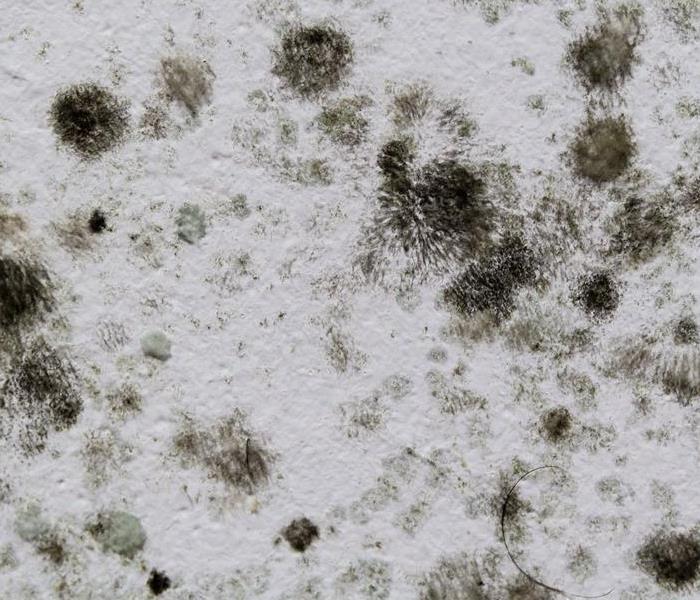 Call SERVPRO of Raytown/East Kansas if you find mold growing in your bathroom.
Call SERVPRO of Raytown/East Kansas if you find mold growing in your bathroom.
Let’s face it, when it comes to parts of our homes we wish we didn’t have to think much about, the bathroom would probably top that list. For most of us, the bathroom is the one part of the house that we want to get away from, just as quickly as we entered. And as a cleaning and restoration company who often finds ourselves entering into some pretty serious bathroom maintenance concerns, we’ve found that mold damage is one of the worst issues to face. That’s why we wanted to share some worthwhile information with you so that the next time you’re cleaning your home or doing various housekeeping chores, you can have some helpful pointers in mind for keeping mold growth at bay in your bathroom.
"Bathrooms are common places to find mold because heat and moisture accumulate on a regular basis, and this happens to be the perfect environment that mold needs to grow." Some common reasons why mold growth is found especially in the bathroom are due to:
- Lack of air circulation and ventilation that traps moisture after bathing
- Leaky toilets, sinks or pipes
- Improper installation of bathtub pan or shower building materials
- Other damp organic materials such as rugs, paper products, wood, wallpaper, drywall, etc…
There are several different methods you can follow to prevent mold growth.
- Make sure you have a bathroom fan that works and is the right size in relation to the size of your bathroom
- If you don’t have a bathroom fan or window, take some time to dry the wet surfaces (walls, mirror, and ceiling) with a towel after your shower. Squeegee your shower walls to get rid of extra moisture.
- Seal the grout in your tile annually to ensure its water proof. Repair or replace damaged grout and caulk.
- Leave bathroom windows and doors open after your shower to let all the steam out. We recommend doing this for at least a half hour after bathing.
- Clean the bathroom with eco-friendly mold-preventing cleaners like Concrobium or Sporicidin. Also, general household cleaning solutions with bleach can be a great way to lessen the likelihood for mold to growth on dust, dirt and buildup on surfaces.
- If you’re going out of town, don’t just turn your thermostat off. Keep it at 74 or below to prevent a mold fest.
- Check your sinks for leaks.
- Spread the shower curtain back out after your shower to prevent mold from growing in the folds.
- Clean the bathroom regularly, at least once a week. Don’t forget easy-to-miss places like the shower walls. Wash your cloth shower curtain and rug too!
- Call SERVPRO of Raytown/East Kansas City for additional tips and tricks for what to do (and NOT DO) if you have found mold growing in your bathroom.
How Do Building Envelopes Work?
3/3/2020 (Permalink)
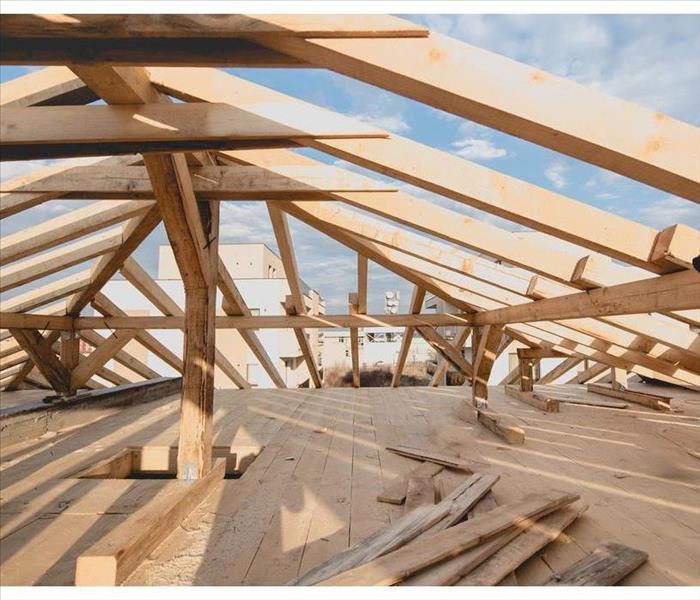 If you aim to keep your business protected from weather damage, the first place you should look is your building envelope
If you aim to keep your business protected from weather damage, the first place you should look is your building envelope
As a business owner in Unity Village, MO, you know how crucial it is to keep your building safe from all kinds of harm. One of the most dangerous risks that you may face is persistent rain damage. This threat can lead to various problems throughout your business, such as flooding and black mold. Fortunately, you can ensure that your company stays protected by establishing a secure envelope around your building. Here’s everything you need to know about how building envelopes work.
What Are Building Envelopes?
A building envelope refers to the construction and design of a building’s exterior that helps to repel the elements. There are numerous aspects of an envelope that allow it to do its job of keeping a building safe. Some of its most essential features include the following:
- Structural integrity
- Air pressure boundaries
- Temperature control
- Moisture control
Each of these elements plays a critical role in the effectiveness of a building’s envelope. It’s crucial to ensure that your envelope is shielded with these features so that it stays safe from rain damage.
The Importance of Building Envelopes
If you aim to keep your business protected from weather damage, the first place you should look is your building envelope. This structure acts as a major defense against rain, snow, hail and various other types of water and air intrusion. Once a building’s envelope captures excess water, it sends the water to a drainage system, helping to prevent black mold from forming in your business. A strong envelope around your building also helps to regulate the transfer of heat in and out of your business, which ensures that your employees and customers stay comfortable all year long.
Rain damage can have a severe impact on your business, and strengthening your building’s envelope may help to deter some of the harm. If your company suffers any damage despite having a powerful building envelope, be sure to call commercial building restoration services so your building can make a full recovery.
Buying the Right Fire Extinguisher
2/24/2020 (Permalink)
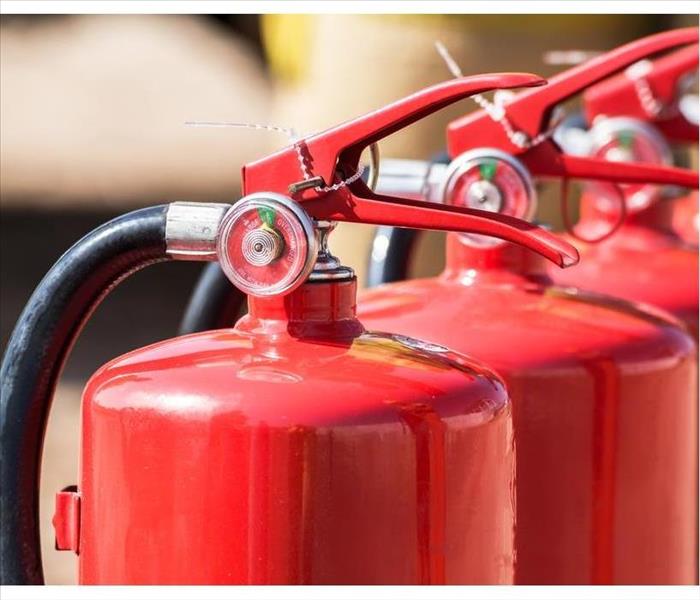 Buying a fire extinguisher for your home in Kansas City, MO can be confusing
Buying a fire extinguisher for your home in Kansas City, MO can be confusing
Buying a fire extinguisher for your home in Kansas City, MO can be confusing. There are so many options available that it’s hard to know which will work best for your family. The two main items to consider include the classification and the size of the unit.
Classification of Extinguishers
Household extinguishers are available in three classifications, or some combination of these, as identified on the label. The classification indicates which type of fire can be extinguished.
A - This class identifies ordinary combustibles like cloth, wood or paper.
B - Flammable liquids like cooking oil, gasoline and grease are identified in this classification.
C - Live electricity is handled most effectively with this class of extinguisher.
Many household fire extinguishers are classified with all three designations (A:B:C), which means that they can combat all three types of fires. Most units also include an identifying number directly preceding the letters. The higher the number, the more effective it will be to combat each type of home fire.
Sizes of Extinguishers
There are several sizes of extinguishers. The larger the unit, the more powerful it is. If it’s too heavy to handle, however, it won’t be of much use.
10 pound - This size is most suitable for a home workshop or garage. A rechargeable unit with a hose will make it more user-friendly.
5 pound - This unit can be stored easily under the kitchen sink or in the laundry room. The rechargeable model is the smartest option.
2 pound - This small extinguisher will fit nicely inside your car. The disposable unit comes equipped with a mount so that it will stay firmly in place inside your trunk.
Stove top - This option can be mounted on your stove range’s hood. Just remember not to place it over a deep fryer.
No matter which unit you choose, it is important to include fire extinguisher training as part of your family’s fire preparedness.
5 Steps To Take After a Toilet Overflow
2/17/2020 (Permalink)
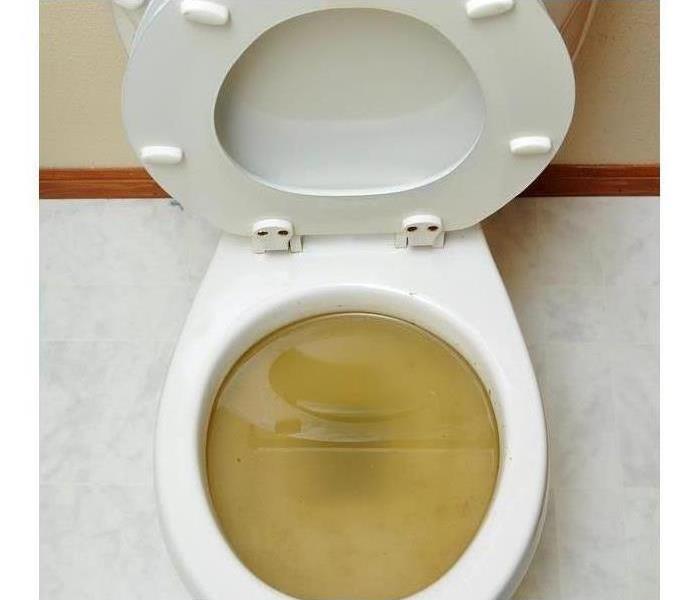 Overflowing broken toilet in Raytown, MO
Overflowing broken toilet in Raytown, MO
5 Steps To Take After a Toilet Overflow
If you’ve had issues with a toilet overflow you may have issues with sewer damage in your Raytown, MO, home. This can be a tricky mess to clean up as sewer water falls into the black water category and can require special equipment to ensure it is properly decontaminated. If you’re experiencing this problem here’s what you should do.
1. Call a Professional
One of the first things that should be done if you have a sewage problem in your home is to contact a local water damage restoration service to asses the damage, and begin cleanup and repairs. These professionals can locate the source of the problem which may help determine if the sewage company needs to be contacted as well
2. Wear Proper Safety Gear
It's important to wear proper safety gear any time you are dealing with sewage material to avoid the spread of contaminated material. This includes gloves, coveralls, boots, and masks.
3. Remove the Water
Once the professionals have arrived and safety gear is in place the professionals can begin the sewer damage restoration. One of the first steps you may see performed is the removal of any flood water and sewage materials.
4. Dry the Area
Once the water is removed it’s important to thoroughly dry the area. A dehumidifier may be used during this step.
5.Decontaminate the Area
After cleaning up a flooded toilet, it’s important to decontaminate the area to ensure that no bacteria remains. This is done to help ensure that the area is safe for use. The professionals overseeing your sewer cleanup may use special cleaners for this job.
When dealing with sewer damage it’s important to contact a professional as quickly as possible. They will have the correct equipment to perform the job safely, and can remove the water without causing further contamination to your home. These professionals will also be able to dry and decontaminate the space.
What Happens to Your Belongings After a Disaster?
2/7/2020 (Permalink)
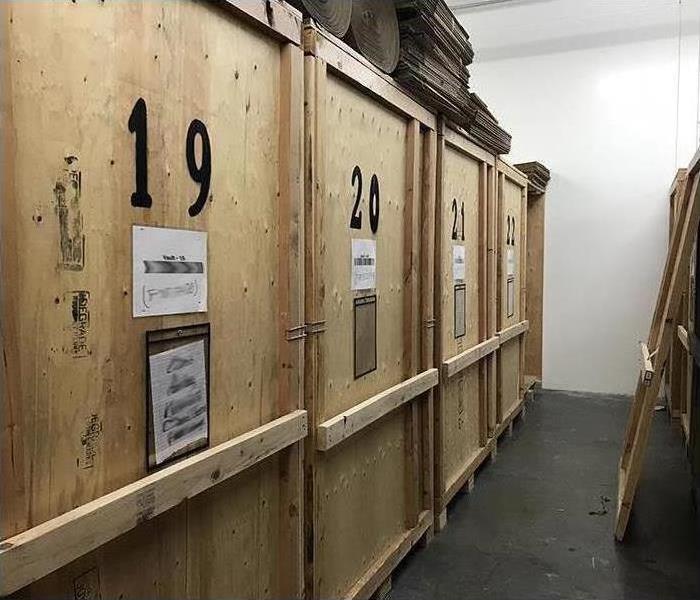 We have a large warehouse for in-house storage where your items will be safe and secure.
We have a large warehouse for in-house storage where your items will be safe and secure.
Water and fire damage affect not only the structure of your house but also your belongings. SERVPRO of Raytown/East Kansas City understands that your home is more than a structure. Your furniture, clothing, keepsakes, and other belongings are important to you. Your belongings are important to us, which is why we provide the following to help restore and protect your belongings while we are restoring your home.
Move-Outs/Pack-Outs
If your home requires extensive restoration or cleaning, SERVPRO of Raytown/East Kansas City can conduct an organized, efficient move-out of the affected area. A move-out will provide several benefits, including the following:
- A quicker remodeling process
- Protecting items from potential damage
- Protecting contents from further on-site damage
When restoration is completed, we will work with you to coordinate the move-in according to your needs. The services offered upon move-in may depend on your insurance coverage.
On-Site Storage
We have in-house storage where we can keep your belongings safe from further damage, and can provide cleaning and restoration services for your belongings. We have four warehouses dedicated to storage where we can keep your items safe and secure. Your items will be placed in clearly identified and secured containers. You can rest assured that your items are being taken care of.
Contents Claim Inventory Service
When emergency strikes, the damage can often feel overwhelming. We can help ease the worry and confusion during the recovery process by offering our Contents Claim Inventory Service (CCIS), which provides a detailed and accurate list of your belongings. We take a room-by-room inventory of your contents, including digital photos, and in some instances, bar coding.
Our Contents Claim Inventory Service:
- Preloss list and value of contents
- Detailed and accurate report
- Better information to settle claims quicker
- Assistance with burden of proof for claims
If your home and belongings need restoration services, rest assured that SERVPRO of Raytown/East Kansas City has you covered. We can pack out, store and restore your belongings. Give us a call today at 816-737-8776.
3 Benefits Adjusters Receive When Working with Restoration Companies
1/27/2020 (Permalink)
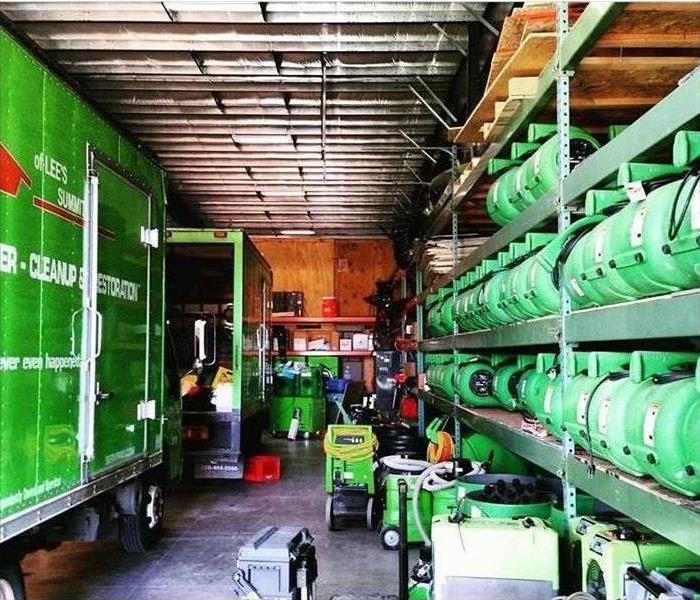 Water restoration equipment
Water restoration equipment
SERVPRO Provides Numerous Benefits To You and Your Client
As part of your profession as an insurance adjuster, you will need to work with other companies to provide clients with coverage and other related services. At the same time, you need to keep claim costs as low as possible. Therefore, it is critical to choose the best emergency restoration company for a thriving relationship. Companies like SERVPRO provide numerous benefits that you and your client can enjoy.
Certifications and Expertise
The restoration process requires precision and professionalism since these businesses are in a vulnerable state. A professional company employs technicians whose training meets strict IICRC standards and have years of experience. These employees continue to take courses to update and refine their skills. Your clients can expect workers who respond to situations immediately and repair water or fire damage using advanced techniques and equipment.
Accessible Claims Information
When you handle a client's insurance claim, you will need quick, reliable access to information that will help you make sound decisions. A professional restoration service can offer access to an electronic claims center that will have everything an insurance adjuster needs.
Access to files on new, current and completed jobs
Loss inventory
Project paperwork and forms
Photos and other visual references
Job estimate
Project performance comparison to set standard
Determining the extent of the damage and the amount of coverage can be a difficult balancing act. However, choosing to work with a large company ensures you receive critical information through your chosen format.
Cost-Cutting Pretesting Process
Restoration professionals aim to prevent, reduce and repair damage. These goals align with yours, as you seek to reduce claim costs and restoration is a cheaper option than replacement. Pretesting is the most effective method in analyzing damage before it escalates. The process assists workers in creating concise, clear solutions without wasting time or money.
Helping clients with their situations in their Unity Village, MO, locations can get complicated and sometimes costly. Restoration professionals can be important allies to an insurance adjuster like yourself due to these benefits and much more.
3 Tips for Mitigating Water Damage After Flooding at Your Business
1/27/2020 (Permalink)
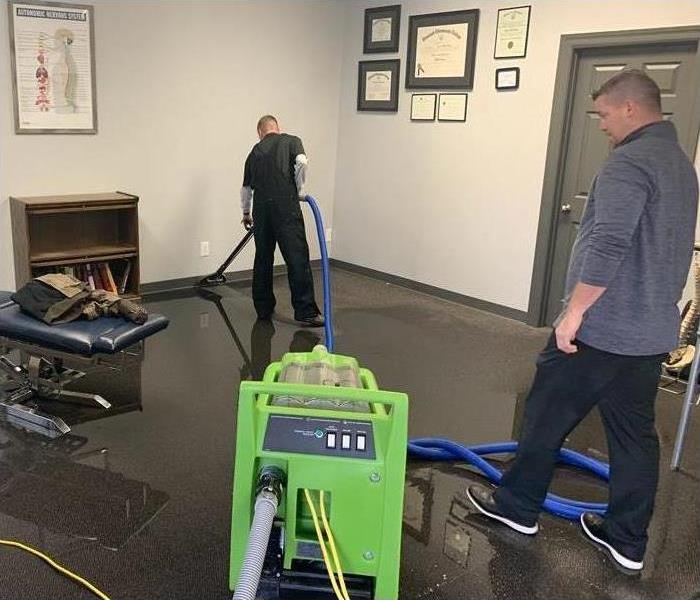 Standing water in a Raytown, MO office
Standing water in a Raytown, MO office
Action To Take To Reduce Flood Damage at Your Business
Indoor or outdoor flooding can cause untold water damage at your Raytown, MO business and leave you with questions about where, to begin with cleanup efforts. While some floods are small, the water can originate from a contaminated source, such as a toilet. However, there are a few actions you can take to reduce flood damage at your business.
1. Connect With a Restoration Service
One of the most effective ways to ensure you can mitigate flooding problems quickly is to connect with a water damage and remediation service as soon as possible. This gives you somewhere to turn when unexpected flooding occurs and can give you peace of mind that the problem can be handled quickly. Trying to find a service during heavy storms that may affect multiple businesses in your area may be difficult, so it may be wise to make a connection beforehand.
2. Turn Off the Building’s Water
If malfunctioning or broken pipes are causing flooding in your building, you may be able to reduce the water flow by turning off the main valve. Note its location early on and if you rent the building, call your landlord as soon as possible so he or she can have the water turned off. If the valve is in a location that is not safe to enter, you may want to call your local public works office for advice.
3. Evacuate the Building
Foot traffic can inhibit water cleanup efforts, especially once a flood cleanup and remediation crew arrives. Consider evacuating both employees and customers in the wake of a flood, as this may help them stay safe as well. You can ask your flood technicians to give you the all-clear once the floodwater is well controlled.
When water damage impacts your Raytown, MO business, the results can be devastating. Knowing how to reduce the flooding until help arrives can help you lower the total cost of restoration and protect your investments.
Understanding Property Damage Insurance
1/6/2020 (Permalink)
 Investing in commercial insurance can make recuperating easier
Investing in commercial insurance can make recuperating easier
Business owners in Raytown, MO, have a lot on their plates. From dealing with day-to-day operations, personnel and much more, a sense of security can often be lacking. Luckily, when it comes to protecting a business from the unthinkable, investing in commercial insurance can make recuperating easier.
What Does Commercial Property Insurance Cover?
At the basic level, this type of coverage helps a business deal with issues from events such as fire damage, explosion, storms, vandalism, theft and pipe bursts. Typically, phenomena like earthquakes and floods, as well as interruption loss, will require an additional layer of coverage. Other items often not covered include:
- Internal theft
- Vehicle damage or loss
- Stolen cash or currency
- Environmental damage
- Equipment failures
- Defective products
When personalizing coverage, it is important to take an inventory of the vital elements inside and outside of the building business is conducted to ensure full coverage of losses. The following should be assessed:
- Business structure, including leased or owned space.
- Office equipment and supplies, including computers, furniture, phones and copiers.
- Vital documentation records, such as accounting or client data
- Inventory on-site
- Landscaping, fencing and outdoor furniture
- Business signs, satellite dishes, security systems and other outdoor equipment
Coverage Options
Once you have an inventory of everything that needs to be covered, you can work with an agent to determine the type of commercial insurance coverage. Most plans reimburse loss based on the cost of replacement or the cash value of an item. It will also include costs of associated restoration services, depending on the situation. A replacement cost takes into consideration the repairs needed to rebuild without depreciation while a cash value payout provides funds to replace with a comparable item, including depreciation.
No matter the size of a business, commercial insurance is necessary to be ready for the unthinkable. Although it is an added cost, it is worth it if disaster hits.
Black Mold and Air Ducts: A Dangerous Combination
1/6/2020 (Permalink)
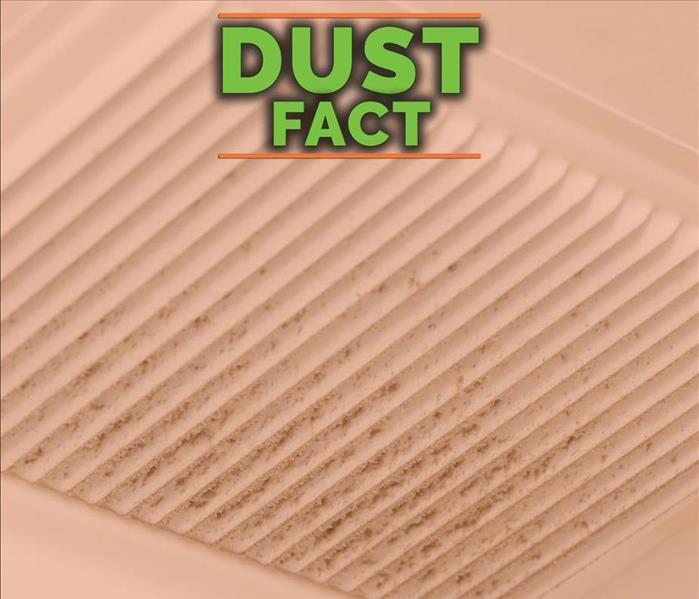 Dust that accumulates in your air ducts can lead to microbial growth
Dust that accumulates in your air ducts can lead to microbial growth
While the presence of black mold anywhere in your Kansas City, MO, commercial property is always a nuisance, it can be especially troublesome if it grows inside the air ducts. The air system can spread the mold throughout the entire location, increasing the damage around the area and endangering the health of anyone nearby, including employees and clients. Continue reading to learn more about the mold, how to remove it and how to prevent it in a timely manner.
Understanding the Mold
This type of mold, also known as Stachybotrys Chartarum, is distinct due to its darker hues of green or gray. This fungus feeds on organic matter such dust, cotton and wood. Due to its feeding habits, it is attracted to carpeting, walls, insulation and other locations that have organic material, as well as moist or isolated places. Filthy air vents and ducts can create the perfect habitat for mold.
Removal Process
If you suspect there is black mold within your air system, you will need to contact professional mold remediation. The specialists providing this service take a multi-step approach to the situation.
Inspect ducts to confirm mold
Remove and replace affected insulation
Disinfect and clean ducts using appropriate tools
Find source of mold and eliminate it
This process may become more complex depending on each case. It is crucial to detect the signs immediately and call for assistance.
Preventing the Mold
The best way to prevent mold inside your air ducts is by disrupting the perfect environment for its growth. You can stop dust buildup by changing the air filter regularly and cleaning the systems at least twice a year. Additionally, control the building's moisture by improving ventilation and fixing water damage, since humidity can also attract mold.
Black mold can not only thrive in the air system, but it can also spread throughout your property and create many problems. Attentiveness and decisive action can halt the situation before it begins.
Safe Cleanup of Water Leaking Into Light Fixtures
12/23/2019 (Permalink)
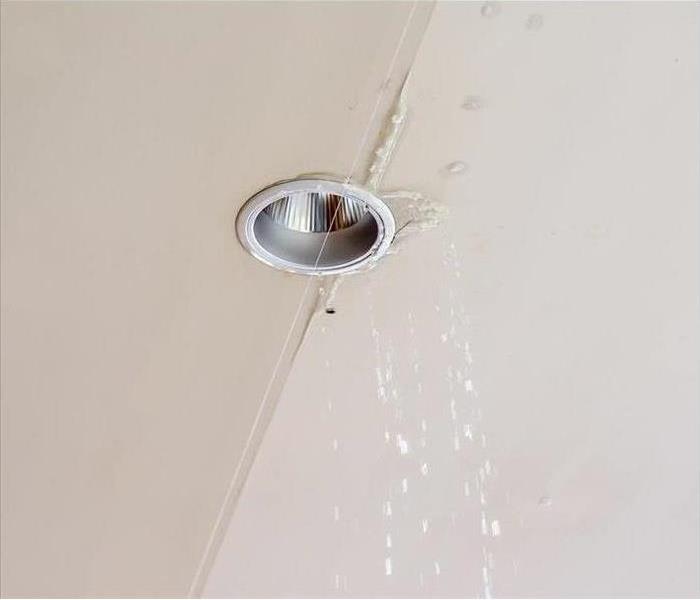 Water damage in light fixture
Water damage in light fixture
Safe Cleanup of Water Leaking Into Light Fixtures
It is not uncommon to find water in light fixtures, or even ceiling damage following a winter with a heavy snow load, or a series of rainstorms. This damage may not always be a major problem, but could definitely develop into such if allowed to continue.
Leaks of this nature may come from a leaking flange around a chimney or vent on the roof which has developed a gap, infiltration by birds or squirrels, or from an aging roof. It may also come from an overhead pipe that is leaking due to settling, loosening of joints or freezing temperatures. Finding and repairing the point where water is getting in is important and should be given priority attention.
How To Handle Cleanup
In order to prevent worsening damage from the water leaking in through the roof, immediate cleanup needs to take place.
The attic space should be inspected to see if the insulation has become saturated. Not only can that put an excess load on the ceiling, but it can also develop mold if left alone. It may need to be removed and replaced.
If the leak is from a pipe running above the ceiling, be sure to shut the water off as soon as possible to stop the leaking.
If you find water in light fixtures, shut off the electricity to all affected fixtures before attempting to inspect or replace it, and do not turn electricity back on until certain all water has stopped leaking.
Get Professional Help
Call a water damage cleanup specialist in Unity Village, MO, to evaluate any ceiling damage and make a plan for repair. They can determine which materials need to be replaced, ensure that any mold is cleaned and removed, and restore your home to a safe condition.
If you do find water in light fixtures in your home, take it as a serious hint that some repair and cleanup is needed. This will help prevent a worse scenario and help you get your home restored to a safer and healthier condition.
How To Use Building Envelopes To Keep Your Property Dry
12/18/2019 (Permalink)
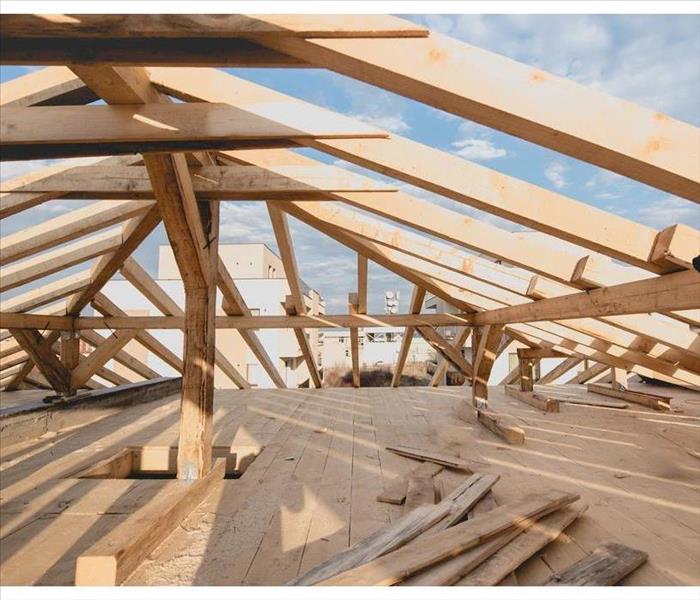 When building or remodeling the envelope for your property, you should take certain additional steps to keep the area secure
When building or remodeling the envelope for your property, you should take certain additional steps to keep the area secure
How To Use Building Envelopes To Keep Your Property Dry
Rain damage can harm a Unity Village, MO, commercial building in several ways. It creates an overflow of water, which may necessitate expensive flood cleanup. The water can destroy both the structure of a building and the contents inside it. Rain damage can also lead to a buildup of toxic black mold.
Thankfully, there are ways to prevent major storm damage to your property. One common tactic is securing the building envelope. This envelope consists of the wall systems and the roof, and it has several functions. They include:
- Resisting the escape of cool or hot air
- Diverting water to the storm drains
- Protecting and supporting equipment
- Defending the building from snow or rain
Securing the Envelope
Water penetration is responsible for the majority of harm to buildings. Flood damage, in particular, can be costly. Worst of all, water does not need a lot of space to get inside a property. A hole as small as 0.005 inches is all it takes.
This hole can result from cracks in the plaster and brick that make up the walls. Poorly installed joints can cause gaps, as well. To limit the rain damage to your property, be sure to seal as many of these openings as possible.
Designing the Envelope
When building or remodeling the envelope for your property, you should take certain additional steps to keep the area secure. If possible, limit the number of protrusions you use. You should also avoid using too many different cladding materials. You may want to include rain screens and capillary breaks, as well.
There are backup systems you can install, too. You can utilize weep holes that drain excess water to the outside of the building. You can also use through-wall flashing to divert moisture to the exterior.
Proper maintenance of your commercial building envelope can prevent rain damage. However, if your property does sustain a leak, storm cleanup specialists can assist with the restoration process.
4 Tips For Dealing With an Overflowing Toilet
12/10/2019 (Permalink)
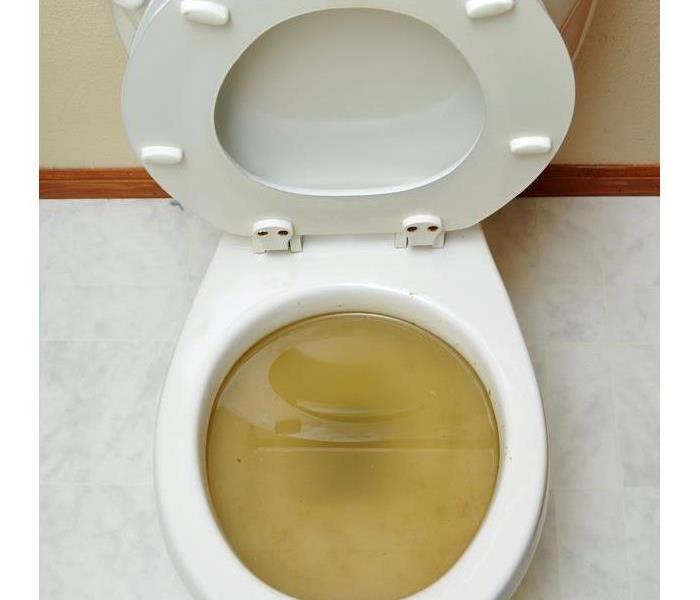 An overflowing toilet can be an annoyance, or it can be a sign of sewer damage
An overflowing toilet can be an annoyance, or it can be a sign of sewer damage
4 Tips For Dealing With an Overflowing Toilet
An overflowing toilet can be an annoyance, or it can be a sign of sewer damage. From clogs to broken pipes, there are a variety of reasons why water might be backing up in your toilet. If you are having this problem in your Kansas City, MO, home, keep the following tips in mind.
1. Stop the Water Source
If the water stops overflowing when you do not flush the toilet, then you might be dealing with a simple clog. However, if it keeps filling up even when you aren’t using it, there might be a more serious problem. In this case, it can be helpful to limit water usage and turn off appliances that could contribute to water backup.
2. Wear Protective Clothing
A flooded toilet often contains category 3 or black water. It can carry significant amounts of bacteria and sewage. Because this can be hazardous to your health, you should avoid the water if you can. If you need to be around it, be sure to wear gloves and other protective gear.
3. Set Aside Wet Items
If your home has sewer damage, you will need to report it to your insurance company who will send an adjuster to inspect your house. If any items have been damaged, you should set these aside as evidence of the damage. Move any items that have not been affected to a dry location.
4. Contain the Area
If the water has not stopped rising, you should block off the bathroom with boards, tarps or other waterproof materials. This will keep the water from spreading to other areas and causing more damage. A sewage company can help with this step.
Because sewer damage often involves contaminated water, it is not recommended that you clean it on your own. Instead, hire a cleanup and restoration company to remove the water and sanitize any affected areas. They can also make needed repairs and salvage damaged belongings.
Be Safer With a Home Fire Extinguisher
11/24/2019 (Permalink)
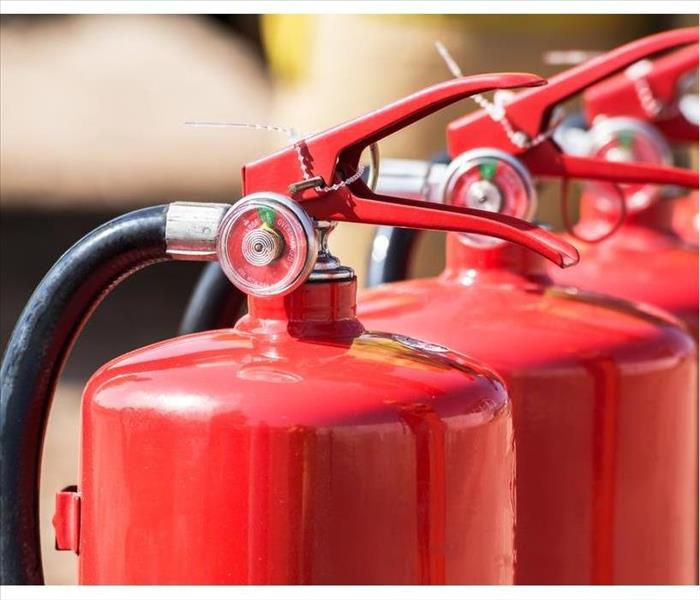 Preparation can help you avoid a disaster however, so keep a couple extinguishers at hand
Preparation can help you avoid a disaster however, so keep a couple extinguishers at hand
Be Safer With a Home Fire Extinguisher
Small incidental fires can begin at home for several reasons; a cigarette, a grease fire on the stovetop, or a lit candle or space heater left unattended. A small home fire can often be put out with a fire extinguisher, rather than calling the fire department in Raytown, MO. That, of course depends on the size of the fire and the type of extinguisher you have.
Get the Right Extinguisher
Part of fire preparedness is knowing which kind of fire extinguisher is best for certain fires. Understanding the difference is of great importance, as some can do more harm than good. The following list explains the difference.
Type A – Suitable for everyday combustibles such as paper, fabric and wood
Type B – Works best for fuels like gasoline, butane and for cooking oils
Type C – Most appropriate choice for electrical fires
Additional Information
Not only do extinguisher have different types, but they have other variations besides. Type A and B have a number before the letter to designate its effectiveness. A 4-A works better on a paper fire than a 2-A. If the unit has a C but no number ahead of it, it means it will not conduct electricity.
Which Extinguisher is Best?
The kind you decide to keep in your home depends on where you intend to keep it. You may decide you need more than one at hand for the greatest safety. For instance, you would do well to keep a type B in the kitchen where you are most likely to experience a grease fire. You might want to keep a type C near the breaker box and a type A near a home den, library or craft room.
In the event a larger blaze breaks out and you require more than a fire extinguisher, call 911 immediately. Then get help to assess fire damage and manage fire cleanup, call the fire and water restoration service in Raytown, MO for help. They can handle the fire damage cleanup and help get things back to normal. Preparation can help you avoid a disaster however, so keep a couple extinguishers at hand.
The Top 5 Places Where Mold Might Be Hiding
11/24/2019 (Permalink)
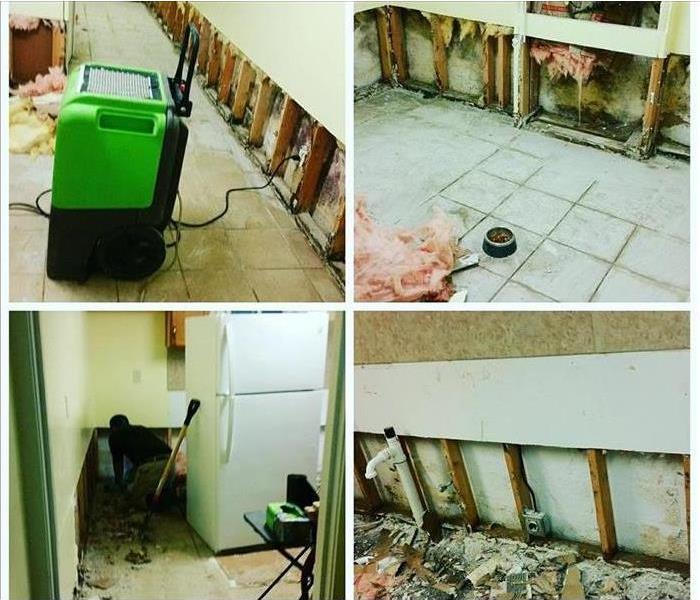 Kitchen mold damage in Kansas City, MO
Kitchen mold damage in Kansas City, MO
Top Five Places Where Mold Might Be Lurking
While you can call a remediation company in Kansas City, MO, if you suspect a mold problem in your home, a team of professionals is not always immediately necessary. There are varying degrees of mold growth, from itemized occurrences to full-scale infestations. The best way to understand your current mold problem is to inspect your home and know the top five places where mold might be lurking.
- Behind walls
- Under flooring
- HVAC systems
- Beneath Sinks
- Mechanical Closet
Behind Walls
Mold exists in dark, damp spaces. Wall cavities provide an excellent environment for spores to thrive. While you might not expect a significant issue when you come across a small area of moldy drywall, know that when mold presents on the surface of a wall, it is likely well-developed behind as well.
Under Flooring
Similar to moldy walls, mold on wood floors typically suggests a more substantial issue beneath the floorboards. However, that doesn't only go for wood floors. Some flooring types exacerbate the problem because there are limited, if any, visual clues. For example, linoleum flooring is nonporous, which means that mold cannot penetrate through to the surface.
HVAC Systems
Unfortunately, when mold growth occurs anywhere in the house, your HVAC system may have been infiltrated as well. Look for signs of discoloration of vent covers and a musty odor coming through as well.
Beneath Sinks
Another common space for mold to develop is underneath sinks. While these areas are not as hidden as some, homeowners typically store cleaners and supplies under sinks, making it difficult to discern whether there are minor leaks that could create an environment for spores to settle and multiply.
Mechanical Closet
Last, similar to cabinets under sinks, a homes mechanical closet - the area where the water heater is found - is also a prime location for mold development. These spaces are often humid and dark, and because they are not checked on regularly, leaks do occur, leading to growth and reproduction of spores.
No homeowner wants mold growth developing in their home. Therefore, it is necessary to inspect your house vigilantly and to call for professional help when needed.
3 Tips for Recovering From Storm Damage
11/13/2019 (Permalink)
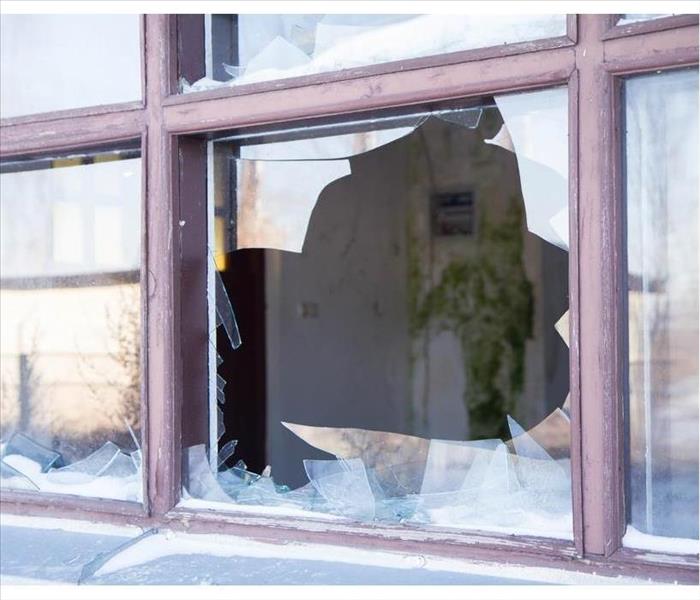 Broken window due to a storm in Unity Village, MO
Broken window due to a storm in Unity Village, MO
When a serious storm is in the forecast, the potential for property damage is always present. Do you have an emergency plan for extreme weather event? Here are some storm tips to minimize the destruction and get you back to normal after a storm hits your Unity Village, MO, property.
Types of Storm Damage
Storms can bring countless types of damage, from hail devastation to broken windows. Some of the most common and destructive forms of storm damage include:
- Wind destruction
- Flood problems
- Electrical issues-lightning strikes
Any of these types of damage can result in extensive property destruction and considerable expense, especially if you don’t know how to handle the aftermath.
Contact Your Insurer
Many homeowners wait too long to contact their insurance providers after a storm. Getting in touch with your insurance provider, is important after assessing the damage, as this will ensure you get a claim filed quickly and start the process for returning your property to normal. It can also prevent taking any steps that could void a claim so make the call as soon as you can.
Take Pictures
When a storm occurs it is essential you document affected items with images. Without images you run the risk of underestimating just how much damage was done. So whether it’s on a camera or with your phone, taking pictures is one of the most important storm tips you can follow.
Secure Your Property
The only thing worse than sustaining damage in a storm is getting new damage in addition. It is important to invest in tarps to cover roof holes, board up broken windows with plywood, or take any other steps necessary to prevent new wind or water damage from getting inside your home.
What you do after a storm can be just as important as what you do before it. Use these storm tips in the initial wake of a storm and contact the right insurance agent and water cleanup companies to get your property back in top-notch condition.
Emergency Board Up Services
10/29/2019 (Permalink)
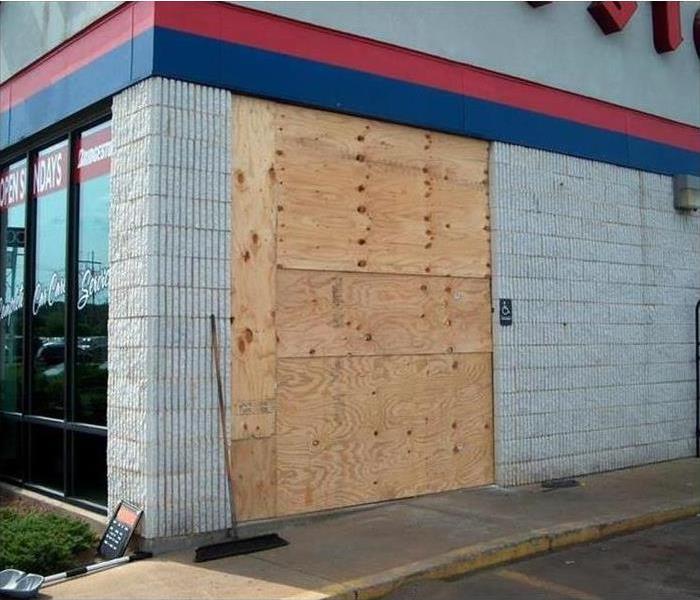 Need Emergency Board Up Services? Contact SERVPRO of Raytown/East Kansas City today to schedule an appointment: 816-737-8776
Need Emergency Board Up Services? Contact SERVPRO of Raytown/East Kansas City today to schedule an appointment: 816-737-8776
If your home or business incurs storm or fire damage resulting in an opening in your building you may be in need of emergency board up services. Any openings in the structure needs to be properly boarded up to protect the building from weather and illegal entry. Your insurance policy also requires you to be proactive on protecting your home or business after any type of damage has occurred, otherwise the insurance company could account any further/secondary damage to the structure as negligence.
Not every situation requires the most extensive board up that the U.S Fire Administration have in their board up procedure manual, such as after a fire where the entire home is destroyed and is considered a complete loss. While each emergency board up is different, let’s take a look at how to properly board up a structure after damage has caused an opening in the building.
Determining How Much Protection Is Needed
- Openings in the basement, first floor doors, windows and any point of entry accessible from a porch, fire escape or other potential climbing point require additional security measures. These openings should be barricaded with plywood, 2x4s, bolts and nails.
- Openings that are at least 10′ from ground level which are not accessible from a porch, fire escape, roof, or other climbing point can be secured with nails in each brace, and every 12″ around the perimeter. For these openings the plywood should be fitted so that it rests snugly against the exterior frame, butting up to the siding on wood frame buildings and up to the brickwork on brick buildings. It may be necessary to remove the staff bead so this fit can be flush and tight.
Boarding Up
- Cut plywood to fit over the window and door openings, flush with outside of the molding. Note: For buildings with metal door and window frames the alternative is to cut the plywood and 2x4s to fit the inside of the door frame buffed up against the band molding.
- Cut the 2x4s to fit the horizontal dimension of the plywood. You will need two 2×4 exterior and two interior braces for each window and three sets for each door. Note: For buildings with metal doors and window frames the 2x4s for the outside will be cut to the dimensions of the plywood, fitting inside the door frame, against the band molding. For the inside the 2x4s will be cut to the outside dimension of the door or window frame.
- Pre drill 3/8th inch holes in the plywood and the braces.
- The holes will be placed approximately 1/3 of the length of the brace from each outside edge of the door and window jam.
- The two window braces will be placed 1/3 of the distance from the top and the bottom of the window.
- The three door braces will be placed; one in the center of the doorway, and one half the distance from the center to the top and to the bottom of the doorway.
- Place the plywood over the exterior opening and nail to the frame. Note: For metal frames place the plywood and braces inside the frame against the band molding.
- Place the 2×4 braces over the interior and exterior of the door or window.
- Place the large washer over the carriage bolt and place the bolt through the holes.
- Place washer and nut inside and tighten securely. Torque the nut so that it slightly compresses the interior 2×4.
3 Elements Property Managers Need to Prioritize for Storm Preparedness
10/24/2019 (Permalink)
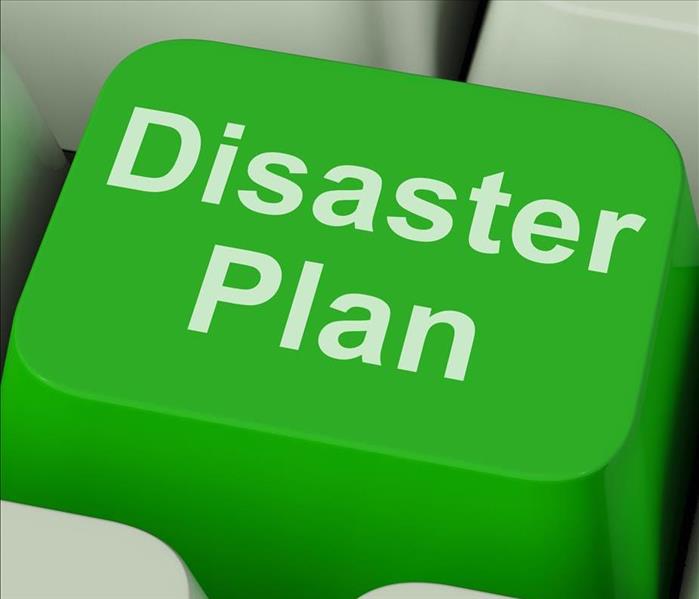 You should create a plan for storm and other natural disasters
You should create a plan for storm and other natural disasters
Property managers and owners in places such as Kansas City, MO, might need to get ready for any natural disaster heading towards their investment, such as storms. They are not only responsible for the property, but also the safety of the people who live or work in such buildings. When it comes to storm preparedness, these leaders might need to prioritize specific elements to react appropriately to the incident, protect the individuals and mitigate as much of the storm damage as possible.
Communication With the Tenants
The wellbeing of a rental property's residents is always the top priority. As such, property management generally works with these people to create a plan for storms and other natural disasters. Management usually maintains communication through phone, email or text that informs residents about important information.
- Emergency resources
- Shelters
- Special needs resources
- Rental unit preparations
Managers and owners are responsible for clear, open communication of these plans before any storms take place.
Employee Safety
Staff evacuation and safety can be difficult to achieve, as they must assist tenants and maintain equipment and property before they leave. A manager should have a storm preparedness plan to share with employees, detailing their responsibilities and tasks right before a storm. These often involve preventing damage to electronic, mechanical and fragile equipment, as well as helping residents. They might need management's contact information and instructions once the storm has passed.
Storm Damage Records
Managers should keep record of as much property damage as possible to assist with the insurance claims. It is crucial to inspect property and equipment and record their status before the storm. Afterwards, before they call emergency restoration services, they might need to inspect the damage and compare it to the previous records. Images, video and documentation from before and after can be useful during the claims process.
Responsible property managers know how to prioritize and get ready before disaster strikes. An effective storm preparedness plan accounts for residents, staff and property to ensure a successful future for the rental business.
A Leaking Water Heater Can Be Hazardous
10/16/2019 (Permalink)
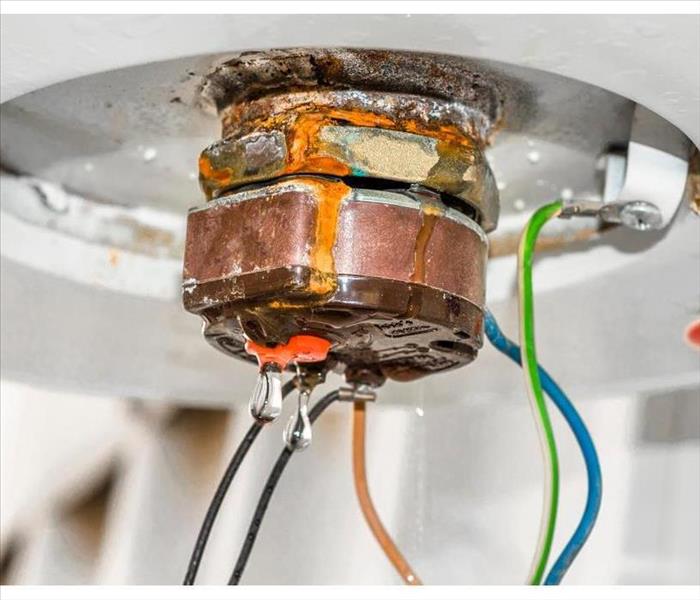 A leaking water heater in a Raytown, MO home
A leaking water heater in a Raytown, MO home
A Faulty Water Heater Can Pose Some of The Following Risks
Most people don’t give their water heater a second thought until they don’t have hot water anymore. If you don’t have any hot water, there’s a good chance that your water heater is leaking. Water heaters are usually located in inconspicuous areas such as a basement, closet or garage, so a leaking water heater may go unnoticed for days, or even weeks, as water builds. A faulty water heater can pose some of the following risks:
1. Electrocution
When you discover that your water heater has been leaking, shut off the power supply via the breaker box. It may seem necessary to get the leak stopped as soon as you notice it. But an electric current could very possibly be traveling through the water if there are other appliances or exposed wiring or power outlets in the area. Stepping in the water could be deadly. Be careful to not get into such a rush to stop the leak that you risk electrocution.
2. Fire
Electrical wiring that’s exposed to water for long periods of time can corrode. This corrosion could cause your electrical system can short-circuit, sparking a fire. This is another reason to shut off the power to the area of the leaking water heater as soon as possible.
3. Burns
Watch out for scalding hot water spewing from the water heater. Water heaters are pressurized and a broken water heater can burst under some circumstances. Turn off the water supply as soon as you can safely access the water supply valve. However, never cap the pressure relief valve; if you do it will eventually explode.
4. Water Damage
Water damage can start almost immediately. Carpet can become soaked and hardwood or laminate flooring can buckle. Water will seep up and through drywall.
5. Mold Growth
Mold growth can start in as little as 24 hours after the introduction of water. Mold spores will not only spread in the area of the failed water heater but could potentially affect your entire home.
If your home in Raytown, MO sustains water damage from a leaking water heater, call on water damage remediation professionals.
Should You Include Insurance Coverage for Water Damage in Your Business' Policy?
10/12/2019 (Permalink)
 Choosing appropriate coverage for your business or commercial property in Unity Village, MO, can be hard
Choosing appropriate coverage for your business or commercial property in Unity Village, MO, can be hard
Choosing appropriate coverage for your business or commercial property in Unity Village, MO, can be hard. There are so many things that could happen, what is most relevant to your situation? There are a few business claim constants, and one of them is water.
A Common Problem
Water damage can happen to anyone, anywhere. There are many different sources: flooding, storms, plumbing issues or sewer backups. What does this mean for an owner of commercial property?
The average water and freezing damage claim cost is $17,000.
It is the second most common insurance claim for a commercial property to make, right under burglary and theft.
It can be exacerbated by geography- certain areas are more prone to severe weather patterns than others, including harsh freezes and hurricanes.
Not Always Covered
A typical business insurance policy might not have specified coverage for water damage, although you may be able to make a business claim under an "all perils" plan. So, this means that your coverage will depend on your situation. If your water damage is a result of an issue that is easily avoided with routine maintenance, it will probably not be covered. If it is sudden and could not have been prevented, it probably will be covered. However, there are add-ons for specific situations, also known as riders, that you can ask for in your policy.
Preventable
Proper care can go a long way for reducing the likelihood of water damage coming from your plumbing. Freezing is a big cause of pipe break, so be sure to insulate any exposed pipes and maintain a temperature of at least 55 degrees Fahrenheit at all times. Have your drains regularly inspected and check for leaks often. Just in case, find a reliable water damage remediation company to respond should the need arise.
When looking at the history of commercial insurance and the typical business claim of commercial properties, it becomes clear where your priorities should lie. Water is present both inside and outside almost every building, so be prepared for what it can do.
3 Steps To Take If You Suspect a Gas Leak
10/12/2019 (Permalink)
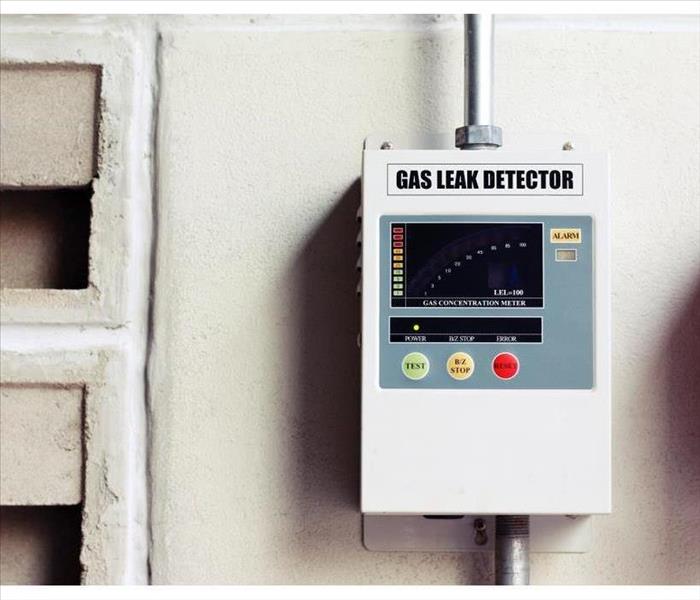 Take three steps to avoid a gas fire in your home
Take three steps to avoid a gas fire in your home
Act Quickly To Avoid a Gas Fire
If you notice a smell similar to rotten eggs or hear a hissing noise in your home in Raytown, MO, then you likely have a gas leak on your hands. To prevent a gas fire from breaking out, quickly take the following three steps.
1. Turn Off the Gas Source
If the smell of gas is very faint, you should try to turn off the source of the leak to prevent a gas explosion. Many times, the leak is coming from a home appliance such as a gas stove, fireplace, water heater, or boiler. If you are certain the gas if coming from one of these, you can often stop the leak directly at the appliance. If you are unable to determine the source, you will need to find your home’s gas meter and turn off the main natural gas shut-off.
2. Ventilate The House
After you’ve successfully turned off the source, you need to ventilate any remaining gas by opening all the windows and doors in the house to allow fresh air in. Do not try to turn on fans, lights, or any other electronics during this process since this can start a gas fire. If necessary, grab a flashlight to help you.
3. Evacuate and Call for Help
If at any point the rotten egg smell seems very strong or you feel unsafe, exit your home immediately in case of a gas explosion. As soon as you are a good distance away from your house, call for help. You can call 911 or dial your utility company’s emergency number. If there is any sign of a fire, you also need to get in contact with a professional fire restoration company to deodorize your home and address any damage.
If you think you smell natural gas leaking in your home, always act quickly to avoid a gas fire. Whether you have time to shut off the gas or need to leave immediately, make sure to prioritize your safety.
Which Air Purifiers Can Help Reduce Mold Spores?
9/19/2019 (Permalink)
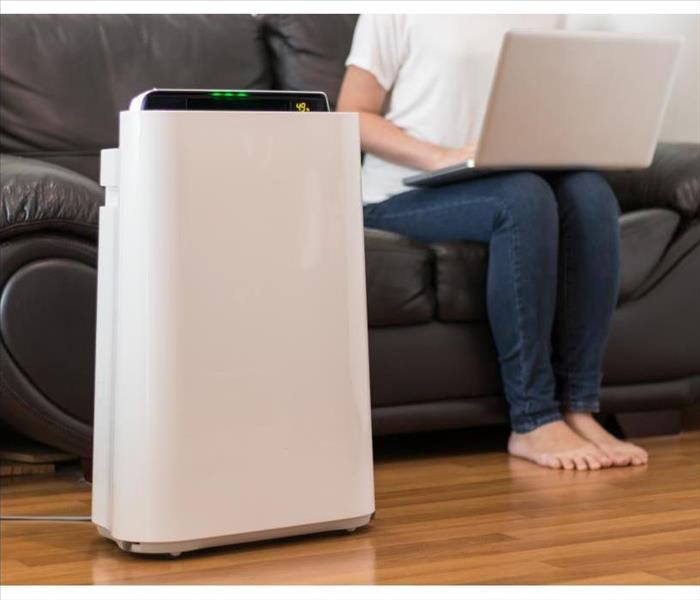 Air filtration is a quick and easy way to keep your home and family healthy
Air filtration is a quick and easy way to keep your home and family healthy
Which Air Purifiers Can Help Reduce Mold Spores?
If you are a homeowner in Kansas City, MO, and you're into preventative care, air filtration is perfect for you. Keeping your home dry and mold spores at minimal levels can go a long way in avoiding mold growth spurts and remediation services. There are a lot of products out there, which ones can you trust?
Orsani Max
The Orsani Max is currently the top rated residential air purifier on the market at a cost of $479. It is lightweight and can be moved easily by one person. The company claims that it is one of the quietest air purifiers out there, and the reviews can back it up. It has even been rated well in tough areas like the basement. The coverage of filtration is about 600 sq ft, or a 20x30 space. This product can clear the air of:
- mold spores
- dust
- pollen
- pet dander
BlueAir 450E
This Swedish air filtration system, BlueAir 450E, is rated number 2 on the market. The coverage is slightly less, about 365 sq ft, and the price is slightly higher, at $629. However, it can filter for the same things as the Orsani Max at the same rate of 99.97%. It also boasts of a spot in the Stockholm National Museum for its design. One unique feature is its auto speed control- it will automatically test the air quality in the room and adjust the speed of the air flow accordingly.
OV200 Air Purifier
The number 3 spot is taken by another Orsani brand air purifier- the OV200. The coverage on this one is 400 sq ft and is recommended for bedrooms specifically. The price comes in at $329. Orsani makes similar claims of quietness and air particle filtration for this model, in addition to odor control. It also comes with a remote control and child lock feature.
Air filtration is a quick and easy way to keep your home and family healthy. Mold spores are naturally everywhere, both inside and outside; strategic areas like your basement, attic and bathroom could always use a little more air flow.
Save Money by Safely Mitigating Storm Damage
9/11/2019 (Permalink)
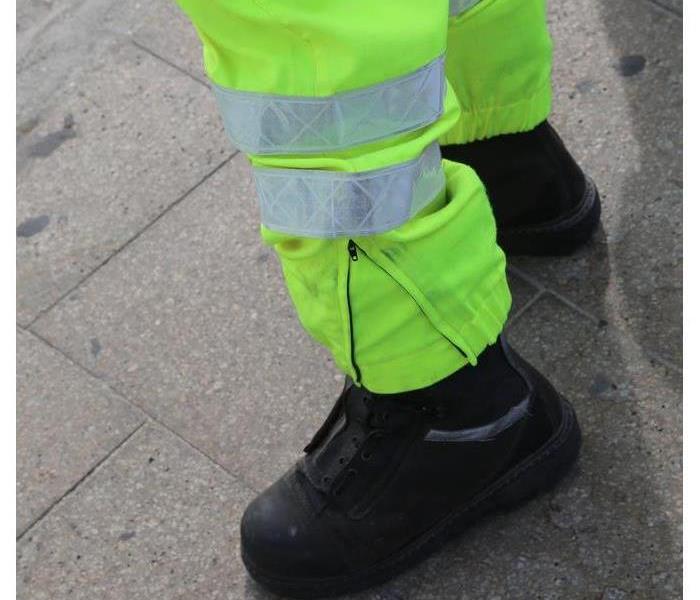 Wear protective gear to avoid cuts and puncture wounds from broken glass, nails and other debris
Wear protective gear to avoid cuts and puncture wounds from broken glass, nails and other debris
Storm damage can cost you money and create unsafe conditions. Two effective storm tips for saving money and avoiding injury after a storm are to take safety precautions and mitigate your damage.
Take Safety Precautions
These safety precautions can help you avoid injury while assessing or repairing damage to your property:
- Wear protective gear to avoid cuts and puncture wounds from broken glass, nails and other debris.
- Never touch or attempt to move a downed power line. Call your Raytown, MO, power company for assistance.
- An open flame or electrical spark in the presence of a gas leak can cause an explosion. Call your gas company if you suspect a leak.
- Don’t touch standing water without ensuring that your electricity has been turned off and there are no nearby downed power lines.
- Avoid walking in, on or around property that may be structurally damaged. Damaged roofs, ceilings and floors can collapse suddenly, causing serious injury.
Mitigate Your Damage
There are two types of storm damage. The first is the initial damage that happens when a storm causes a hole in your roof or a broken window. The second is the damage that occurs after the storm is over.
The rain that comes in through your newly leaking roof or broken window can cause mold or rot. Flying debris can cause damage to your home’s exterior. You can mitigate the damage that occurs after the storm by utilizing these storm tips:
- Cover small holes in the roof or broken windows with a tarp or plywood while you’re waiting for permanent repairs.
- Clean up small floods with mops and buckets or rent a wet-dry vacuum.
- Remove fallen limbs, broken glass and other small debris.
- For bigger jobs, consider employing a disaster recovery team.
Whether you take care of everything yourself, or call in the experts, incorporating these storm tips in your disaster recovery plan will help keep you safe while also saving you money.
Benefits of a Commercial Generator
8/14/2019 (Permalink)
 Commercial generator in Kansas City, MO
Commercial generator in Kansas City, MO
Benefits of a Commercial Generator
If a big storm blows through Kansas City, MO, a sudden power outage can cause a wide variety of problems. You will want to make sure that your business keeps running as if nothing has happened. Your employees and patrons count on you keep them safe, productive and comfortable. Whether the power goes out for a couple of hours or the storm cleanup continues for several days, a generator can make all the difference. It will ensure your business’:
Safety
In the event of power loss, security and emergency lighting need to remain functional. Safety mechanisms on machinery may not work if the power goes out suddenly. A power outage in a healthcare facility will turn into a life and death matter; oxygen machines and other lifesaving equipment will fail.
Protection
A generator is your climate control insurance. Computers and other electronics can be damaged by extreme temperatures. Perishable goods, such as food, chemicals and pharmaceutical products also need to be in a temperature-controlled environment. Having an alternative power source will provide you with the assurance that unnecessary damage is avoidable.
Productivity
Your business can continue running as though nothing has happened to interrupt production. Your regular customers will be assured that you are open and available for business, and you will maintain your bottom line.
Comfort
Heating and cooling systems will remain operational for the comfort of employees and patrons. Extreme temperatures can pose hazards to the health of employees (e.g., high blood pressure) and can decrease their productivity. Patrons are also not going to want to spend time in an uncomfortable environment.
A commercial generator will be expensive, but it could ultimately pay for itself many times over in the future. Your business will continue to be up and running during those unexpected power outages. Generator problems can be avoided by having inspections conducted regularly by storm damage restoration professionals.
What to Do After a Kitchen Fire
8/7/2019 (Permalink)
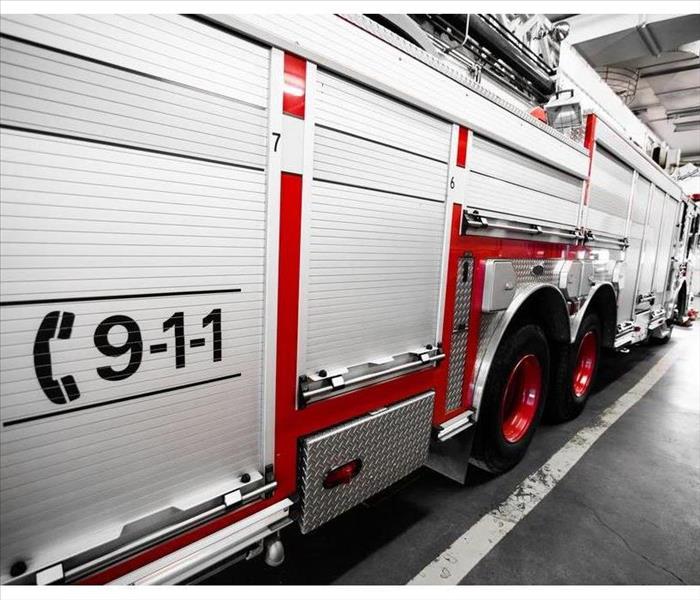 Call the fire department
Call the fire department
What to Do After a Kitchen Fire
Dealing with a kitchen fire in Raytown, MO, can be overwhelming and result in a lot of damage. To ensure that your restaurant, employees and customers stay safe, it’s crucial to take immediate action. From using a fire extinguisher to following an evacuation plan, there are a number of important steps that you must take as soon as a fire breaks out in order to prevent it from spreading. Follow this guide if you ever find yourself dealing with a fire emergency.
Call the Fire Department
As soon as a fire starts in your kitchen, you need to call for help. While you’re waiting for the fire department to arrive, be sure to sound the fire alarm in order to alert everyone in the building. Taking these steps helps to maintain a sense of order and keeps the situation under control.
Use a Fire Extinguisher
Fire extinguishers are lifesaving tools in the event of a fire. However, you need to be able to use one correctly so that it does its job successfully. To use an extinguisher, do the following:
- Pull the pin to break the tamper seal
- Point the nozzle at the fire’s base while aiming low
- Squeeze the handle to allow the agent to escape
- Aim the extinguisher at the fire’s base while sweeping from side to side
Following this procedure can enable you to fight the fire properly.
Evacuate the Building
You must evacuate the building immediately if you find that the fire extinguisher has failed to put out the fire. Be sure to leave the job to the fire department and focus on confirming that everyone has safely exited the restaurant. It’s vital to communicate a safety plan to your workers in advance so that everyone is prepared in case of a real fire.
If you notice any fire damage that occurs after a kitchen fire, call fire restoration services as soon as possible. Trusting professionals to restore your restaurant business can allow you to have peace of mind.
What To Do When You Can Smell Mold But Can't See It
7/22/2019 (Permalink)
 Sometimes the most accurate way to find mold is to use a thermal camera
Sometimes the most accurate way to find mold is to use a thermal camera
What To Do When You Can Smell Mold But Can't See It
When a building has mold, you can usually see it. Mold comes in various colors and sometimes they blend into the wall, but upon close inspection, you can usually spot it. Other times, you may not be able to find the mold anywhere, but you notice a distinct mold smell. When this happens, what do you do? After all, you need to find it to clean it.
1. Check the HVAC Unit
One of the most common places mold remediation specialists find the source of a fungus smell is in the air ducts. Many people do not at first suspect the HVAC unit because it pushes out cool air or hot dry air. Neither of these provide the warm, damp environment preferred by mold. Even so, cool air leads to condensation, which may breed mold and lead to that mildew smell.
2. Use a Thermal Camera
Sometimes the most accurate way to find mold is to use a thermal camera. This detects moisture, which in turn can help to identify breeding grounds for mold. You may find that the mold smell is caused by a dripping pipe behind a wall, a wet spot under the carpet or even a drink maker in the break room. While not all areas with water may have mold, it is a good starting point.
3. Clean Up the Mold
The cleanup process depends on the type of affected area. Sometimes a biocide can be used to wipe the area clean. Other times, professionals may need to remove any affected porous material, such as carpeting or dry wall. After this, a HEPA vacuum will be used to clean up any remaining mold spores not visible to the naked eye.
When you detect a mold smell in Unity Village, MO it is important to act quickly. Failure to do so may cause the mold to spread, leading to the contamination of other areas.
What To Do Right After a Storm Damages Your Home
7/21/2019 (Permalink)
 Cover leaking roofs with a tarp to prevent more rainfall from entering the home
Cover leaking roofs with a tarp to prevent more rainfall from entering the home
What To Do Right After a Storm Damages Your Home
You hear the wind blowing and the rain pounding on your window panes, and you hope your home in Kansas City, MO, will remain untouched by the storm. Unfortunately, this is not the case. A tree falls on your roof, and water pours into your home, soaking your carpets and covering your hardwood floors. Here's how to stem the tide of storm damage in the event's immediate aftermath.
1. Document Damage Before Attempting Immediate Repairs
If you are planning to submit a claim to your insurance company for the damages, you will want to record them prior to attempting any immediate repairs. Make a list of damaged items, and take photos or video of each.
2. Make Immediate Repairs Only To Prevent Further Damage to Your Home
Take the following steps when attempting immediate repairs or cleanup:
- Cover leaking roofs with a tarp to prevent more rainfall from entering the home.
- Pull up wet carpet to prevent mold and move it to a dry location.
- Throw away all perishable food that has spoiled.
Make sure all articles being removed from the home were documented on the inventory list of damaged items.
3. Exercise Caution If You're Staying in a Damaged Home
To restore lost electricity in your home, use generators outside, away from windows and doors. Make sure your sewer system is working before flushing toilets, using water stored previously for this function if necessary. Open windows and run fans inside your home to circulate air and aid the drying process.
You may also choose to contact a company that can perform emergency restoration services in your home. If so, keep receipts for services provided, as well as for any purchases made for immediate repairs, such as a tarp for the leaking roof.
Hopefully, your home will never be subjected to storm damage. If it is, however, these storm tips can get you started on the road to recovery and get your life back to normal as quickly as possible.
5 Ways to Put Out a Grease Fire
7/16/2019 (Permalink)
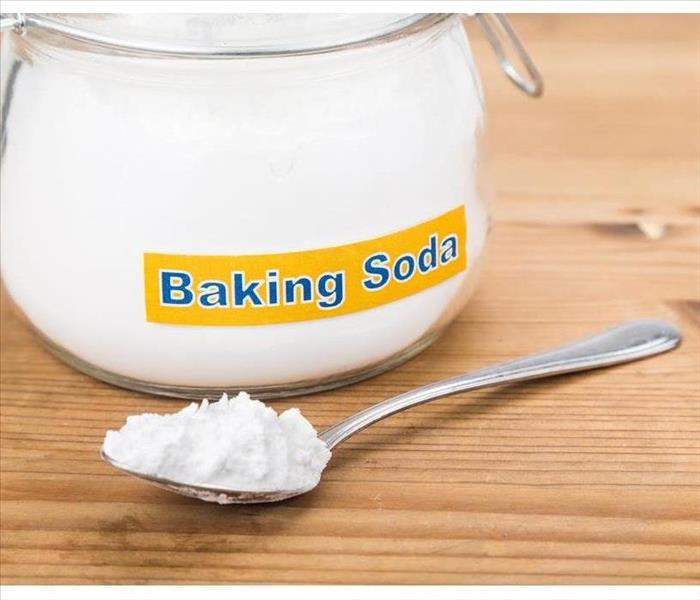 If you have a large supply of baking soda on hand, dump as much as you can on the grease fire
If you have a large supply of baking soda on hand, dump as much as you can on the grease fire
Five Methods to Quickly Extinguish a Fire
Oil can catch fire when cooking if frying food is left unattended, allowed to splatter, or heated to too high of a temperature. One of the most disastrous mistakes you can make when dealing with a grease fire in Unity Village, MO, is to try and use water to put out the flames as this will only make the fire spread. Instead, try any of the following five methods to quickly extinguish the fire before needing to call in the aid of the fire department and a fire cleanup company.
1. Turn Off the Heat
The first thing you should always do if grease catches fire while you are cooking is to turn off the heat. While you might be tempted to move the pot, leave it where it is.
2. Cover the Flames
If the fire is confined to a single pot or is only in a small area, covering it with an inflammable object like a metal lid can help put out the flames. Make sure not to use a glass lid that can shatter.
3. Baking Soda
If you have a large supply of baking soda on hand, dump as much as you can on the grease fire. The carbon dioxide released by baking soda helps to smother the fire.
4. Salt
Another effective way to put out a kitchen fire is to reach for the salt since it helps prevent the flames from accessing more oxygen. Typically, you require less salt to put out the fire than you need if using baking soda.
5.Fire Extinguisher
A fire extinguisher can be used as a last resort if you have one located nearby in your kitchen. Make sure to only use a Class B or K extinguisher to put out a fire caused by grease.
Experiencing a grease fire can be extremely frightening as the flames often spread quickly. Remember to put down the bucket of water and instead try one of these methods to safely extinguish the fire.
How Can a Fire End up Causing Water Problems?
6/27/2019 (Permalink)
 Fire and water damage in Kansas City, MO
Fire and water damage in Kansas City, MO
When you think of a fire, you probably consider water as the fastest, most effective way to put it out. Indeed, the right amount of water can make quick work of a blaze and reduce the amount of fire damage that could occur in your Kansas City, MO, office. But did you realize that while water is essential in fire suppression, it also can work against you? Because so much water is used to eliminate the flames, it's not uncommon for flooding and other related problems to ensue.
What Does It Hurt?
A fire in your place of business isn't something you want to think about ever happening. This disaster could cause harm and terrible damage in the workplace. While a fast-moving fire can quickly destroy parts of your building, water damage is often more gradual and even unnoticeable at first. Be aware of the following victims of flooding:
- Electronic equipment, including computers, printers and servers
- Furniture
- Documents, photographs, x-rays, blueprints
- Carpet
- Drywall
Built-in Sprinklers
A fire sprinkler system can be a wise investment for any business. This can be the first response to a blaze in the workplace and may help to get the incident under control before the fire crew even arrives. If you want to reduce the risk of fire damage, make sure you have a system and that it is in top-notch condition. However, these devices unleash a significant amount of water as soon as they sense a certain amount of heat. The volume of water coming from these sprinklers can ruin your floors and various materials.
Firefighting
The fire crew is essential to putting out the blaze, but each fire hose will put out as much as 500 gallons of water each minute. This can inflict tremendous damage to your office. While you're relieved the firefighters can eliminate the fire, their actions may require that you get in touch with a professional water removal company to help restore your office space.
Fire damage can be bad enough, but coupled with flooding, you face a big challenge. Make sure you call the pros to help you recover from these incidents.
4th of July Summer Safety Tips
6/24/2019 (Permalink)
 Celebrating the summer safely!
Celebrating the summer safely!
The 4th of July is one of the best times of the year in Missouri. Many people get together to celebrate freedom, friends, and food. Unfortunately, the holiday can also be dangerous due to different risks that are present. When trying to stay safe during the holiday, there are a few important safety tips to follow to protect yourself from harm.
Safety Tips
Handle Fireworks with Caution
To prevent injuries and fires that are caused by fireworks in the community, certain precautions should be taken. Never allow small children to get near fireworks or handle them. Adults should be the only ones lighting off the fireworks and should do so on the ground at a safe distance from trees or other objects. Keep a fire extinguisher close by and avoid lighting more than one firework at the same time.
Grill Safely
Grilling can also cause fires when you’re spending time flipping hamburgers and hot dogs outdoors. Look for leaks, holes, and cracks in the grill before you start using it on the 4th of July. Avoid grilling indoors or in an inclosed area. This can cause a fire to start and will lead to you to hire professionals such as SERVPRO of Raytown / East Kansas City to repair the damage. The grill should also be placed at least two feet away from the deck, branches, or the siding of the house.
Use a Pool Gate
Many people spend time in the pool cooling off from the warm temperatures in Missouri during the summer season. Keep it a safe activity by using a pool gate that will prevent children from getting into the water when they’re not supervised. Wireless outdoor sensors can also be installed to inform you if a child is near the pool. A first aid kit should also be on hand to tend to any injuries that can occur in the water. Kids should also use life jackets and floatation devices while swimming.
Practice Food Safety
Wash hands and clean the surfaces where you plan to prep food on the holiday. All meat should be cooked with a thermometer used to ensure that it reaches the right temperature to avoid food-borne illness. All leftovers should be refrigerated after two hours and not left outside. Toss out anything that sits outside for too long.
When trying to have a safe and memorable 4th of July, there are several safety practices to follow. With the right caution used, you can protect your family from harm and enjoy the day.
Responding to Primary and Secondary Water Damages
6/17/2019 (Permalink)
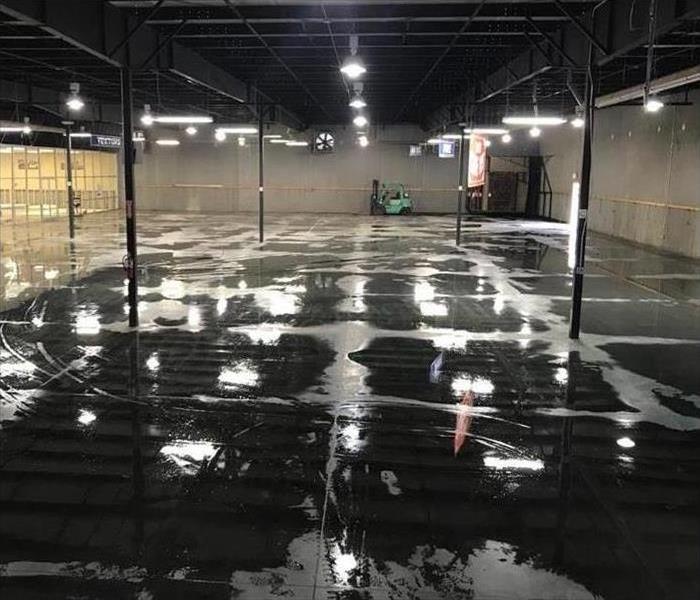 Commercial flood in Kansas City, MO
Commercial flood in Kansas City, MO
Responding to Primary and Secondary Water Damages
When a Kansas City, MO, property has been affected by high humidity, water leaks, or flooding, it's important to take steps to avoid secondary damage. In any of these situations and many others, the quick rush of water often leads to a quick rate of evaporation. This, in turn, saturates the air with humidity, and this high level of moisture in the air becomes responsible for the growth of black mold and other damages.
Primary Damages
This type of damage includes anything that happens at the type of the leak or flooding. It may include
- Broken pipes
- Waterlogged building materials
- Damaged furnishings
Secondary Damages
These include the harm done after the initial flood of water is over. Some examples of this are
- The growth of black mold
- Warped flooring
- Fabric degradation
As you prepared to address primary damages, it's important to recognize the potential for secondary harm and to take steps to prevent it.
Remove Water
Damage restoration efforts should begin as soon as possible when properties are affected by dripping faucets, burst pipes, or storm flooding. These efforts should include the use of commercial grade drying equipment, such as heaters and fans. Water restoration and cleanup professionals often have powerful extraction pumps to remove water quickly, reducing the risk of high humidity in the building. A quick, effective response is key to preventing moisture from spreading under walls and throughout porous materials in the building.
Reduce Moisture
Professionals may also use powerful dehumidifiers to take as much moisture out of the air as possible. This equipment quickly prevents condensation from moisture-rich air, further protecting rooms and belongings that hadn't yet been affected by the flooding. Finally, high-speed, high-volume fans should be installed throughout the affected area to constantly replace the humid air with dry air.
The growth of black mold is just one example of secondary damages that may affect your Kansas City, MO, property after any type of flooding. It's important to focus as much on preventing these follow-up damages as you do on responding to primary damages.
Is Your Shower Leaking?
6/10/2019 (Permalink)
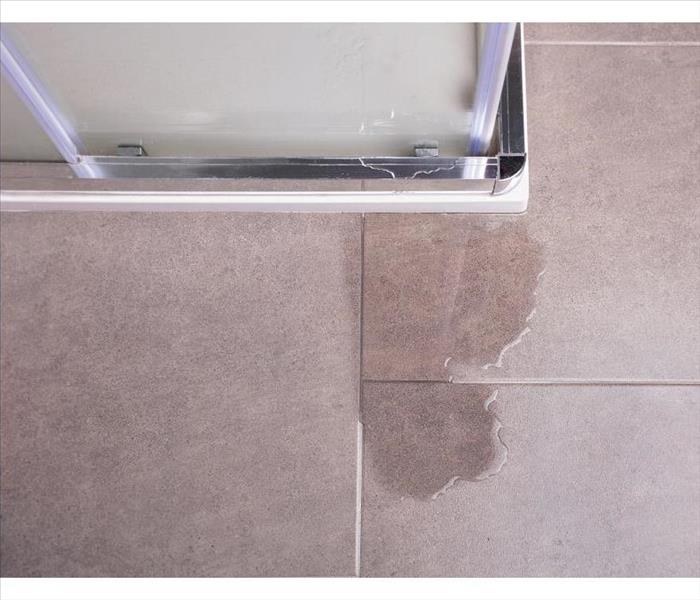 Shower leaking
Shower leaking
Is your shower showing signs of age, or are you moving into a home with a dated bathroom in Raytown, MO? It’s okay to be suspicious of bigger problems such as a bathtub leak. You should make it a priority to inspect for any leaks before water damage or mold moves into your bathroom.
Eliminate All Other Possibilities
First you need to figure out whether the leak is coming from your shower or another water source. If you have observed water on the floor, try to clean up as much of the water as you can so that you can follow the water as it builds again. Try flushing the toilet to see if anything happens underneath it. Run the water and check below the sink. Some possibilities in your bathroom other than a shower or bathtub leak may include:
- Loose bolts beneath your toilet
- Damaged wax gasket in your toilet
- Damaged supply line
- Leaky faucet
Look For Water Damage
Without taking apart your shower, the easiest way to determine a bathroom leak is to look for water damage below your shower. If you go to the floor below your bathroom, do you notice any spots on the ceiling? You can also look for water damage on your baseboards in your bathroom or adjacent rooms. If you see mold, this may indicate you have had a shower or bathtub leak for a while.
Fix the Problem
If you have discovered water damage near your shower, the most likely culprit is a shower pan leak. You will want to call a professional water damage service to inspect it, as the pan is difficult to access. Specialists follow a specific test procedure and can replace your pan for you if needed. Shower pans older than 30 years tend to wear out or may have been cracked during installation.
A shower pan leak can be sneaky, but if you know what you look for, you can sort out the problem before more costly damage takes hold. If you notice water damage in or around your bathroom, get it checked out.
How To Keep Mold Out of Your Swamp Cooler
5/23/2019 (Permalink)
 Leaking swamp cooler
Leaking swamp cooler
If you live in Unity Village, MO, or in any arid region like the Southwestern United States, you probably know what a leaking swamp cooler is. These home-cooling units are incredibly cost-efficient and effective but can cultivate mold if not maintained properly. Luckily, it’s easy to prevent.
Why Swamp Coolers?
Mold reproduces via microscopic airborne spores that are invisible to the naked eye until they start breeding a colony. They only need the following to multiply:
- Air
- Water
- Any moisture source
A swamp cooler is the perfect combination of the above. It uses the process of evaporation to cool moistened cellulose pads, runs warm air over them to cool it down and then distributes the cooled air throughout your home, essentially creating humidity. Even better for mold is a leaking swamp cooler. This not only provides a great place to breed mold but also an efficient system for spreading mold throughout the rest of your house.
Preventative Measures
Make sure to open your windows every once-in-a-while to circulate dry air throughout your home. Check your unit often for visible mold, a musty smell or leaks. Be sure to follow all recommended maintenance schedules.
Mold Removal
If you’ve already found mold in your swamp cooler, don’t panic. There are solutions short of replacing the entire unit. If your cellulose pad is infested, you can replace it, and the rest of the components can be cleaned. If you have a leaking swamp cooler, it will need to be repaired. If the mold has spread from the swamp cooler to your air ducts, you should enlist the help of professional mold remediation services because any personal attempts to contain mold damage already in your home could end up spreading it further.
Swamp coolers are a great way to cool your home in a hot, dry place. However, the moisture they introduce can encourage mold growth. Keep an eye on your unit to prevent any mold damage to your home.
3 Things Homeowners Should Know About Natural Gas Fires
5/15/2019 (Permalink)
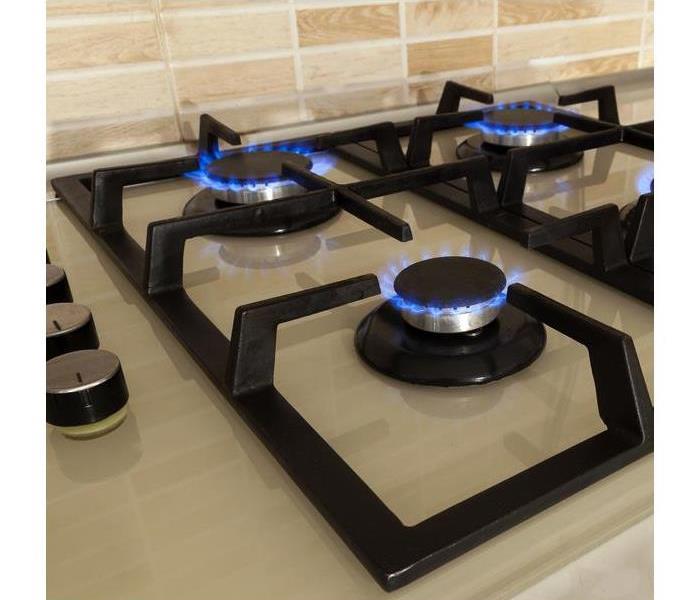 Being able to identify a gas leak can help you to prevent a fire from occurring in your home
Being able to identify a gas leak can help you to prevent a fire from occurring in your home
Learning About Natural Gas Fires
A home in Kansas City, MO, that experiences a gas fire can sustain catastrophic damage. Learning about natural gas fires can be helpful to homeowners who want to protect their homes.
1. The Signs of a Gas Leak
Being able to identify a gas leak can help you to prevent a fire from occurring in your home. One of the most common signs of a gas leak is the unpleasant odor that is often described as smelling like eggs. Hearing an unexplained hissing noise is also another common sign that your home may have a gas leak.
2. How To React
In addition to knowing the signs of a gas leak, it’s also helpful to know how to react if you suspect there is a gas leak in your home. If you think there may be a gas leak in your home, it’s generally wise not to turn on any lights or other appliances that use electricity, as they could spark a fire. In order to keep yourself safe if a gas fire does occur, it’s often important to evacuate your home and to call emergency services.
3. How To Avoid a Fire or Explosion
When a gas explosion or fire occurs, it’s often helpful to receive help from fire damage restoration experts. However, it’s generally best to prevent an explosion or fire rather than having to deal with the effects of a fire. In order to decrease the chance of a fire or explosion, it can be useful to turn off all appliances after using them. Additionally, it can be helpful to know where you gas meter is located in case the gas needs to be turned off in an emergency.
Knowing important information about natural gas fires can help homeowners feel more confident in their ability to keep their homes safe. It can be useful to know the signs of a gas leak, how to react if a leak does occur and how to prevent a gas fire or an explosion.
5 Questions and Answers About Commercial Flood Insurance
5/8/2019 (Permalink)
 Flood insurance protection is something your business needs
Flood insurance protection is something your business needs
Flood Insurance Protection is Something Your Business Needs
As a business owner, you understand the need to identify as many potential risks as possible and prepare solutions for them. While you may hope flooding won't happen, it's best to plan for the possibility. With this understanding, you may want to consider whether flood insurance protection is something your business needs.
1. Doesn't my insurance already cover flood damage?
No, damage that results from flooding isn't included in typical commercial insurance policies. You need to add separate coverage to get this protection. Talk to your insurance representative or contact the federal government about this type of business protection.
2. How can I tell if I need insurance?
Your location in Raytown, MO, is the most important factor in establishing your risk and determining whether to purchase flood insurance. There are several tools online with flood map search tools. You can also get valuable advice from storm damage remediation professionals in your area.
3. What does the insurance cover?
This type of insurance policy generally covers flood-related damage to your building and its contents. You may receive this protection if your property is affected by overflowing waterways, heavy rainfall, broken dams, blocked drainage systems, and similar causes of high water.
4. How long does it take to establish coverage?
Many insurance providers require a 30-day waiting period after you've made a purchase before the policy goes into effect. As a result, it's important to prepare for flooding before it happens. If your business is at risk, talk to an insurance provider as soon as possible to determine the best coverage.
5. Is there anything the insurance doesn't cover?
There are several things that may not be covered, including property outside of the building, such as landscaping, septic systems, and business vehicles. Talk to your insurance representative to learn how you can keep these items protected.
Flood insurance isn't a necessity for every business, but the time to determine your level of risk is before heavy rainfall. Do your research in advance, so you can be sure you have the proper coverage when the time comes.
How To Restore a Basement or Crawlspace After Flooding
4/22/2019 (Permalink)
 A wet dry vac can be used to get rid of standing water
A wet dry vac can be used to get rid of standing water
In the aftermath of flooding in Raytown, MO, the basements or crawlspaces of homes may be filled with standing water. Allowing this water to stand will increase the risk of mold growth and may result in structural damage. Homeowners can rent home flood relief equipment or rely on the expertise and equipment of a restoration company.
Extract Water
It is important to eliminate any water remaining under a home after a flood or other storm damage. Several types of equipment work well for this purpose:
It may be difficult to reach some portions of a crawlspace. A push broom with an extended handle can be used to move water to places where it can be vacuumed. A portable, submersible sump pump is useful for removing standing water from crawlspaces.
Dry the Area
A home flood can cause extensive primary damage, but excessive moisture in any portion of a residence may lead to mold growth. It is important to completely dry out a basement or crawlspace. Specialized equipment is also useful during this stage of restoration:
- Air movers
- Fans
- Dehumidifiers
It may take several days for an area exposed to flood water to dry completely. It is important not to rush restoration, as replacing building materials or performing repairs in a damp environment may elevate the risk of structural damage or mold
Prevent Future Floods
If flooding is common in an area, a homeowner should have a working sump pump in the basement or crawlspace of his or her home. Other plumbing equipment such as a backflow valve, floor drain plug, standpipe or overhead sewer may also be helpful for avoiding a sewage backup.
These measures may reduce the risk of damage resulting from a home flood. If flooding occurs frequently in Raytown, MO, homeowners should take preventative measures to keep water from accumulating under houses.
Water Damage Prevention and Cleanup Tips From the Pros
4/16/2019 (Permalink)
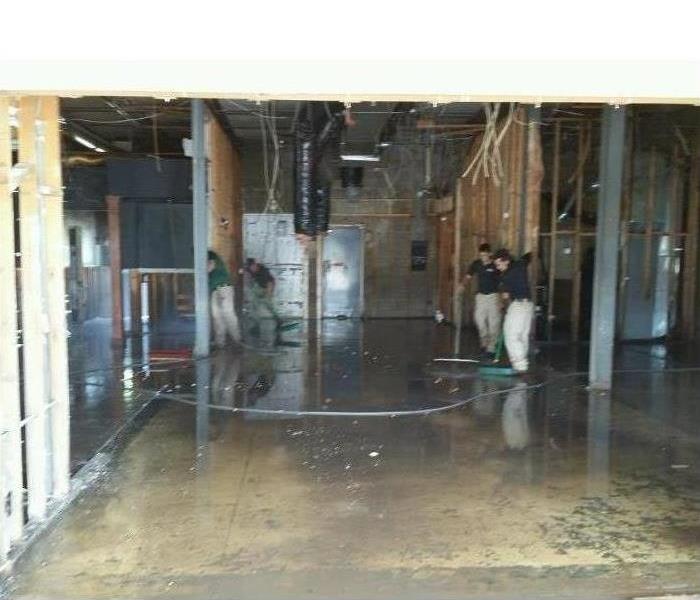 Water removal in a Unity Village, MO building
Water removal in a Unity Village, MO building
The day you walk into work in your Unity Village, MO, office and spot water on the floor or in the walls or ceiling is not a good day at all. Even the most minor water damage can disrupt your business and eat up valuable time and money. There are some things you can do to avoid a pipe burst cleanup. Even if flooding does occur, a reputable water removal company is just a call away to get your office back to normal in no time.
How to Prevent Water Issues
You can’t completely avoid all emergencies all of the time, but there are some tried-and-true tips you can follow to increase your chances of avoiding water cleanup. Some of these include:
- Have a qualified plumber regularly check all the pipes and supply lines in your building.
- Make sure downspouts and rain gutter divert water away from the foundation of your building.
- Inspect the roof annually.
Professional Help
Even after your best efforts, supply line leaking and other issues can lead to flooding. Luckily, a water damage cleanup company can help remove water from the premises. A professional team of technicians has both the experience and skill to correct the problem and help ensure that it doesn’t happen again.
Inspect and Assess
The team will begin by evaluating the cause of the flood and what led to the pipe burst cleanup or other issues. Next, the techs will formulate a plan for cleanup and restoration. The team will also make recommendations on how to fortify your pipes and supply lines.
Cleanup Process
The crew will use commercial-grade extraction machines and dryers to remove all water and dry out the affected area. Just as importantly, the team will sanitize and disinfect the area, which is critical, especially if black water made its way into your building.
Pipe burst cleanup jobs come with extensive damage and messes. Fortunately, you can help guard against these and hire the right professionals.
How To Eliminate Mold In Ductwork
4/11/2019 (Permalink)
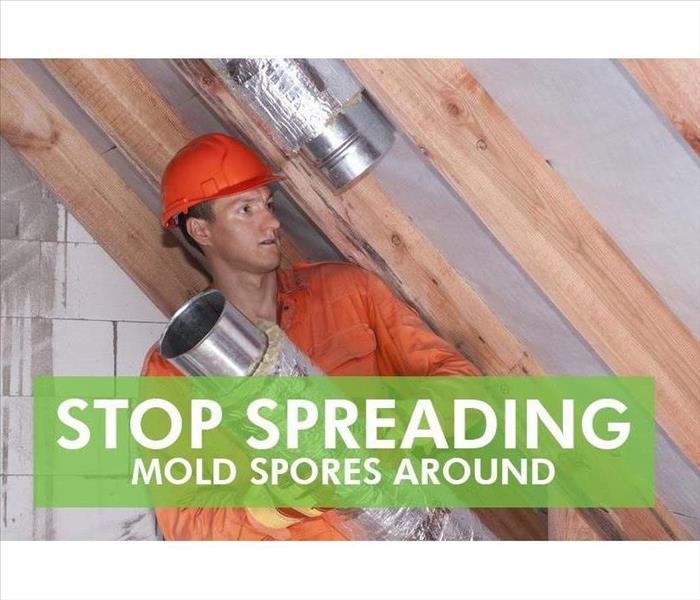 Mold spores can travel on the air currents throughout your home or business
Mold spores can travel on the air currents throughout your home or business
How To Eliminate Mold In Ductwork
High levels of moisture can cause mold to start growing inside HVAC ducts. Almost any type of mold, including black mold, can be supported by dust and debris inside of a heating and cooling system. Spores can spread throughout a structure through air ducts. If a musty odor is present or mold growth is evident, building owners or managers should take these three steps.
1. Locate the Source of Moisture
A building owner or manager should contact an HVAC specialist to identify the source of moisture and resolve the problem before scheduling a duct cleaning. Excessive moisture or mold growth may be evident in condensate drip pans, coils or terminal units. It is also possible that a plumbing or roof leak is introducing water directly into ductwork.
2. Clean the Air Ducts
A duct cleaning company can eliminate many types of mold. These services typically use high-powered vacuums to clean ducts. If black mold or signs of severe contamination are present, a property owner or manager may also want to consult with an indoor environmental professional. More extensive remediation work may be necessary if mold has spread beyond ducts.
3. Inhibit the Mold Growth
A duct cleaning company may also apply a mold inhibitor rated for HVAC use. This treatment can help to prevent mold from returning even if moisture levels increase. Property owners should keep moisture low by taking measures to prevent and quickly fix leaks, maintaining the HVAC system and ensuring that indoor relative humidity levels remain between 30 percent and 50 percent.
These measures can help eliminate the presence of mold growth from ductwork and prevent fungus from returning. If black mold is found or there is a significant chance that mold has spread to other parts of a structure, a property owner or manager should also contact a mold cleanup and remediation company in Kansas City, MO.
4 Different Types of House Mold You Should Be Aware Of
4/4/2019 (Permalink)
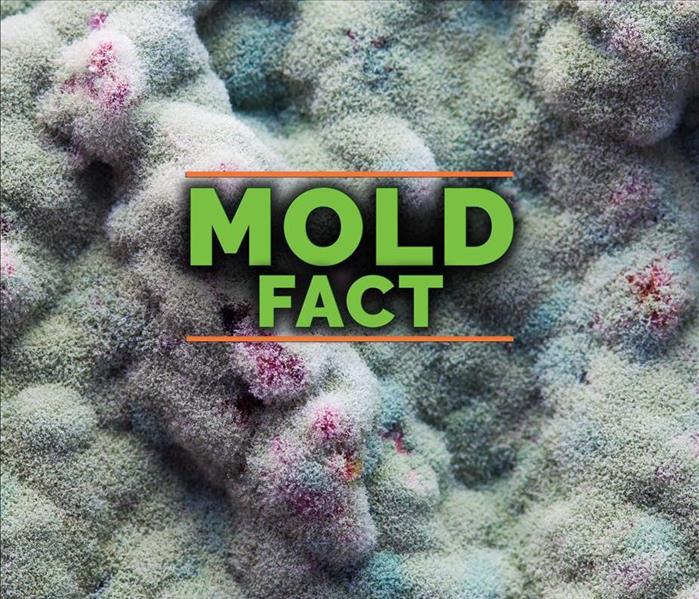 Aspergillus Niger is green and pink mold.
Aspergillus Niger is green and pink mold.
4 Common Types of Mold You Should be Aware of
Mold in any form is frustrating to deal with and finding some in your home in Raytown, MO, can be devastating to discover. If you do find mold growth in your home, knowing what kind of mold you’re dealing with is an important first step in identifying possible causes for the issue and knowing what line of action to take. Here are four common types of pesky house molds you should be aware of.
1. Aspergillus
This type of mold is one of the most common types you’ll find in your home, and there are over 185 species of this mold that exist. You’ll likely find this type of mold in either yellow, green, or black. It often grows in home air conditioning systems and on food.
2. Cladosporium
If your home has recently undergone any water damage, you might find a black, gray, brown, or olive-green mold growing on your walls, insulation, or carpet. There are more than 30 species of Cladosporium, including an outdoor variety that can be found on plant leaves. This species of mold can also be found on toilets and fiberglass air ducts.
3. Acremonium
The most common strains of Acremonium found within the home include Acremonium strictum and A. charticola. This mold is often caused by high humidity and will look powdery when found. It is commonly found on mattresses, wet walls, wallpaper, and air conditioning systems.
4. Stachybotrys
Stachybotrys chartarum is the most common strain of this type of mold and is often referred to as “black mold.” As the name suggests, it often has a black appearance. Black mold growth occurs in extremely wet and humid areas and is often found on ceilings and walls.
While some molds might be more notorious than others, every type of mold growth you find in your home needs to be dealt with promptly. A mold removal specialist will be able to easily identify the mold found in your home and will know exactly how to remove it.
3 Helpful Tips To Minimize Residential Water Damage
4/4/2019 (Permalink)
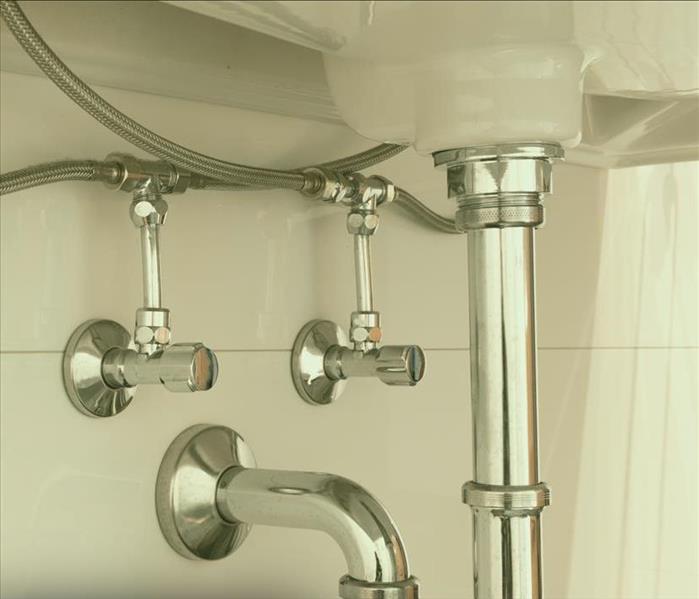 Regurlarly check under sinks and fridges for water buildup
Regurlarly check under sinks and fridges for water buildup
3 Helpful Tips To Minimize Residential Water Damage
Plumbing lines allow convenient access to water in your home. However, a variety of situations can leave your pipes susceptible to damage, increasing the risk of potentially destructive leaks. Fortunately, there are several measures you can take to safeguard your residence with water damage repair services.
1. Protect Your Pipes During the Winter
Frigid winter temperatures can wreak havoc on pipes. Supply lines located in uninsulated rooms or adjacent to exterior walls may be particularly prone to freezing and bursts. To minimize the risk of a broken pipe, you should insulate exposed plumbing structures in your garage, basement and other cold zones inside your residence. You can also circulate warmer air around bathroom and kitchen pipes by opening cabinet doors.
2. Routinely Inspect for Leaks
Water in your home flows to numerous appliances as well as bathroom and kitchen fixtures. Over time, connections can loosen, and supply lines can crack. To help prevent extensive water damage and mold contamination, you should routinely check under your dishwasher and around your washing machine and refrigerator for pooled fluid or dampness and promptly commence any necessary repairs. You should also regularly inspect around toilets and under kitchen and bathroom sinks.
3. Avoid Chemical Drain Cleaners
Clogs are a frustrating plumbing issue that can sometimes be difficult to clear. While it may be tempting to use a chemical solution to perform a pipe cleanup, drain cleaners can corrode or warp both metal and plastic tubes, making them vulnerable to cracks and leaks. To safeguard your home’s water lines, you should use a safer alternative to clear obstructions, such as an auger snake or a plunger.
Like most homeowners in Kansas City, MO, you may rarely worry about a broken pipe and unexpected water in your home. Seepage from damaged lines can, however, cause extensive destruction. Taking proactive steps can help you protect your home’s plumbing infrastructure and avoid a messy cleanup.
Benefits of Becoming Preferred Vendors
4/4/2019 (Permalink)
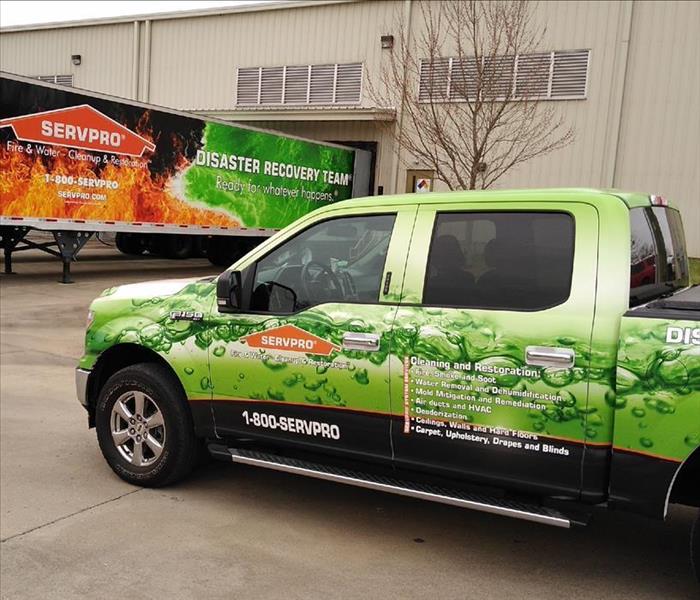 SERVPRO leader in fire, water and mold restoration
SERVPRO leader in fire, water and mold restoration
Leaders in the cleanup and restoration community work to maintain performance guidelines and standards. Those guidelines assure Unity Village, MO, consumers and other industry professionals that the best restoration practices are followed during cleanup and remediation procedures. To maintain a reputation for having the top-quality services, vendors must maintain compliance with professional qualifications. This compliance can then reassure the insurance agent that the cleanup technicians will keep costs down without sacrificing quality.
Why Technicians Belong to Vendor Programs
SERVPRO participates in a qualified vendor program and, as a result, can offer several valuable resources.
- A National Call Center for quick completion of claims
- Best practices and job process implementation
- Annual qualification criteria compliance checks
- Standards for crews and vehicles
- File documentation and insurance requirements
- Strict quality assurance program
As part of SERVPRO's participation in this program, all professionals agree to abide by 21 different guidelines. Those requirements run the gamut from insurance coverage to background checks on employees. Ongoing checks and inspections ensure that clients receive the best service from cleanup and restoration technicians.
Resources to Improve Services
When a consumer or insurance agent contacts SERVPRO, each step of the process can be tracked and reported. This begins with the first phone call reporting the loss and continues until the documents are completed by the Claims Information Center.
To further improve the services provided by cleanup and restoration professionals, the company has obtained IICRC validation for proper drying techniques and equipment use. A Claims Information Center speeds up claim response times and provides comprehensive reporting information.
Improvements for All Parties
With access to plenty of franchise resources, professionals and technicians have the right qualifications to provide top-quality work while keeping claims costs down. The requirements that cover emergency response calls, pretesting efforts, claims inventory procedures, and electronic claims make it easier for a Unity Village, MO, insurance agent to bring open processes to a close.
Why Choose SERVPRO Fire Restoration for your Raytown/East Kansas City Home
3/21/2019 (Permalink)
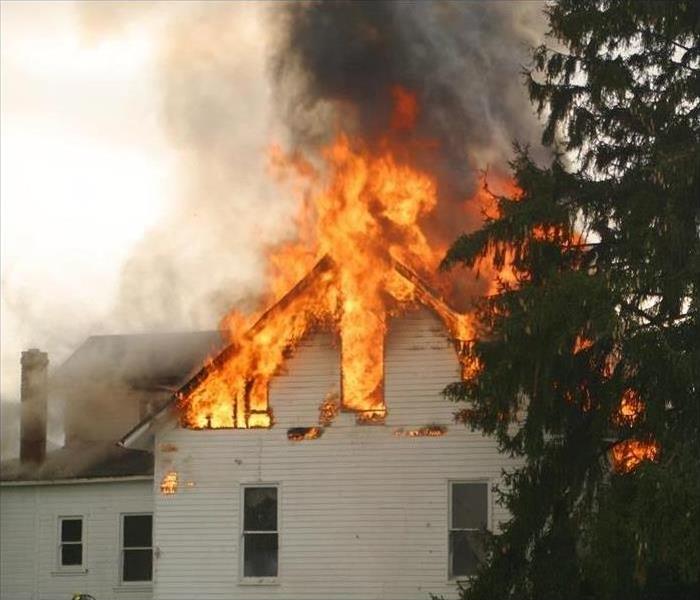 The professionals at SERVPRO can thoroughly clean smoke and odor residues left behind after a fire.
The professionals at SERVPRO can thoroughly clean smoke and odor residues left behind after a fire.
Fire Restoration
A fire in your Raytown/East Kansas City residence can leave you unsure of how to save the contents of your home and preserve its structural integrity. Most homeowners can concede that restoring the damage to their home is simply too great a task to handle on their own and choose to seek out reputable and experienced restoration professionals instead.
Finding the right professionals to handle the fire damage in your Raytown/East Kansas City residence boils down to which reputable company is willing to ensure that the job gets done safely, correctly, and above all else, efficiently. While there might be several options you can choose from, here are some considerations that might set our SERVPRO team apart.
Rapid response times help to mitigate damages that your home experiences even after a fire have gotten extinguished. This pre-emptive effort helps to keep overall restoration costs down and limits the amount of time the process takes overall. One of our SERVPRO mottos is to be Faster To Any Size Disaster, which is more than just a catchphrase.
Another process that sets our restoration team apart from some of the other options that exist for you to choose is our commitment to the contents of your house. We work quickly to determine at-risk items and remove them from the affected areas of your home for faster and more concentrated restoration efforts, but also to keep further damages from occurring to the items themselves.
These items get cleaned and deodorized individually, along with closer inspection to determine their need for restoration. Once the project nears completion in your home, these cleaned and restored individual items removed from your house get returned to their original positions.
There are many companies that you can choose from when it comes to fire restoration in your home. Our crew works to provide the best quality service encompassing the work that we do in your home and our commitment to providing the best in customer consideration. If you experience a fire in your home, trust our SERVPRO of Raytown/East Kansas City team to help you get things back to pre-damage condition. Give SERVPRO a call anytime at (816) 737-8776.
The Importance of Pretesting for Water Categories
3/8/2019 (Permalink)
Water Damage Claim
Anyone who has experienced flooding is likely familiar with the various colors associated with floodwaters: white/clear, gray and black. These colors are often tied to a category and a classification which specifies the amount of safety precautions necessary and the level of mitigation and clean out. When filing a claim, it is critical to know the category and classification because each ascending level impacts the severity and costs of damage. Therefore, pretesting is used to designate the category and classification of water to ensure that claims and restorative preparations are efficient and accurate.
1. Category One
When filing an insurance claim, category one, or white/clear, water is the least expensive to remedy. The source is sanitary, meaning that there is no harmful bacteria or sewage present. While this category can be a relief, it is still necessary to act quickly to remove the water and repair the damage. If the water sits for too long, it can be contaminated by other items in the area, causing an elevation in category or classification.
2. Category Two
If the water is found to be category two, or grey water, through pretesting, then it is best that you do not go near it. This result indicates that there are organic and inorganic substances in the water and that you may become ill if it is consumed or touched.
3. Category Three
Category three, or black water, is the most dangerous water. The level of contamination includes sewage, chemicals, bacteria and possible toxins. It is likely that your insurance agent and company will recommend a disaster restoration specialist in the Raytown, MO area who will probably seal the space as they work to remove the water safely.
Insurance claims require accurate representations of the damage to a property. Pretesting provides those assessments for insurers by providing definitive information about the category and classification of the water and damage to your home.
Storm Season to Come to Raytown/East Kansas City, MO. Are You Ready?
3/4/2019 (Permalink)
Water Damage and how SERVPRO of Raytown/East Kansas City can help.
Within Minutes:
- Water quickly spreads throughout your property, saturating everything in its path.
- Water is absorbed into walls, floors, upholstery, and belongings.
- Furniture finishes may bleed, causing permanent staining on carpets.
- Photographs, books, and other paper goods start to swell and warp.
Hours 1 - 24:
- Drywall begins to swell and break down.
- Metal surfaces begin to tarnish.
- Furniture begins to swell and crack.
- Dyes and inks from cloth and paper goods spread and stain.
- A musty odor appears.
- ed into walls, floors, upholstery, and belongings.
- Furniture finishes may bleed, causing permanent staining on carpets.
- Photographs, books, and other paper goods start to swell and warp.
For help restoring your residential or commercial property after a water loss, call SERVPRO of Raytown/East Kansas City at 816-737-8776.
We’ll make it “Like it never even happened.”
Mold Prevention that Works
2/20/2019 (Permalink)
Although there are a variety of challenges that residential and commercial property owners can experience, the presence of mold is particularly problematic. This is the case for many reasons, including the fact that mold can cause health problems and decrease the structural integrity of one’s property. There are ways to prevent the growth of mold, but your best course of action is hiring a professional mold remediation company.
Try implementing some or all of the following six mold prevention tips:
- Invest In A Dehumidification System.
One of the best ways to prevent the growth and proliferation of mold is to invest in an air conditioner that features a dehumidification system. These systems are effective in removing moisture from your property. Once the moisture is removed, the mold is deprived of one of the vital nutrients that help it grow.
- Be Cautious When Turning The AC Off.
Make sure that you are cautious when you turn off your air conditioner. In climates that are humid, a long-standing period of inactivity can enable humidity levels to become dangerously high. If the humidity level becomes extremely high, it creates the moist environment necessary for mold to grow and thrive.
- Use Insulation.
Another strategy you can use to prevent mold is the use of insulation. By installing insulation as well as vapor barriers, you can prevent condensation from accumulating on objects like plumbing fixtures, beams, and water pipes.
- Avoid Standing Water.
Stagnant water can become a breeding area for mold. Since this is the case, make sure that you keep your tubs, showers, sinks and all other wet regions of your property free of standing water.
- Review Your Applications.
Another strategy for mold prevention is application review. Make sure that all of your construction, design, and architectural applications are effective in preventing water from coming in contact with the interior of your property and goods. Specific regions of concern include poorly designed balconies, pitched roofs, improperly installed flashing, doors, windows, thin stucco, and vapor barriers.
- Maintain Structure Regularly.
One final way to help prevent mold growth is to ensure that the integrity of your building envelope is maintained. You can achieve this objective by investing in regular roof flashing, caulking, sealing, and inspections of the exterior.
Mold can be a severe problem for residential and commercial property owners to handle. However, using the prevention tips and tricks outlined above can help you keep your property mold-free. In the event that mold growth does transpire, call a professional restoration company. They have extensive experience in the mold remediation field and can assist with your mold restoration needs.
The Restoration Company for All Insurance Adjusters
2/8/2019 (Permalink)
As a leader in fire and water cleanup and restoration, SERVPRO of Raytown/East Kansas City offers your insurance company an array of competitive advantages. Our goal is to restore both your customer’s property and their peace of mind through timely mitigation and adherence to IICRC standards. The result? Lower claims costs and satisfied customers – and that’s just the tip of the iceberg.
SERVPRO of Raytown/East Kansas City is uniquely qualified to help. Our results create a measurable difference, giving you many competitive advantages. We understand your situation. As an agent or adjuster, you have a responsibility to keep claims costs down while still providing the best services possible for your customers.
Emergency Response to Claims
Restoring property is our first priority. Your customer will appreciate the immediate response and you will know everything is being done to limit the damage.
Pretesting Reduces Claims Expense
Restoring property is less expensive than replacing property. Claims Professionals know the rule is, "Restore whenever possible, replace only when necessary." Our highly-trained professionals make sure pretesting is completed on every loss to determine restorability.
Claims Inventory Service
At SERVPRO of Raytown/East Kansas City we can provide an itemized loss inventory. You will receive a link to an inventory site that will provide pictures of important items and the status of the contents in the cleaning process.
Electronic Claims Information
Our Claims Information Center provides fast, accurate information you need to make sound decisions, including:
- A Complete Electronic Job File
- First Notice of Loss
- Detailed Estimate
- Digital Loss Photos
- Scanned Forms and Paperwork
- All delivered by email or hard copy
- On-line Access to All Files
- New Assignments
- Pending Jobs
- Completed Jobs
- Informative Reports to Improve Results
- Performance Comparison to Industry Standard
Superior, Time-Tested Training
Effective training is the best way to help ensure your customers receive the service they deserve. Our staff is trained to IICRC standards in Fire and Water Cleanup and Restoration. In addition, continuing education classes are available to all SERVPRO Franchise Professionals at SERVPRO Industries, Inc.'s state of the art IICRC Approved Training Facility.
Vendor Qualification Compliance and Professionalism
If you call SERVPRO of Raytown/East Kansas City, we will use only qualified vendors to service your customer. That commitment resulted in:
- A National Call Center to achieve prompt handling of the claim
- Implementation of best practices and job process programs
- National Accounts qualification criteria and annual compliance checks
- Crew and vehicle standards
- Insurance requirements
- File documentation requirements
- Quality assurance program
Serving Adjusters and Their Clients
Our job is to reassure the customer, perform quality service and to report to you quickly. We know your job is to interpret the policy and adjust the claim and not to deal with problems from vendors. Working together we strive to save you time so you can focus on priority files, while having complete control of every loss you are assigned. 24-hour emergency response, damage mitigation, loss assessment, and an electronic file are available to you within hours. Our documented, measured performance increases value to you and your shareholders, managers and customers.
Hard-earned results have made SERVPRO of Raytown/East Kansas City a leader in the fire and water cleanup and restoration industry. The SERVPRO System is geared to achieve customer satisfaction and mitigation results, adding to your company’s competitive advantage.
Call SERVPRO of Raytown/East Kansas City today at 816-737-8776!
Ice Damming; What is it?
2/7/2019 (Permalink)
Weather is often the most obvious culprit behind a host of problems including building or structural damage, injuries, mold growth, water damage or flood.
An ice dam is a common occurrence in winter in areas where snow is in plenty such as the Hereford Zone. Basically, an ice dam refers to build-up of ice on sloped roofs’ edges of heated buildings. The build up occurs when melting snow beneath a snow pack reaches the roof edge or eave and freezes there.
The frozen snow on the eave prevents the meltwater drainage that further builds the ice dam. The backup of meltwater causes water leakage and structural damage to buildings and their contents. Ice dams can also damage ceilings, walls, insulation and other areas. When there are areas of dampness, the risk of mold growth is also high.
What causes ice dams?
Along with snow, the outside surface temperature on the roof should be more than 32 degrees F with lower surfaces on the roof being less than 32. When outer surface temperature is more than 32, the snow begins to melt. The melted snow flows down into the roof and reaches the lower surface where the temperature is less than 32 and here is where it freezes forming an ice dam.
Sources of heat within the building lead to formation of ice dams include:
- Chimneys
- Air leakage
- Improper insulation
- Exhaust systems
Ice dams and injuries
Ice dams can cause serious injuries and some businesses and homeowners have experienced property damage up to $20,000 because of this phenomenon.
Many of the claims are because of property damage that occurred due to pooled water in the ice dam or roofs collapsing.
Why choose SERVPRO? SERVPRO is the leading specialist in water removal and clean-up when your property or structure is at high risk of damage from ice damming or water leaks. With state-of-the-art drying techniques and water removal equipment, SERVPRO can help restore the building to its original glory.
Get Your Business Back in Action
2/5/2019 (Permalink)
Flooding and water damage events in Raytown/East Kansas City commercial properties are often complex with numerous issues that require a knowledgeable and flexible response. Whether we're dealing with a small water cleanup or a large scale water event, we work quickly to assess each unique situation and isolate the damaged area. In many instances, normal operations can continue in a temporary space while we restore your facility.
Restoring Commercial Properties Presents Unique Challenges
Our professionals are trained to be mindful of legal and environmental concerns and strive to fully restore the damaged area while working within your budget. We understand that every hour spent cleaning up is an hour lost revenue & productivity. So when an emergency situation arises in your business, give us a call and we'll be there fast with the help you need.
About SERVPRO of Raytown/East Kansas City
SERVPRO of Raytown/East Kansas City specializes in the cleanup and restoration of commercial and residential property after a water damage event. Our staff is highly trained and certified in property damage restoration. From initial and ongoing training at SERVPRO's corporate training facility to regular IICRC-industry certification, rest assured our staff is equipped with the knowledge to restore your property!
Understand our Terms and Lingo
1/23/2019 (Permalink)
 Terms used in the Insurance Industry by restoration professionals.
Terms used in the Insurance Industry by restoration professionals.
SERVPRO of Raytown/East Kansas City is always "Here to Help". We know the jargon can be confusing so we usually try to break it down as easy as we can out in the field, but we know that our customers like to stay informed. Here are some common terms used in the field with their definition so you can understand better what is happening in your home or business.
Anti-Microbials: A substance, mechanism, or condition that inhibits the growth or existence of an organism.Commonly applied after a water damage to prevent mold from developing.
Fire Damage Recovery: The process of restoring and recovering property and belongings after a fire. The objectives include minimizing existing damage, damage mitigation, structure stabilization, soot & odor removal and reconstruction.
Fungi: The unicellular or multicellular eukaryotic/ DNA organisms embracing a large group of microflora including: molds, mildews, yeasts, mushrooms, rusts and smuts.
HVAC: Heating, ventilation and air conditioning.
HEPA Filter: High efficiency particulate air filter, a specialized filter capable of removing 99.7% of particles. Commonly used in mold or odor job sites. HEPA Vacuum or HEPA air scrubber.
Masking Agents: Designed to prevent or remove heightened awareness to odors by providing a fragrance, which is stronger and more pleasant to smell while the source of the odor is being eliminated.
Smoke Damage Removal: Neutralizing or removing smoke odors that linger after fires.
Smoke Particles: Smoke is composed of gases / sometimes aerosols, and airborne solids. Dry wood, natural fibers and paper all produce small non-smearing material. Plastic, foam, and rubber (polymers) produce large easily smeared residues.
The Difference Between Storm and Flood Damage
1/9/2019 (Permalink)
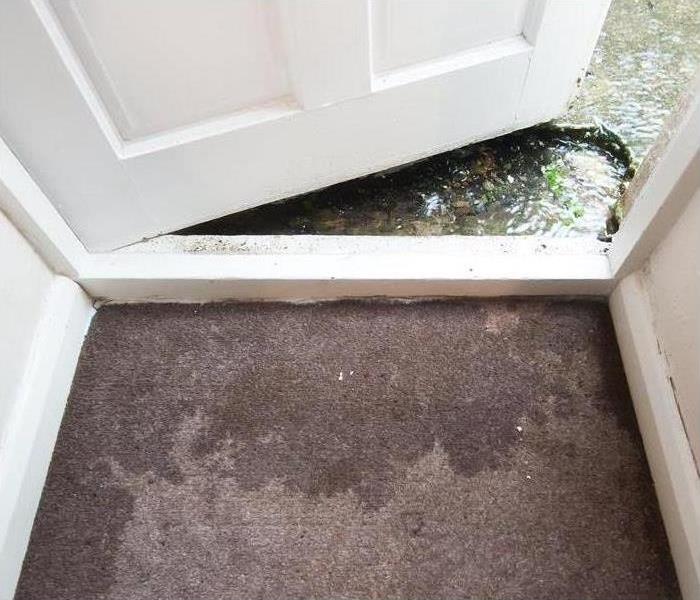
With the rainy season beginning in Raytown/East Kansas City, MO, it’s important to understand the difference between storm and flood damage so you can protect your commercial property appropriately. Two key differences can help you prepare your property ahead of time and understand what you can do now to prevent extensive damage.
1. Storm Damage Is Not Exclusively Due to Water
Property damage resulting from a storm is all encompassing. Yes, there tend to be rain and flood watches during storms, but there are other concerns that should be on your radar. Wind gusts can pose a threat to the structure, particularly when there are strong gales that are seen in tornadoes and hurricanes. High winds can also result in flying debris, toppled trees and structural damage in more serious cases.
Ensuring that windows are boarded and trees are planted a reasonable distance from the structure are smart practices to help prevent damage due to a storm. Also, routinely checking the roof and HVAC system to make sure they are sealed properly can prevent future storm damage as well.
2. Flood Damage Is Not Exclusively Due to a Storm
Commercial property owners tend to associate flooding with heavy rain storms. While those storms can play a large role in flood issues, there are other instances where floods can damage the office space. The plumbing can be a common culprit, so ensuring all pipe work is in the best possible shape and having proper sealants on pipes can help you avoid these types of flood hazards. Water damage from a flood can result in ruined carpeting and weakened floors or walls if the water stands for an extended period.
Understanding the difference between storm and flood damage will help you know all the risks your commercial property may face, as well as how to prepare. If your commercial space in Raytown/East Kansas City, MO, does ever suffer harm from floods or storms, contact restoration professionals to make your space like new.
Water Heaters
12/31/2018 (Permalink)
SERVPRO of Raytown/East Kansas City has seen countless water heaters cause damage inside homes. A water heater’s useful life varies, depending on the type of water heater, the quality of the unit, and how well it’s been maintained. As long as it’s still heating water sufficiently, without leaks or strange noises, you might still get a few more years of service from it.
A traditional tank-type water has a life span of around 8 to 12 years. An anode rod protects the interior lining by attracting all corrosive particles through a process called electrolysis. When the rod is no longer capable of doing its job. Those particles settle at the bottom of the water tank. This eventually destroys the lining.
A tankless water heater (also called “on-demand” water heaters) can last you up to 20 years, sometimes even more. These water heaters do not continuously work to maintain a supply of hot water, which makes it last longer. Eventually, tankless water heaters will also suffer from corrosion and require replacement.
Make sure to watch for warning signs once your water heater hits it’s second half of life. Some warning signs can be a banging or rumbling noise, tinted hot water, a drop of temperature water, or water pooling around the base of the heater tank can also suggest bad news.
ERP's and Why They Are Important
12/5/2018 (Permalink)
Being a business owner can have many responsibilities, and you may have to take on multiple roles.
In most cases, disaster is the last thing you are thinking about, but every business owner, regardless of how new or old your business is, should have a plan and guide for what to do in the event of a disaster.
SERVPRO of Raytown/East Kansas City offers a free community service called the "Emergency Ready Plan", or an ERP.
ERP's are handy little guides that we make at SERVPRO that contain basic information regarding your property, who owns the property, and where your emergency shut off locations are.
We document and photograph where your electrical, water, and gas shut offs are, as well as your sprinkler system and security system. We also have the contacts for those utilities companies in the event that you must make contact.
Key contacts are also listed in the ERP, such as the owner, the insurance agent for the property, the SERVPRO representative, and the managers of the building.
The emergency contacts and services page has the fire department and police department's emergency and non-emergency numbers as well, that way, if contact is needed, you know where to find all those phone numbers and contact points.
It's very beneficial to have an ERP because although the business owner might know where everything is and who to contact, your employees might not know. Having a guide like this can help so much if the business owner is not present.
ERP's are very convenient as well, we are able to provide a paper copy, and we can provide a digital version on the Ready Plan app! Which makes ERP's very easy to access in times of need.
When you run a business, it's good to prepare for not just the next day's shift, but for the things that happen unexpectedly.
SERVPRO of Raytown/East Kansas City is always here to help!
Stay Safe While Using Space Heaters
11/6/2018 (Permalink)
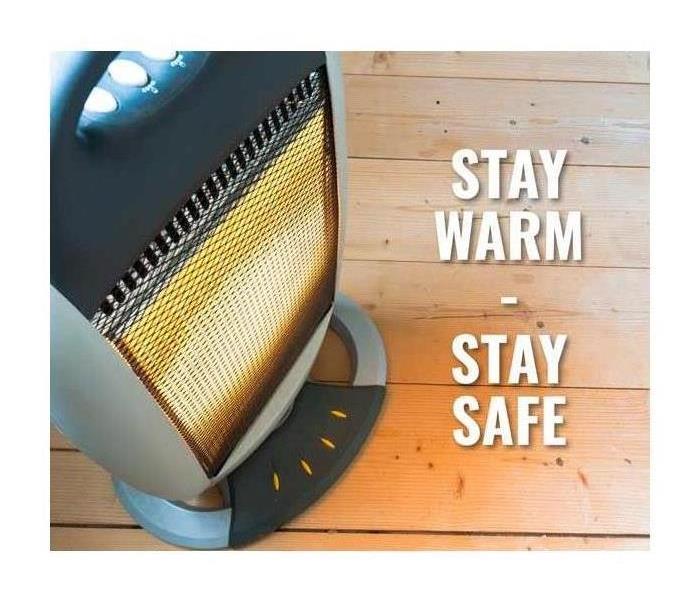 Be Mindful When Using a Space Heater. Keep Your Home Safe.
Be Mindful When Using a Space Heater. Keep Your Home Safe.
It's getting to be that time of the year where a space heater seems like the perfect appliance to make a room a little cozier.
Fire does not care what season it is or whether or not it’s cold outside. Cold weather related fires are extremely common, especially when you are trying to keep warm.
Our offices in Raytown/East Kansas City have experience in fire damage from space heaters and can provide you with some tips to help avoid having to deal with these types of destructive events this coming Autumn and Winter.
SERVPRO of Raytown/East Kansas City technicians understand that accidents happen. Placing space heaters too close to other objects or using the wrong type of heater in a particular area can cause severe problems. Please take a moment to consider some factors leading to these fires.
Oil Heaters - Should be used in areas where there is the possibility of moisture. This eliminates any electrical hazards that may be present due to water conductivity. Always keep a safe distance to avoid contact burns.
Electric Heaters - These heaters come in a variety of shapes and sizes and can be useful for many areas in your home. However, they should never be left unattended. Thinking of electric heaters as giant toasters can help you understand how important it is to keep a constant eye on them. Make sure you have sufficient wattage to run the device and never use extension cords.
Our SERVPRO of Raytown/East Kansas City staff gets an incredible amount of space heater-related calls every year when the weather gets to get chilly and blustery. People are trying to stay warm and use space heaters quite often for this purpose. However, using a space heater does not need to cause so many problems during a cold spell. Just use common sense, and always follow the directions of the manufacturer.
The professional technicians at SERVPRO of Raytown/East Kansas City state that you follow a few simple guidelines when operating your space heaters.
1) Always place space heaters on a flat, solid surface for proper stabilization.
2) Purchase heaters with an automatic shut-off feature to prevent dangers from tipping.
3) Maintain proper spacing between heaters and other objects in your home.
4) Never leave children or pets unsupervised around operating heaters.
5) Shut your heaters off properly before leaving your home or going to sleep.
Following these guidelines does not ensure that you will never have to deal with fire damage from space heaters. However, you are less likely to have an unwanted consequence. If this sort of incident still strikes your home this cold weather season, make the call to our offices at 816-737-8776 immediately. We will respond quickly and provide you with the services you need to get back to normal fast.
Understanding the Timeline of Water Damage
11/2/2018 (Permalink)
Understanding the Timeline of Water Damage
Flooding and water emergencies don’t wait for regular business hours and neither do we. SERVPRO of Raytown/East Kansas City provides emergency cleaning and restoration services 24 hours a day, 7 days a week—including all holidays.
Flooding and water damage is very invasive. Water quickly spreads throughout your home and gets absorbed into floors, walls, furniture, and more. SERVPRO of Raytown/East Kansas City arrives quickly and starts the water extraction process almost immediately. This immediate response helps to minimize the damage and the cleaning and restoration costs.
Need Emergency Service? Call Us 24/7 SERVPRO of Raytown/East Kansas City 816-737-8776
Here is a Typical Timeline for Water Damage:
Within Minutes:
- Water quickly spreads throughout your property, saturating everything in its path.
- Water is absorbed into walls, floors, upholstery, and belongings.
- Furniture finishes may bleed, causing permanent staining on carpets.
- Photographs, books, and other paper goods start to swell and warp.
Hours 1 - 24:
- Drywall begins to swell and break down.
- Metal surfaces begin to tarnish.
- Furniture begins to swell and crack.
- Dyes and inks from cloth and paper goods spread and stain.
- A musty odor appears.
48 Hours to 1 Week:
- Mold and mildew may grow and spread.
- Doors, windows, and studs swell and warp.
- Metal begins to rust and corrode.
- Furniture warps and shows signs of mold.
- Paint begins to blister.
- Wood flooring swells and warps.
- Serious biohazard contamination is possible.
More Than 1 Week:
- Restoration time and cost increase dramatically; replacing contaminated materials and structural rebuilding may be extensive.
- Structural safety, mold growth, and biohazard contaminants pose serious risks to occupants.
About SERVPRO of Raytown/East Kansas City
SERVPRO of Raytown/East Kansas City specializes in the cleanup and restoration of residential and commercial property after a fire, smoke or water damage event. Our staff is highly trained in property damage restoration. From initial and ongoing training at SERVPRO’s corporate training facility to regular IICRC-industry certification, rest assured our staff is equipped with the knowledge to restore your property.
Immediate Service in Raytown/East Kansas City, MO
10/30/2018 (Permalink)
SERVPRO of Raytown/East Kansas City provides 24-hour emergency service and is dedicated to being faster to any-sized disaster in Raytown/East Kansas City. We can respond immediately to your emergency and have the expertise to handle your restoration or cleaning needs.
- 24-Hour Emergency Service
- Faster to Any-Sized Disaster
- Highly Trained Restoration Technicians
- A Trusted Leader in the Restoration Industry
- Locally Owned and Operated
- Advanced Restoration and Cleaning Equipment
Have Questions? Call Us 24/7/365 at 816-737-8776
Residential Services
Whether your Raytown/East Kansas City home needs emergency flood damage or your upholstery cleaned, you can depend on us. Our technicians have extensive cleaning and restoration training and can make your property look its best. Learn more about our residential services:
- Water Damage Restoration
- Fire Damage Restoration
- Mold Remediation
- Storm Damage Restoration
- Cleaning Services
- Building/Reconstruction Services
Commercial Services
There's never a convenient time for fire or Water damage to strike your Raytown/East Kansas City commercial property. Every hour spent cleaning up is an hour of lost revenue and productivity. So, when the need arises for professional cleaning or emergency restoration services we have the training and expertise to respond promptly with highly trained technicians to get your property back to business. Learn more about our commercial services:
- Commercial Water Damage Restoration
- Commercial Fire Damage Restoration
Common Types of Mold Found in Homes
10/26/2018 (Permalink)
 You need to know what type of mold you're dealing with for health issues.
You need to know what type of mold you're dealing with for health issues.
Mold comes in many types and forms. In fact, there are more than 100,000 types of mold including about 150 types of mold found in homes--each of which can have several subtypes. The good news is that most people tolerate exposure to moderate levels of many different molds without any apparent adverse health effects. The bad news? Some molds may cause health effects.
In this post you’ll learn about identifying some common types of mold in your home.
The HGTV website provides some good mold information. The most common types of mold you may find in your home include aspergillus, cladosporium, and stachybotrys atra (black mold).
Aspergillus is a fairly allergenic mold that is commonly found on foods and in home air conditioning systems. Cladosporium is typically a black or green "pepper like" substance that grows on the back of toilets, painted surfaces and fiberglass air ducts.
Black Mold (Stachybotrys Atra)
Black mold is most likely to appear in your home in places that are particularly warm, humid, and damp—like basements or crawlspaces that may have leaks or other sources of moisture. You can identify black mold by its black color. Most other molds are green or gray in color.
Removing black mold is a step-by-step process that requires patience, an investment in protective gear, black mold removal products, and the courage to brave dark, cramped spaces inhabited by fungus. These are among the reasons why many homeowners hire SERVPRO of Raytown/East Kansas City to remove black mold.
Mold or Mildew: What’s the Difference?
Mold and mildew are types of fungi. Typically, mold is black or green, and mildew is gray or white. Mold tends to grows on food, while mildew grows on damp surfaces, like bathroom walls, basement walls, or fabrics. Mold grows in the form of multicellular filaments or hyphae, while mildew has flat growth. Mildew is often referred to as a kind of mold.
Orange or Red Mold
Mold that appears to be orange or red in color is usually found outdoors. It thrives on decaying plants and moist wood. This type of mold, which can appear slimy, is harmless. The main reason to remove it (should you decide to) is for appearances.
Aureobasidium
Often referred to as “bathroom mold,” aureobasidium is found on caulk, windows, bathtubs, and showers. It’s a black mildew.
Wallemia
This type of mildew is relatively harmless and grows in dust in homes. Wallemia does not need moisture to grow.
Fusarium
This toxic mildew is very common after a flood. Exposure to fusarium may cause some negative health symptoms.
The Importance of Testing
Unfortunately, you can’t identify most types of mold in your home with a photograph or with your naked eye. Most molds look similar. What you can do is send a sample for testing to a qualified mold laboratory.
We know mold. Call SERVPRO Raytown/East Kansas City at (816) 737-8776
Remember that it’s critical to know the types of mold and the amounts you inhale. If you’re concerned, consider testing the air in your home or call SERVPRO of Raytown/East Kansas City.
Water Damage Requires a Quick Response
10/24/2018 (Permalink)
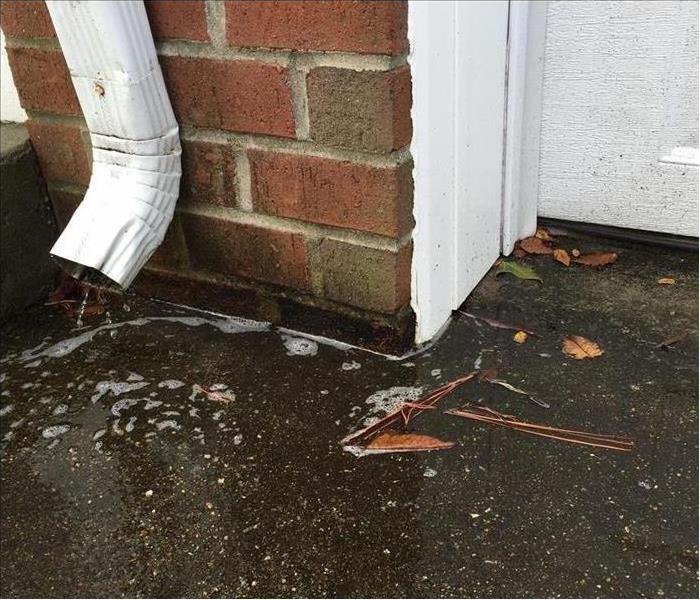
Floods, rainstorms and tornadoes can become massive water damage threats to businesses during the often-stormy spring and summer months. Facilities plagued with such water woes this season must take quick action.
You won’t see it emphasized on the nightly news when a disaster hits, but water damage can represent potentially huge disasters for businesses and building owners and operators.
Water damage can mean much more to a business than just wet and soggy carpets. There are other common, more significant problems businesses face when water wreaks havoc on property, such as indoor air quality problems. Mold and mildew grow rapidly in damp, humid environments, leaving behind an unpleasant smell that permeates floors, walls and ceilings, even after the water has been removed. It also can create health problems for employees.
Damage to the building’s structure and foundation also can be an issue. When water sits inside a building for a period of time, the walls, ceilings and floors absorb the water, which threatens the overall structural integrity of the building and creates an unsafe environment. Total reconstruction of the building often becomes the only option.
Another major threat to business is the loss of expensive equipment, which often can cost hundreds of thousands of dollars to replace.
To minimize water damage, there are two critical steps that need to be taken:
- Act fast to assess the situation; and
- Control the environment within the building.
Act Fast and Call an Expert
The absolute first step to take is fast action. Damage resulting from water and flooding is very progressive. The longer the water flows or wet conditions are allowed to exist, the greater the recovery problem becomes. A water damage consultant must come in immediately to survey the situation.
In a typical scenario, a team of water damage recovery professionals is dispatched to the site to perform a thorough inspection and fully determine the extent of the damage. A disaster reclamation partner also will develop an intense restoration plan and determine which items are worth restoring and which are better replaced.
You can’t always save everything by drying, but you can save a tremendous amount. It’s not unusual to save between 30 and 70 percent of the cost needed to reconstruct a facility.
Controlling the Interior Environment
Another key in limiting water damage is to quickly control three conditions of a building’s atmosphere: relative humidity, temperature and air circulation. Fast, effective action at this point will generally confine the damage to the area that was directly affected by the water damage event.
The most effective way to control these conditions in a high-moisture environment, especially a large facility, is to employ professional disaster drying that combines air movers with desiccant dehumidifiers.
Disaster drying often eliminates the need to rip out and replace walls, carpet, floor covering, hardwood floors and the building structure, which can be a huge expense. On top of that, you preclude the odors and staining caused by mold and mildew. These problems can come back to haunt you weeks later in a superficially dried building.
The Desiccant Way
When a facility has been severely water damaged, you need high volume desiccant dehumidifiers. Some larger desiccant dehumidifiers can pull 800 gallons of water out of a building in one day, compared to the typical small refrigeration units that remove about five gallons a day.
Many people are surprised that “solid” materials such as concrete and hard woods absorb moisture. But they do and rather quickly.
Getting the water back involves a phenomenon called migration. Migration is the tendency for water molecules to move toward a low vapor pressure. When a room is filled with very dry air, which has low vapor pressure, trapped water migrates outward and is evaporated from the surface by the dry air. As the air in the room fills with water vapor, we expel it. We then replace it with more dry air and the process continues.
It’s also essential to be sure the equipment being used is sized right. Inappropriately sized drying equipment can lead to insufficient drying and long-term problems with the building. Only large-volume dehumidifiers could provide the massive drying power needed to dry the space quickly and thoroughly.
Best Defense: A Disaster Recovery Plan
To minimize damage and costs, companies need to think ahead about what to do in a water damage event and contact a water damage expert to create a Disaster Recovery Plan (DRP).
A DRP can limit the extent of water damage occurrences by defining and prioritizing the recovery of areas within a facility and stating immediate next steps. Proper planning and fast action are most certainly the best defense to preventing a catastrophic water damage event.
Keeping Your Business Above Water After Water Damage
10/18/2018 (Permalink)
Flooding and water damage events at Raytown/East Kansas City commercial properties are often complex with numerous issues that require a knowledgeable and flexible response. Whether we’re dealing with a relatively small water cleanup scenario or a large scale event, we work quickly to assess each unique situation and isolate the damaged area. In many instances, normal operations can continue in a temporary space while we restore your facility.
Restoring Commercial Properties Presents Unique Challenges
Our professionals are trained to be mindful of legal and environmental concerns and strive to fully restore the damaged area while working within your budgetary constraints. We understand that every hour spent cleaning up is an hour of lost revenue and productivity. So when an emergency situation arises in your business, give us a call and we’ll be there fast with the help you need.
About SERVPRO of Raytown/East Kansas City
SERVPRO of Raytown/East Kansas City specializes in the cleanup and restoration of commercial and residential property after a water damage event. Our staff is highly trained in property damage restoration. From initial and ongoing training at SERVPRO’s corporate training facility to regular IICRC-industry certification, rest assured our staff is equipped with the knowledge to restore your property.
Pet Storm Preparedness
10/16/2018 (Permalink)
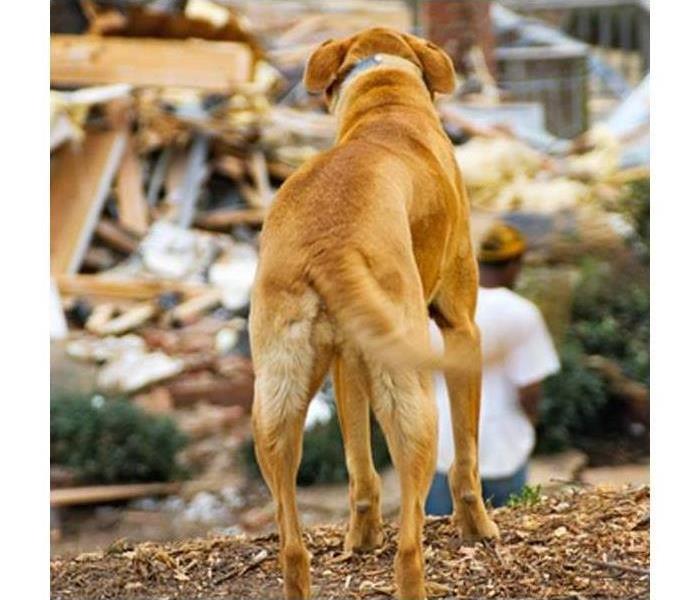 Don't let your pet be unprepared.
Don't let your pet be unprepared.
Pet Storm tips from SERVPRO of Raytown/East Kansas City -
Did you know that almost all dog and cat owners don't have disaster plans for their pets? SERVPRO of Raytown/East Kansas City urges you to make sure this isn’t you.
You made a disaster kit for yourself and family, so make one for your pet. This includes medical records and medication, food and water with can openers, leashes, and carriers.
Tips:
- Keep pets inside during a storm. Animals can become confused and run away from home during a disaster.
- Arrange a safe haven for you and your pets during evacuation. Do not leave pets behind.
- Store an emergency kit—with items such as pet food, bottled water, medical records, a blanket, a flashlight and leashes—as close to an exit as possible.
- Make sure all pets wear collars and tags.
- Have your pet microchipped in case of a lost collar.
- Place a rescue alert sticker to your front home to let rescuers know that there are pets inside.
- Choose a caregiver to take care of your pet in the event you are unable to.
SERVPRO of Raytown/East Kansas 816-737-8776
Methods for Removing Smoke Odor After a Fire
10/5/2018 (Permalink)
 House Fire
House Fire
When you have a house fire in Raytown/East Kansas City, MO it may seem like the smell of the smoke will never go away. Smoke particles can infiltrate every nook and cranny in your home. They can even imbed themselves into furniture, flooring and walls. Professional restoration experts, however, have methods for extracting smoke odor from your home as part of the restoration process. Here are some smoke cleaning processes that may prove effective in removing the stench from your home.
Air Filtration Devices
One of the first methods the experts are likely to try is an air filtration device. This air scrubber sucks in the air in your home and returns it clean and refreshed. The filters in this system are specially constructed to reduce smoke odor. Some common features of filtration devices that remove smoke odor include
• HEPA filters
• Activated carbon filters
• Treated filters that specifically target smoke
Ozone Machines
Another method of smoke cleaning involves the use of ozone machines. Rather than taking air in, these machines create and expel ozone, the same compound chemical created by a rainstorm that gives the outdoor air its fresh scent. The ozone flows throughout your home, oxidizing smoke residue and neutralizing its odor.
Thermal Foggers
Thermal foggers create deodorizing droplets that permeate the air as well as porous materials in your home to get rid of smoke odor. Using heat and pressurization, the fogger creates tiny particles that can go wherever the smoke damage has gone. Your home is deodorized and cleansed of the stench of the fire.
One of the many advantages of hiring smoke cleaning professionals to remove odors from your home after a fire is that they are equipped with industrial machines that can be used to eliminate the smells. A process that would take weeks or even months with any device you could buy retail can be completed in a matter of hours or days with the advanced methods used by professionals.
What Can You Do to Fix Moldy Clothes?
10/5/2018 (Permalink)
 Your dryer is your friend.
Your dryer is your friend.
The reason clothing is so susceptible to mold growth is not just because of the mold-inviting circumstances within the laundry room. Generally, when it is worn, clothing collects sweat and skin cells, as well as dirt and other forms of moisture and organic material that mold loves to feast on. Then, it is placed in the laundry hamper and usually sits for days before it it is finally washed. This scenario is typical and may not result in a noticeable mold infestation, but should the soiled laundry be allowed to fester long enough, a mildew smell may be present, as well as visible signs of green, blue, gray, black, or sometimes even white mold on clothes.
Another scenario is becoming more common due to busy lifestyles and poor habits. The quick development of mold on clothes after washing may be surprising to some, but it is quite an ordinary occurrence for those with overwhelmed schedules or those who are vulnerable to procrastination because they often forget to remove clothing from the washing machine once the cycle is finished. As time passes, this leads to the rapid proliferation of mildew and mold on clothes after washing, due to the remaining moisture. Neglecting to put the wet clothes in the dryer for a few hours is not what makes mold grow. Neglecting the clothes in the washer for 6 hours or longer–sometimes a day or even a few days–is the problem. Before too long, a mildew smell will be detected in the washer and clothing. Some assume this is the residue of soap, and while that may be true to some extent, the fact of the matter is that most soaps contains lard and other organic (even synthetic) materials that mold can thrive off of. The smell is not necessarily the residue of soap, but an indication that mold is producing a secondary metabolite–the mildew smell–from consuming that soap.
What is a natural detergent to kill mold? Here is what you will need.
- Two 5 oz. organic castile soap bars (naturally-scented with lavender or peppermint is great but non-scented works just the same)
- 3 cups of washing soda (no, it’s not the same as baking soda)
- 2 cups of borax
- 30 drops of certified-pure lavender essential oil (optional but highly advisable for a mold killing laundry detergent)
Once you have all the materials, this is what to do.
- Cut the castile soap bars into small pieces or chunks. (This is crucial to avoid damaging the food processor.)
- Place the cut castile soap pieces or chunks in the food processor bowl. Pulse the soap on high until what remains are large crumbs.
- Add the washing soda to the food processor and pulse for 1 minute. (After pulsing, all the ingredients should be in powder form and well-combined. If not, try running the food processor again and then mixing with a spoon.)
- Empty the washing soda and castile soap into the storage container. Add the borax and blend well with a spoon.
- Add the essential oils of choice (optional but beneficial) and be sure to mix well.
Do not place this mixture into the drawer or dispenser, place it directly in with the laundry.
Why You Should Regularly Clean Your Building's Air Ducts/HVAC System
10/1/2018 (Permalink)
It's easy for the cleaning of air ducts and HVAC systems on your property to go forgotten, but it is important to keep up with regular HVAC maintenance. Like anything else in a home or business, air ducts accumulate dust and dirt over time. Other the factors that may increase the need for regular HVAC system cleaning are pets, occupants with allergies or asthma, cigarette or cigar smoke, water contamination or damage to the home HVAC system, or home renovation and remodeling projects. A general rule of thumb is that if your air ducts look dirty, then they probably are.
The National Air Duct Cleaning Associatoin (NADCA) recommends that dirty HVAC systems be inspected by a reputable, certified HVAC professional. Clean HVAC systems can result in an improved air quality of your home or business. Regular cleaning may also increase your energy savings and give your HVAC system a longer lifespan.
If air duct and HVAC system cleaning goes beyond the scope of your regular janitorial staff, or if you want cleaning done for your home's system, SERVPRO of Raytown/East Kansas City can help!
Common Mold Issues
9/27/2018 (Permalink)
Any home or commercial business can quickly become infested with mold with the introduction of a water source, like a roof or plumbing leak. Mold can spread throughout a property in as little as 48-72 hours and can produce allergens and irritants that have the potential to cause other health effects.
If you suspect that your home or business has a mold problem, SERVPRO Professionals can inspect and assess your property. If mold is found, they have the training, equipment, and expertise to handle the situation.
SERVPRO of The Attleboros:
Understanding Mold
Microscopic mold spores exist almost everywhere, outdoors and indoors, making it impossible to remove all mold from a home or business. Some restoration businesses advertise “mold removal” and even guarantee to remove all mold, which is a fallacy. Consider the following mold facts:
- Mold is present almost everywhere, indoors and outdoors.
- Mold spores are microscopic and float along in the air, and may enter your home through windows, doors, or AC/heating systems or even hitch a ride indoors on your clothing or on a pet.
- Mold spores thrive on moisture. Mold spores can quickly grow into colonies when exposed to water.
- Before mold remediation can begin, any sources of water or moisture must be addressed. Otherwise, the mold may return.
- Mold often produces a strong, musty odor and can lead you to possible mold problem areas.
- Even higher-than-normal indoor humidity can support mold growth. Keep indoor humidity below 45 percent.
Common Mold Misconceptions
With sensational news stories and misleading advertising, you can easily understand why so many people are misinformed about indoor mold. Learn the facts about mold and the mold remediation process.
Immediate Steps to Take if You Suffer From Water Damage
9/18/2018 (Permalink)
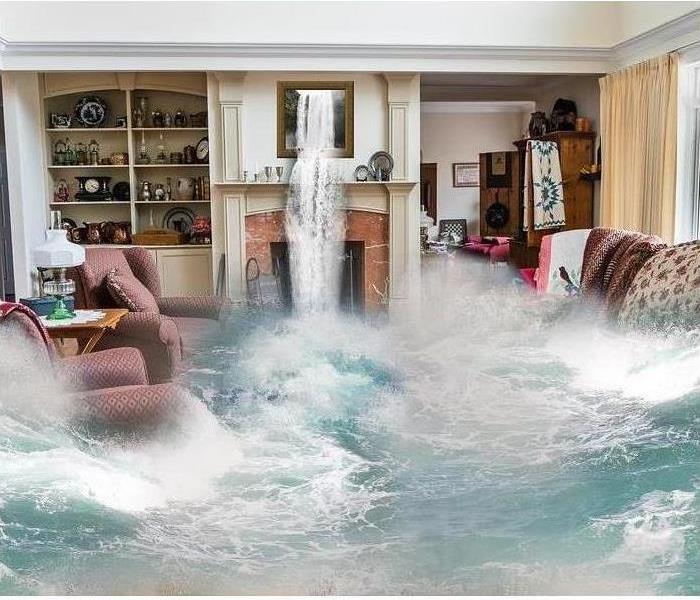 Follow these tips so you can be prepared.
Follow these tips so you can be prepared.
Let’s face it, water damage is threatening to your property’s value and can cause some serious, well damage. Whether you’re facing a storm; a flood; leaks from a weakened roof, HVAC or busted pipes; or experience overflowing appliances, water damage can wreak havoc in an array of emergency situations. To prevent further damage and to increase chances of salvation, it is critical to act quickly within the first 24 hours. Considering you have safely evacuated the premises and safety officials have declared it safe, follow these steps to immediately rectify your business from water damage.
Avoid Additional Risks
Upon returning to your property, survey the premises and document any visible structural damage that may further endanger you and your property. Look for signs of warping, loosened or cracked foundation elements, and holes. If safety officials haven’t done so already, contact utility companies to cease all water and electrical sources. Even if the power is still out upon your return, physically turn off the main power line and individual fuses to avoid risk of electrocution should the power be reactivated.
Document Everything
While surveying your property, take photos and document all damages. Digital photos will allow you to properly store, back-up and transfer files quickly and conveniently. Be sure to document all damages prior to removing any water or starting on any repairs; otherwise, you risk decreasing the extent of your insurance coverage.
Contact your Insurance Provider
Contacting your insurance provider is critical immediately following water damage and your return to the property. Your insurance provider will be able to assess the situation, file a claim, determine whether or not the damage is severe enough to send an adjuster, and provide invaluable next steps. They will also ask for the documentation you’ve collected so it’s important to have that readily available. Pro Tip: if government authorities have declared your region a ‘disaster area’, property owners may have access to increased resources, services and financial assistance.
Secure the Property
Place board over broken windows, fasten tarps, and carryout other measures to avoid further leaks and water damage. Be sure to document all of your efforts to secure your property from further damage. If these precautionary steps are not taken and something else happens, additional damages may not be covered by your insurance provider.
Mitigate Mold Damage
It only takes 24-48 hours for mold to develop following a flood or water damage. If items have been wet for less than 48 hours, they may be salvageable. Remove wet contents such as carpeting and furniture as soon as possible. If an item has been exposed longer than 48 hours, it may be harder and more expensive to salvage. If possible, you can start the drying out process within 24 hours and eliminate mold and mildew growth by:
- Removing wet furniture or lifting it off of carpet
- Place aluminum foil or other carpet separators on furniture to prevent carpet stains
- Remove and hang area rugs to dry
- Use fans and dehumidifiers to dry out wet areas
- Turn air conditioning on to help remove humidity and speed the drying process
Contact A Professional Restoration Service
If any amounts of water need more than a mop and you’ve followed the immediate steps to secure your business, water removal may require professional attention. SERVPRO of Raytown/East Kansas City has the expertise, training and equipment to quickly remedy water damages and help your business get back to working order faster. Give SERVPRO of Raytown/East Kansas City a call at 816-737-8776.
Remediating Flood Damage
9/11/2018 (Permalink)
 When your home is flooded, SERVPRO is the company to quickly call for drying out services. We will dry out your carpet and assess the pad underneath.
When your home is flooded, SERVPRO is the company to quickly call for drying out services. We will dry out your carpet and assess the pad underneath.
SERVPRO Technicians Systematically Dry Out Your Carpet to Try and Save the Pad Underneath
Storms around the Raytown/East Kansas City area are usually calm enough for the drains and area creeks and rivers to handle. When they are severe enough to generate floods, every home in their path is affected to one point or another.
Unless the water generated is massive, most Raytown/East Kansas City flood damage restoration efforts center around drying the carpets. SERVPRO technicians attempt to use in-place drying for carpets if possible and remove most of this water by extraction.
Our teams start the process with specialized equipment that pushes into the carpet and squeezes the water out through an extraction wand. They first remove water from the center of the room and then move the furniture either to the center or remove it completely from the affected area before starting. Once they finish the center, the teams begin extracting water from around the perimeter of the room in sections of 10 square feet or smaller.
After our teams complete one pass over the affected room, an inspector or team leader carefully lifts up one corner of the carpet and examines the pad. If he can squeeze water out of it, the restoration team repeats the extraction process until no more water squeezes out of the pad. They do this as quickly as possible since carpet pads rapidly deteriorate if underwater too long.
If the inspector sees that deterioration has started, he recommends removing and replacing the pad immediately. In-place extraction takes longer to remove water, but it can cost less in labor since time is not wasted by detaching the carpet and removing it from the affected rooms.
Once the team completes extraction, SERVPRO uses a combination of dehumidifiers and air movers to remove moisture in the surrounding air and to dry both the underside and the surface of the carpet. These devices working together can return a room to its pre-flood condition in just a day or two.
Drying carpets are one of the processes SERVPRO of Raytown/East Kansas City uses to return homes to a dry, safe condition. If you are dealing with any recent or older flooding, contact us today at (816) 737-8776 to schedule an inspection. We are here to help.
How to Handle a Toilet Overflow
8/30/2018 (Permalink)
 For more information, please visit us at http://www.SERVPROraytowneastkansascity.com
For more information, please visit us at http://www.SERVPROraytowneastkansascity.com
You should act quickly after a toilet overflows to limit the secondary damage caused by a sewage leak. Depending on what category of water is involved, the risk of sewer damage goes up. If the leak is large and involves black water, you may need to call a sewage company that provides restoration services in Raytown/East Kansas City, MO, as well as a plumber. Find out about the three different categories of water and simple steps you can take to fix a flooded toilet and clean up the mess.
There are three categories of water in a leak scenario:
1. Clean water: Clean water should simply be removed and the area of the leak should be thoroughly dried.
2. Gray water: Gray water includes the water from appliances such as washing machines and toilet water that only contains urine. Cleaning and disinfection are important steps.
3. Black water: Black water contains contaminants with microbes and may pose a threat of infection to individuals with compromised immune systems. Leaks involving black water should be dried and disinfected as soon as possible, ideally within 24 hours.
As soon as you realize that a toilet is overflowing, you should try to see if you can handle the clog on your own with a plunger. If you cannot, minimize the extent of a leak by using towels to prevent water from spreading and contact a plumber. Once a plumber solves the underlying issue, it is up to you to limit the extent of secondary sewer damage or call on experts to completely restore the affected area.
Depending on the extent of the leak caused by a flooded toilet, you may want to contact a sewage company that specializes in restoration. Look for a cleaning and restoration service that specializes in sewer damage in Raytown/East Kansas City, MO, if you are concerned about lingering unwanted smells or the risk of mold.
Raytown/East Kansas City Flood Damage Technicians Explain How Moisture Can Effect Wood Floors
8/24/2018 (Permalink)
 Stormwater Removal and Drying in Raytown/East Kansas City Floors Needed? Try SERVPRO, "Like it never even happened."
Stormwater Removal and Drying in Raytown/East Kansas City Floors Needed? Try SERVPRO, "Like it never even happened."
SERVPRO Removes Water to Mitigate Damages After Storms in the Raytown/East Kansas City Area
Excessive moisture can affect various materials inside your Raytown/East Kansas City condo differently. When drying various substances, it helps to know how water acts when it comes into contact with the particular item. Wood floors get affected by moisture in primarily the same fashion every time. Grasping how the flooring reacts when it gets wet aids our SERVPRO technicians in the water removal process.
How wood floors behave when they get saturated depends on several factors including the amount of moisture and how long the materials have been wet. When mitigating flood damage problems in Raytown/East Kansas City that take place after a severe thunderstorm, permeance and exposure time are the two significant variables determining the amount of damage to the floorboards. Permeance refers to how easily water vapor passes through a material. Exposure time refers to how long material was in contact with moisture, allowing for continued wicking into the wood grains.
When materials stay in contact with water for an extended period, the typical problems associated with moisture damage can get much worse. All wood naturally contains a small amount of moisture. As more water soaks into the wood, it expands. When wood expands warping is likely. Buckling can also occur at the joints where the floor pieces come together. The longer the wood floor stays in contact with water, the worse the buckling issues can become.
If water stays inside the wood, buckling can become permanent and remain after the floors are dried out. In some cases, buckling can be fixed by sanding down and refinishing the floors. In other situations, the floor's buckling is so severe that the wood floor must be pulled up and replaced.
How the water comes into contact with the wooden flooring can also affect how the wood reacts to being wet. When moisture gets absorbed from the bottom and sides of the wood floor, the edges of the floor pieces slightly raise or "cup." Cupping can often be fixed by sanding down the floors. When the top of the wood holds more moisture than the sides and the bottom crowning can take place. Crowning makes the wood arch creating a bowed shape in the middle. Crowning usually happens when the bottom of the wood gets dried too much and too quickly. In most cases, crowning cannot be repaired by sanding and refinishing, and the flooring materials must get removed and replaced.
Rapidly drying, but controlled and monitored, wood flooring materials after a storm hits town is the best way to prevent buckling, cupping, and crowning. Our SERVPRO technicians always closely monitor moisture levels within the wood during the drying process so that over-drying does not occur. Anytime you need help removing water from wood floors after a severe thunderstorm or flooding, call SERVPRO of Raytown/East Kansas City at (816) 737-8776.
Mold Prevention Tips
8/20/2018 (Permalink)
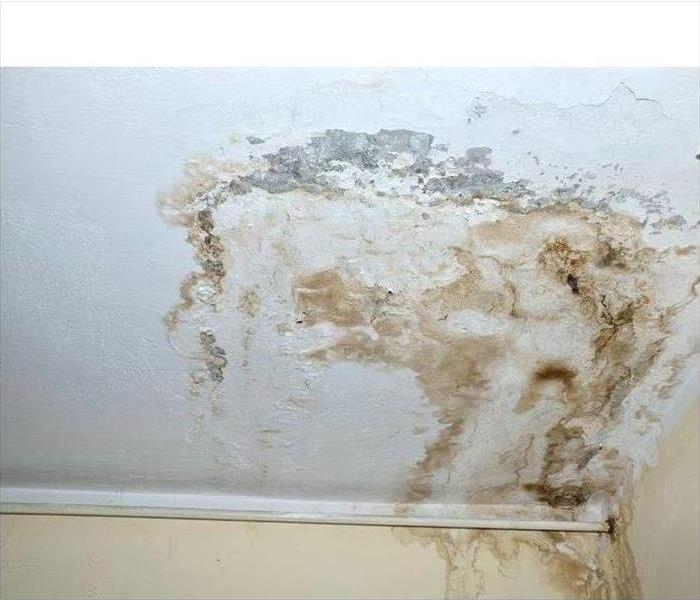 Call us at 816-737-8776
Call us at 816-737-8776
Mold is a common household problem, developing in warm, damp environments. Mold can be colored green, purple, white, and orange. While mold plays an important role outside in the environment, breaking down dead plants, mold is unwelcome in homes.
Showers and bathrooms are a common location for mold to grow, but it is possible for mold to grow anywhere in a home. Mold can come inside a home from an outside growth through inadequately sealed windows or doors. Mold spores cannot be eliminated entirely, but they will not grow if the environment is dry and well ventilated. Mold growth can be prevented by ensuring if water damage occurs, clean up occurs quickly. Using air conditioners during humid seasons and exhaust fans in kitchen can help prevent mold from growing.
Other areas to monitor moisture to prevent mold growth: exterior walls and surfaces in need of insulation where condensation can build, air conditioner drip pans, check for leaks around refrigerator, ensure crawl spaces are well ventilated, and check for leaks around a tub.
These are a few simple tips for making sure mold is not growing in your home. If you do discover a mold growth, SERVPRO of Raytown/East Kansas City provides mold remediation services for all types of residential and commercial properties.
Inspecting a Commercial Property for Mold
8/16/2018 (Permalink)
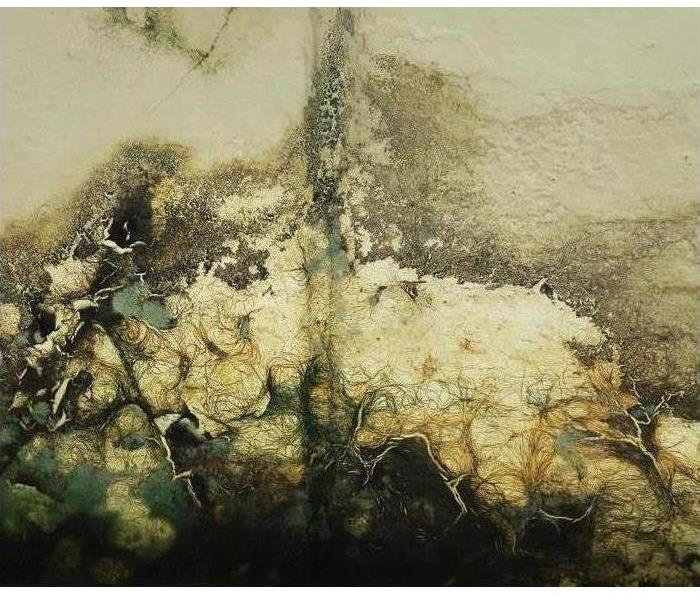 A mold inspection can remove at least one of the unknowns before a business adds a building to its property portfolio.
A mold inspection can remove at least one of the unknowns before a business adds a building to its property portfolio.
Buying a building is a significant investment for any businessperson, and there are a lot of moving parts to this type of transaction in Raytown/East Kansas City. Though it can be an expensive undertaking, hiring a professional to perform a mold inspection before the sale can head off major problems and remediation costs in the long term.
Where Mold Growth Can Be Problematic
To live in this world is to live with mold. At its best, it makes life better by contributing to the creation of bread, wine, cheese and some medicines, like penicillin. It does, of course, have serious drawbacks as well, though.
Prime spots in a building for a mold problem are well-known:
• Bathrooms are a place where mold can grow in grout, between wall tiles, and in the tub or shower.
• Windows that have been improperly sealed can allow moisture into walls or ceilings and facilitate mold growth. A mold inspection can reveal this to a potential buyer.
• Exterior doors without effective seals can allow moisture to collect and harbor mold.
Even slightly high humidity can facilitate the growth of mold. Experts recommend the prudent move of keeping indoor humidity levels below 45 percent.
Why Mold Growth Can Be Problematic
It isn’t only visible mold that can be troublesome to a property owner. Left unchecked, mold can destroy wood because it is an organism that feeds on surface nutrients. Mold that infiltrates drywall cannot be removed, and the affected area must be cut away. Carpets and insulation are also moisture-holding materials that mold can compromise to the point that they must be replaced.
Buying real estate can be a complicated process, and it is impossible to know everything there is to know about a building’s history or future. However, a mold inspection can remove at least one of the unknowns before a business adds a building to its property portfolio.
Water Damage Do's & Don'ts
8/9/2018 (Permalink)
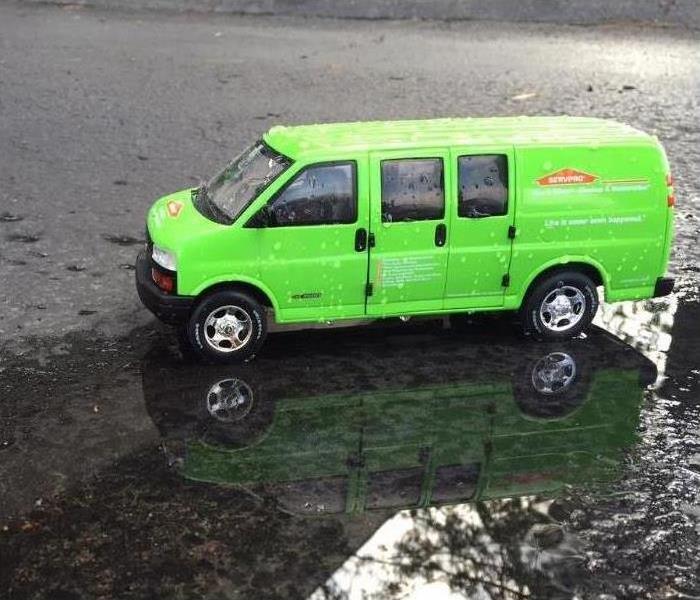 #WaterDamage
#WaterDamage
No one wants to come home to a flooded basement or to wake up to the sound of a broken pipe spraying water on valuable furniture and household possessions. However, the possibility of water damage occurring in your Raytown/East Kansas City home is very real. Whether it is a pipe burst or a weather-related issue, it is important to arm yourself with some basic knowledge to deal with this type of emergency before it happens.
Here are a few tips to help in the event of water damage in your Missouri home:
- First, ascertain whether it safe to stay in the house.
- Make sure there are no active electrical devices or outlets immersed in or near the water.
- Note that wet floors are slippery and “slip and fall” hazards are some of the most prevalent concerns.
- Keep in mind that wet materials can be VERY heavy.
- Have your plumber’s phone number ready and available.
- Contact your SERVPRO Professional at (816) 737-8776 for complete restoration.
While waiting for your SERVPRO Professional to reach your location, here is what you CAN do:
- Shut off the water
- Remove excess water by mopping and blotting.
- Wipe excess water from wood furniture after removal of lamps and tabletop items.
- Remove and prop wet upholstery and cushions.
- Place aluminum foil or wood blocks between furniture legs and wet carpeting.
- Turn air condition on for maximum drying in the Summer.
- Remove colored rugs from wet carpeting.
- Remove art objects and other prized possessions to a safe, dry place
- Gather loose items from floors.
What NOT to do After Flooding:
- Don't leave wet fabrics in place. Hang furs and leather goods.
- Don't leave books, magazines or other colored items on wet carpet or floors.
Electrical Safety During a Flood
8/7/2018 (Permalink)
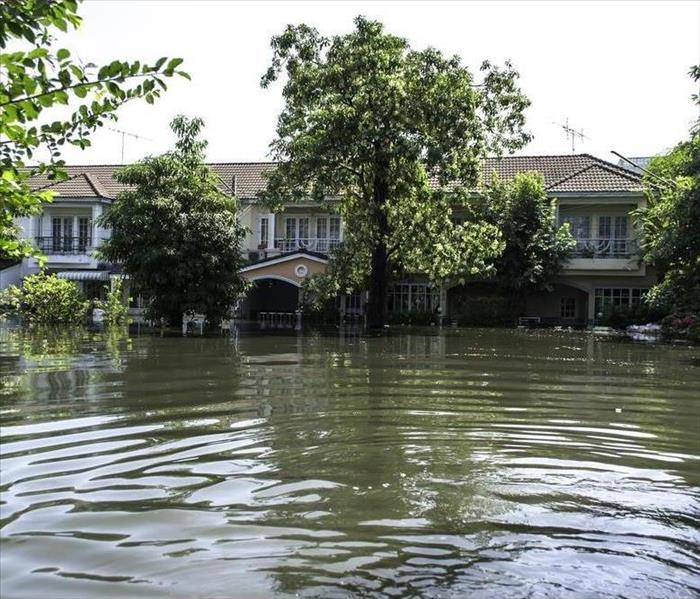 Some electrical damage can be a problem if you have a water damage in your home.
Some electrical damage can be a problem if you have a water damage in your home.
There are many risks associated with flooding. One of them is the danger associated with your electrical system. It is critically important to treat all electrical appliances, equipment and outlets with caution. Here are a few safety tips:
- Never step into standing water that has covered electrical outlets or devices-the water could already be charged with electric current.
- If there are downed power lines in your area, you should avoid them and notify your local power company.
- Avoid areas where there are sparks or if you hear popping or buzzing noises.
- If you smell something that resembles plastic burning, this could indicate an electrical fire.
After any flooding event, you should consult a certified electrician to determine the extent of damage to your electrical system.
How to Perform a Monthly Fire Extinguisher Inspection
7/27/2018 (Permalink)
 If you need professional fire, smoke and water damage cleanup and remediation after a fire, call the experts at SERVPRO of Raytown/East Kansas City.
If you need professional fire, smoke and water damage cleanup and remediation after a fire, call the experts at SERVPRO of Raytown/East Kansas City.
Home Safety: How to Inspect a Fire Extinguisher
When was the last time you took time to check the fire extinguisher that sits under your kitchen sink? Or the one hanging from a dusty hook in your garage? If you’re struggling to remember, it’s time to check it. Like any other piece of safety equipment, a home fire extinguisher should be inspected regularly to ensure it’s in proper working condition. A fire extinguisher in good working condition is your first line of defense when a home fire erupts.
Ideally, you should inspect your portable home fire extinguishers every month.
Tips for Performing a Monthly Fire Extinguisher Check
Check the label or tag.
Every fire extinguisher, whether disposable or rechargeable, has a manufacturer’s label or tag. Read the tag and follow the manufacturer’s recommended maintenance suggestions.
Check the tamper seal.
If the tamper seal has been broken or is cracked, a disposable fire extinguisher needs to be replaced. If it’s rechargeable, it needs to be serviced professionally. Check the locking or pull pin as well to make sure it’s in the correct position. If the pin missing, the fire extinguisher needs to be inspected or serviced by a professional.
Inspect for physical damage.
Physically inspect the fire extinguisher for obvious damage. This may include but is not limited to dents, corrosion, cracks and obvious leakage. If a fire extinguisher has leakage, it’s no longer under full pressure and may not work properly when you need it most. Check the fire extinguisher nozzle as well, to ensure it’s not clogged by grime, dust, bugs or leakage from the unit itself.
Check the pressure gauge.
Check that the pressure gauge needle indicates the fire extinguisher pressure is in the optimum operating range. Often the correct pressure range will be designated by green on the gauge.
Is the fire extinguisher full?
During your monthly check, lift the fire extinguisher and determine if it still feels full. If there has been a leak, it will feel light, and it won’t have the right amount of pressure to work correctly.
Shake it.
If you have a dry chemical fire extinguisher, it should be shaken once a month during your inspection. This helps prevent the chemical dousing agent from solidifying at the bottom of the unit.
Write inspection date on tag.
Keep track of every inspection date by writing it on the fire extinguisher tag.
Ensure easy access to your fire extinguisher.
Fire extinguishers should always be easy to access if there is an emergency. You don’t want to have to search for it once a fire breaks out. Don’t block fire extinguishers with furniture, boxes or any other items. Everyone who lives in the household should know where the closest fire extinguisher is located and how to use it in case of an emergency.
In the event of a fire emergency, first make sure to get people safely away, then call 911. A home fire extinguisher can be used to put out or control small fires, but it’s still safest to call professional fire fighters before you attempt to control a fire on your own.
How Professional Fire Damage Restoration Improves Your Business's Quick Recovery
7/25/2018 (Permalink)
 Count on SERVPRO after fire damage in your business.
Count on SERVPRO after fire damage in your business.
Recover after fire damage with the help of SERVPRO.
No business owner in Raytown/East Kansas City wants the focus for their clients or customers to be the company's ineffective recovery from a disaster. Keeping any damage from fire low key by trying to manage it in-house feels as though you retain control of both the recovery process and your brand. This benefits from this approach quickly become detriments when the challenges fire restoration derail your well-intentioned cleaning staff’s efforts. Involve our well-qualified and equipped fire damage crews to abate the effects fast and to health and restoration industry standards.
The fire damage in your Raytown/East Kansas City restaurant kitchen extinguished swiftly, but the damage is surprisingly pervasive. Smoke and soot are difficult to contain, especially when everyone involved concentrates on putting the fire out by any means possible. Concerns about the spread of fire residues assert after the fire department leaves. Our crews receive comprehensive training not only on basic cleaning at a fire site but also on a myriad of strategies to seek and halt migration of and remediate the non-combusted particles sent airborne during a conflagration.
Many restaurants use open layouts to connect diners to the magic occurring in the kitchen. With little blocking airflow, it is nearly impossible to stop fire residues from depositing on the tables, chairs, and flooring in your dining room. When SERVPRO’s crew arrives, we assess the extent of the fire damage apparent and plan to limit any further spread. If the majority of the damage is in the kitchen area, we can decide to set up a containment zone around the cooking area with heavy plastic sheeting and a negative pressure air scrubber system that prevents more residues from escaping into the spaces where your customers enjoy their meals. We use the walls and doors in place, but augment as needed to keep the spaces separated.
SERVPRO then matches the type of sooty residue with suitable cleaning tools and products. Kitchen fires are frequently protein based, laying down a thin but tenacious lacquer-like film that can require solvents to dislodge. We get to work in the containment chamber on the surfaces close to the fire center using techniques that minimize smearing and are appropriate for the damaged materials.
Meanwhile, in the parts of your restaurant further from the burning, we evaluate the type of soot and other residues that invaded before the establishment of the containment perimeter. SERVPRO technicians can vary the products, techniques, and tools if we encounter different types of residues. Lighter, ashy residues respond well to vacuums, dusting, and dry sponging. Stickier residues need the addition of cleaners with wetting agents and surfactants to loosen for wiping or scrubbing.
All spaces are likely to need deodorization, and SERVPRO employs cutting-edge technology to eliminate smells through chemical neutralization. Cover-ups like candles or air fresheners fail while our resources are broad and eventually remove the odors when our trained employees monitor the process, adjusting the methods until we achieve success.
Spring Maintenance
4/17/2018 (Permalink)
 If you see anything out of the ordinary, call us today 816-737-8776.
If you see anything out of the ordinary, call us today 816-737-8776.
You have heard of spring cleaning but what about spring maintenance?
Providing maintenance to your home structure, appliances, and systems within your home is just as important. While you finish up your spring cleaning go through our spring maintenance checklist to ensure your home is in great condition for the year.
Spring Maintenance Checklist
• Deck and Porches: Make sure railings are not loose.
• Drain Waste and Vent System
• Evaporative Air Conditioner
• Exterior Caulking
• Foundation: Check for cracks.
• Gutters and Downspouts: Check for debris and leaves and run a hose on your roof to check for proper drainage.
• Heat Pump: Lubricate blower motor.
• Hot Water Heater: Lubricate circulating pump and motor.
• Landscape
• Roof: Inspect roof surface.
• Siding: Clean siding with a pressure washer to keep mold from growing.
• Sprinklers
• Window and Door Screens: Clean your screens and check for holes, patch if necessary.
• Window Sills, Door Sills, and Thresholds: Fill cracks, caulk edges or replace in needed.
Being Prepared for April Showers' in your House
4/3/2018 (Permalink)
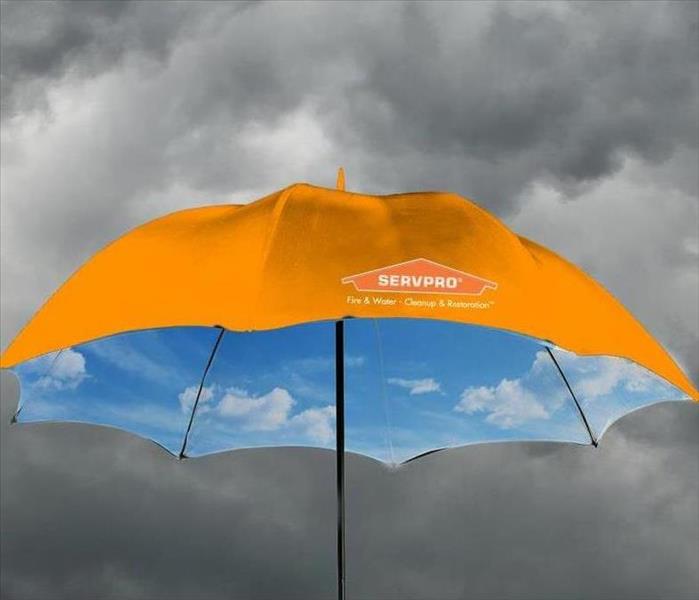 Call us today with any water damage - 816-737-8776
Call us today with any water damage - 816-737-8776
Living in the Midwest can be quite exasperating at times; with having no beach within a 500 mile radius, to our inconsistency to decide what season it is. We never know what to expect so we have to be prepared for the unexpected.
Here at SERVPRO, we are prepared to clean up your house fire on Monday - to your flooded basement on Wednesday. Here are some helpful tips to keep your house safe before and after experiencing inconvenient crisis.
Important Warnings about Water Damage:
- Do not go into rooms with standing water if the electricity is still on!
- Do not use electrical appliances while on wet surfaces.
- Do not use any ordinary vacuum to remove any water.
- Do not lift tacked down carpet without professional help.
After Experiencing Water Damage:
- Use fans to circulate the air and assist with drying.
- Use dehumidifiers if available.
- Remove as much water as possible by mopping and blotting.
- Wipe furniture dry.
- Lift draperies off carpet, loop through a coat hanger, and place the hanger on the draper rod.
- Prop up wet furniture cushions for even drying and place small wood blocks under furniture legs.
- Remove wet area rugs or other floor coverings.
- Open furniture drawers, closet doors and luggage to enhance drying.
- Move photos, paintings, and art objects to a safe, dry location.
- Remove wet fabrics and dry them as soon as possible. Hang furs and leather goods to dry separately at room temperature.
- Do not remove damp books from shelves. Leave tight to prevent pages from rippling.
- Control interior temperatures with heat or air conditioning. Keep interior temperatures between 70 and 80 degrees.
All About Fires
3/20/2018 (Permalink)
 If you have a fire loss, call us - 816-737-8776
If you have a fire loss, call us - 816-737-8776
House fires are dangerous and can become life-threatening in just two minutes. It will only take 30 seconds for a small candle flame to engulf the window curtain and then create a thick black smoke that will fill your house. The smoke and gases are more deadly than the fire itself, so you must take extra precaution when you smell smoke.
Make sure you plan and create a fire escape plan and practice it with your family. Check your smoke alarms monthly to make sure the batteries are still working; working fire alarms increase your chance of survival.
If you do experience a fire, take these precautions:
- Crawl low under any smoke to your exit - heavy smoke and poisons gases collect first along the ceiling.
- Before opening a door, feel the doorknob and door. If either is hot, or if there is smoke coming around the door, leave the door closed and use your second way out.
- If you open a door, open it slowly. Be ready to shut it quickly if heavy smoke or fire is present.
- If you can’t get to someone needing assistance, leave the home and call 911 or the fire department. Tell the emergency operator where the person is.
- If the pets are inside your home, tell firefighters right away.
- If you can’t get out, close the door and cover vents and cracks around doors with cloth or tape to keep smoke out. Call 911 or your fire department. Say where you are and signal for help at the window with a light-colored cloth or a flashlight.
- If your clothes catch fire, stop, drop, and roll. If this is not possible, smother the flames with a blanket or towel. Use cool water to treat the burn immediately for 3 to 5 minutes. Cover with a clean, dry cloth.
Source: https://www.ready.gov/home-fires
Make sure you take precautions when you are cooking and smoking, or have portable space heaters and fireplaces to prevent those preventable house fires.
The Storm has Passed but are YOU in the Clear?
3/6/2018 (Permalink)
 Be prepared, have our number handy - 816-737-8776
Be prepared, have our number handy - 816-737-8776
Here in the midwest, we get anxious when tornado season comes around. Severe storms come through your life fast and turn it upside down.
Make your mind at ease with a few of these tips to stay safe after the storm has passed.
Your first instinct after a storm is to go outside and see what the damage is, DO NOT do that. There could be broken glass and other sharp objects that you can’t see.
If you smell gas, make sure you find the main gas line, if possible, and shut it off. If you can’t turn it off then call the gas company immediately.
If you see a power line on the ground, wait until help gets there. They could be energized and very dangerous.
If there are people depending on you, kids or elders, then you must stay calm. They look to you for peace and if you start to freak out then it will just cause more chaos.
Be prepared; if you have notice that a severe storm is coming, take precautions and pack a bag of necessities.
Also, know how your insurance policies work. A few questions you may ask yourself is:
- Is my vehicle covered for storm-related damage?
- Will my insurance rates go up because of storm damage?
- How do I file a claim for storm-related damage?
- What if I can’t tell if the damage is more than my deductible?
Source: https://www.progressive.com/lifelanes/what-to-do-after-storm-damage/
We hope you don’t go through a sever storm, but if you do we hope that your are prepared.
Is Mold Covered by your Homeowners Insurance?
2/20/2018 (Permalink)
 Call us today with any questions about mold - 816-737-8776
Call us today with any questions about mold - 816-737-8776
Most owners insurance comes down to the source of the moisture to where the mold damage started. If you are unsure if your homeowners insurance covers mold, go over your policy. Make sure you look for mold exclusions or limitations and call your agent if it still unclear.
If mold results from a sudden and accidental damage, like a pipe bursting, the cost of mold remediation would be covered. Now, if it mold shows up because of neglecting home maintenance then most claims would be rejected.
Here is sample of damage done by an inch of flood water:
- Replace carpet, flooring: $2,700
- New baseboard molding: $2,250
- Replace drywall $1,350
- Cleanup, materials: $1,000
- Bookshelves, lamps: $500
- Total: $7,800
Source: National Flood Insurance Program - https://www.fema.gov/national-flood-insurance-program
You could also buy a mold rider as an add-on to your existing policy for extra coverage. If your insurance carrier doesn’t provide a rider, specialty companies might sell you a stand alone mold policy. Just to warn you, there will be a big price tag for that route.
If your insurance does not cover mold at all, moisture prevention is the key.
To help prevent mold growth, take the following steps:
- Lower indoor humidity with air conditioners, de-humidifiers, and exhaust fans
- Inspect hoses and fittings on appliances, sinks, and toilets
- Use household cleaners with mold-killing ingredients like bleach
- Opt for paints and primes that contain mold inhibitors
- Clean gutters to avoid overflow and check roof for leaks
- Avoid carpet in wet areas like basements and bathrooms
- Remove and dry carpet, padding, and upholstery within 48 hours of flooding
Source: House logic https://www.houselogic.com/finances-taxes/home-insurance/homeowners-insurance-mold-covered/
Common Causes of Commercial Water Damage
2/5/2018 (Permalink)
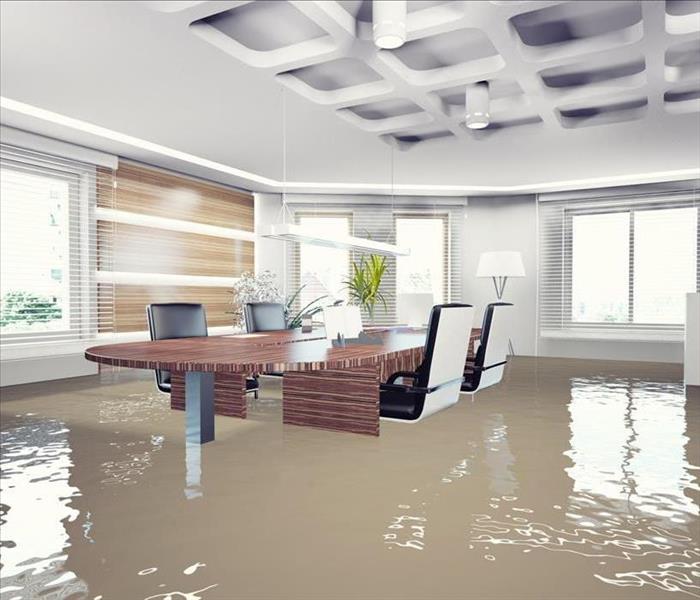 Call us today - 816-737-8776
Call us today - 816-737-8776
Usually when companies think about water damage in their building, they think the cause will be from a huge storm. Most of the time, that is the truth but there are other factors that cause water damage in commercial buildings.
1. Damaged Appliances - This problem is more common in restaurants where they have many different appliances that could cause a problem. If you have any equipment or appliance that involves water, you could have this particular water emergency.
2. Water Heaters - It is possible for water heaters to crack or lose their seal because of high pressure. You want to make sure and follow the manufacturers guidelines and flush your heater regularly to make sure it is working properly.
3. Roofing - One of the more obvious ways that you can tell that your building has water damage is seeing water leaking from your roof. Your roof might need to be resealed or it does not drain properly. If you notice a leak, even a small one, get it fixed ASAP.
4. Malfunctioning Sprinkler Systems - If you have an older building, sometimes the sprinkler systems work with the fire protection systems. You need to check the system to make sure that it is not faulty or in need of replacement to prevent unnecessary water damage.
5. Broken Pipes/Plumbing - During colder weather, it is more possible for pipes to break if you don’t continually run water through them. You need to take care of all pipes to make sure none of them burst.
6. Backed up Sewer Lines - This water emergency might be the most disgusting and one of the most dangerous. You will have contaminated black water flowing on the floors which can cause serious health effects.
If you experience any water damage to your commercial building, SERVPRO of Raytown/East Kansas City will get your building cleaned and up and running in no time.
Preparing Your Home and Car for the Blast of Winter Cold
1/10/2018 (Permalink)
 Always be PREPARED!
Always be PREPARED!
If you live in the Midwest, you know the drill. Four to five months of heavy clothes, seeing your breath and generally freezing outside. Sometimes even elsewhere, Old Man Winter stops in for an unexpected visit. But beyond the inconvenience and discomfort, a winter storm or other severe weather conditions can cause real damage. So it's important to think about winter preparedness.
Protecting your home is vital. A frozen water pipe can burst and flood your house or basement. An ice dam in your gutter can cause water to seep into and saturate an interior wall. And then there’s your car. Making sure it’s prepped to face winter’s worst is just as critical. After all, what would happen if a blizzard stranded you in your car?
Prepare yourself
Some winter weather tips to help you get through a severe stretch of cold:
- Stay indoors during the storm.
- Walk carefully on snowy, icy walkways.
- Avoid overexertion when shoveling snow. It’s a serious workout, and going at it too hard can bring on a heart attack − a major cause of death in the winter. If you must shovel snow, stretch before going outside.
- Stay dry. Wet clothing loses all of its insulating value and transmits the cold rapidly.
Prepare your home
Some tips to brace your home for a winter storm:
- Clean out the gutters, disconnect and drain all outside hoses. If possible, shut off outside water valves.
- Insulate walls and attics, and caulk and weather-strip doors and windows.
- Repair roof leaks and remove tree branches that could get weighed down with ice or snow and fall on your house – or your neighbor's. (Avoid liability for the latter.)
- Wrap water pipes in your basement or crawl spaces with insulation sleeves to slow heat transfer.
- Consider an insulated blanket for your hot water heater.
- If you have a fireplace, keep the flue closed when you're not using it.
- Have a contractor check your roof to see if it would sustain the weight of a heavy snowfall.
- Make sure your furniture isn't blocking your home’s heating vents.
- During cold spells, keep cabinet doors open to allow warm air to circulate around pipes, particularly those in the kitchen and bathrooms.
- Keep a slow trickle of water flowing through faucets connected to pipes that run through unheated or unprotected spaces.
- If your house will be unattended during cold periods, consider draining the water system.
- Avoid ice dams – where water from melted snow refreezes in the gutters and seeps in under the roof, soaking interior walls. Here’s how:
- Ventilate your attic.
- Insulate the attic floor well to minimize the amount of heat rising through the attic from within the house.
- Consider having a water-repellent membrane installed under your roof covering.
Prepare your car
Prepare your car for treacherous conditions and extremely cold temperatures – and know what to do if you find yourself stranded in a vehicle. When the temperatures start to drop:
- Drive only if it is absolutely necessary. If you must drive, travel during the day.
- Don’t travel alone. Keep others informed of your schedule.
- Stay on main roads and avoid back road shortcuts.
- Top off antifreeze, windshield wiper fluid, gas, oil and other fluids.
- Make sure your tires have enough tread. Consider snow tires.
- Keep bagged salt or sand in the trunk for extra traction and to melt ice.
- Clear snow from the top of the car, headlights and windows.
- Save the numbers for your auto club, insurance agent and towing service into your cell phone.
- Keep a cold-weather kit in your trunk. It should include a blanket or sleeping bag, gloves, hard candy, bottled water, folding shovel, first aid kit, flashlight and cell phone charger.
5 Steps to be Prepared for Water Damage
1/2/2018 (Permalink)
 Call SERVPRO of Raytown/ East Kansas City today 816-737-8776
Call SERVPRO of Raytown/ East Kansas City today 816-737-8776
Most water damage that happens to your home is uncontrollable and unpredictable. It could potentially cost you thousands of dollars. When the water starts coming into your home, there is not much you can do to stop it but there is a couple things you can do to prepare for it. Here are a few steps you can take so you can be prepared for the worst.
Step 1: Stop the Source of the Water
If it is possible, stop the water at its source. If it has to do with your plumbing then turn off your water line as soon as possible. This will help with decreasing the amount of damage.
When the flooding occurs from storm water, there is no stopping a storm but you can try and divert the water away from your home by blocking entry points.
Step 2: Think Safety
If it safe, then shut off all electrical sources by turning the circuit breakers or unplug devices. Water and electricity don’t mix, remember that. Make sure everyone, including children, are away from standing water.
Step 3: Protect Your Possessions
Try and remove or raise your furniture from flood water. Water soaked furniture begin to mold very quick and you the last thing you will want is to throw away all of your belongings after a flood. Protect the things that are irreplaceable rather then carpet and other flooring.
Step 4: Contact Your Insurance Company
Now is the time to call your insurance and see how they will approach the water remediation. All insurance companies have professionals who specialize in this kind of emergency so they will have the best people to restore your home back to normal. Do not try to remove the water by yourself. You can just end up cause more damage.
Step 5: Work With the Professionals
When you are choosing a company to perform your water remediation; you need to compare everyone highs and lows. Make sure they have good reviews and are available at your earliest request. SERVPRO of Raytown/East Kansas City is highly dependable and will exceed your expectations for your water remediation.
How to Keep Mold and Moisture Out of Your HVAC System
11/27/2017 (Permalink)
 Contact us to remediate your Raytown/East Kansas City home!
Contact us to remediate your Raytown/East Kansas City home!
Tips and Tricks From SERVPRO to Keeping Mold and Moisture Out Of Your HVAC System
In the warm summer heat, it's easy to build up moisture; especially when it gets sticky, muggy and humid. When this happens, you naturally crank the A.C., reach for something cold, and kick back in your lazy chair. The problem is, when you're relaxing and enjoying the nice cold breeze, mold is spreading through your ducts, vents, and HVAC system, leaving a nasty haze of mold that you can smell all over the house. If you're running a business, your customers could smell it too- which is why you should always call our service professionals to deal with the problem as soon as possible.
How Does Mold Get in The HVAC System?
Mold damage in Raytown/East Kansas City is no laughing matter. Mold, fungus, and other bacteria are in their perfect environment when they're trapped in your HVAC system. It's dark, warm, moist, closed in, and humid, meaning that spores can grow practically unabated. You'll notice more and more scent as heat and humidity is generated from outside and pulled through your ducts.
When this moist air gets in your air system, it collects within and above your HVAC units. At this point, the spores of mold and other fungi easily rise through the air, setting up colonies as your condenser forces them up through the duct system. These aren't the only cases of mold that we've seen at SERVPRO; we've seen mold stick to people's clothes or shoes, and it's all brought inside by excess humidity caused by rainfall.
Here Are a Few Tips on How to Remove Mold From Your HVAC System
1. Continue to clean and maintain your HVAC system, even when you aren't using it. Check the ducts for wet spots, and regularly check and maintain your HVAC filter.
2. Double check the drainage systems on your HVAC for mold. Allow for "dry-out" areas where the drainage comes out to prevent excess moisture.
3. Get dehumidifiers for your home. They are ideal for collecting excess humidity, and they help with the temperature inside your house, too.
4. Always insulate your pipes, walls, and ceilings. Use caulking for cracks to control cracks and leaks.
5. Contrary to common beliefs, keep your windows closed when it's hot outside. Humidity, dust, and dampness easily travel inside.
Holiday Home Safety Tips
11/13/2017 (Permalink)
 Call SERVPRO of Raytown/East Kansas City if you have any damage to your home during the Holidays. 816-737-8776
Call SERVPRO of Raytown/East Kansas City if you have any damage to your home during the Holidays. 816-737-8776
Holidays are near which means more entertaining and cooking; which could increase the risk of fire and accidents.
Follow these tips to stay safe during the Holidays:
- Before you go to bed or leave the house, make sure you turn off all the lights to refrain from a fire.
- Use only non-combustible and flame-resistant materials to trim your tree.
- Make sure you keep an eye on your food; unattended cooking is the leading cause of home fires.
- Have a steady base so the tree won't tip over easily.
- Decorations should be at least 6 inches above children's reach.
- Replace old mittens or mittens with threads loose to protect your child from getting it tangled around their neck and choking.
- Do not discuss travel plans with strangers.
- Have a neighbor or close relative keep an eye out on your house.
Top 5 Most Common Causes of House Fires
11/6/2017 (Permalink)
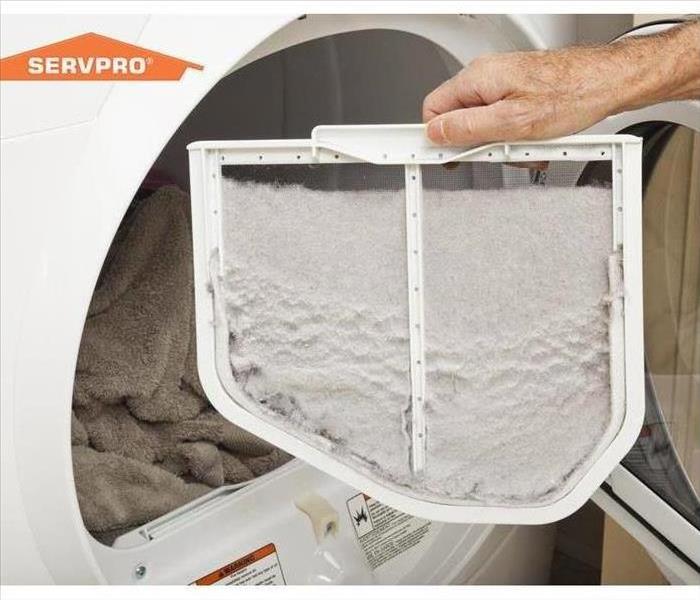 If you experience a fire in your home, don't hesitate to call SERVPRO of Raytown/East Kansas City at 816-737-8776
If you experience a fire in your home, don't hesitate to call SERVPRO of Raytown/East Kansas City at 816-737-8776
Here are top 5 most common causes of house fires as identified by the National Fire Protection Association.
- Candles
From 2007-2011, the NFPA says there were an average of 10,630 fires in the U.S. that were started by candles, causing 115 deaths, 903 injuries and approximately $418 million in property damage. That is an average of 29 candle fires per day.
Safety tips:
- Never leave a candle burning near flammable items.
- Never leave a candle burning in a child’s room or an unoccupied room.
- Make sure candles fit securing into candle holders so they won’t tip over.
- Blow out any candles before leaving a room or going to sleep
- Smoking
While the number of fires caused by smoking is trending downward, the NFPA found that there were still an average of 17,600 related fires per year resulting in 490 deaths and more than $516 million in property damage.
Safety tips:
- If you smoke, consider smoking outside.
- Use wide, sturdy ashtrays to catch butts and ashes.
- Look for cigarette butts under furniture and between seat cushions to make sure no lit butts have fallen someplace where they can’t be seen.
- Don’t smoke in bed, when you’re tired or around medical oxygen.
- Electrical & Lighting
According to the NFPA, in 2011 approximately 47,700 home structure fires were caused by some sort of electrical failure or malfunction. These resulted in 418 deaths, 1,570 injuries and $1.4 billion in property damage.
Safety tips:
- Don’t overload outlets or electrical cords.
- Make sure you have the right cord for the job – inside cords for inside, heavy duty/outside cords for outdoor use.
- Don’t leave Christmas lights, Christmas trees, or halogen lights on overnight or when not at home.
- Consider having an electrician perform an annual checkup of your home’s wiring.
- Dryers & Washing Machines
Clothes dryer fires happen more often than one might think, accounting for 16,800 home structure fires in 2010 and doing more than $236 million in property damage.
Safety tips:
- Clean the lint screen frequently and don’t run the dryer without it.
- For gas and propane dryers, make sure there aren’t any leaks in the lines.
- Vent the dryer to the outside of the house and ensure nothing blocks the vent pipe.
- Clean the vent pipe and the area where the screen is housed.
- Keep the area around the dryer free of combustible materials.
- Lightning
From 2007-2011, NFPA says there were an average of 22,600 fires per year caused by lightning strikes.
Safety tips:
- Stay away from doors and windows during an electrical storm.
- Do not use corded phones, computers, TVs or other electrical equipment during storms.
- Unplug major electronics – TVs, stereo equipment, computers and microwaves to minimize damage if there is a lightning strike close by.
- Avoid plumbing such as sinks, baths and faucets during a thunderstorm.
Tips to Avoid Freezing Pipes
11/3/2017 (Permalink)
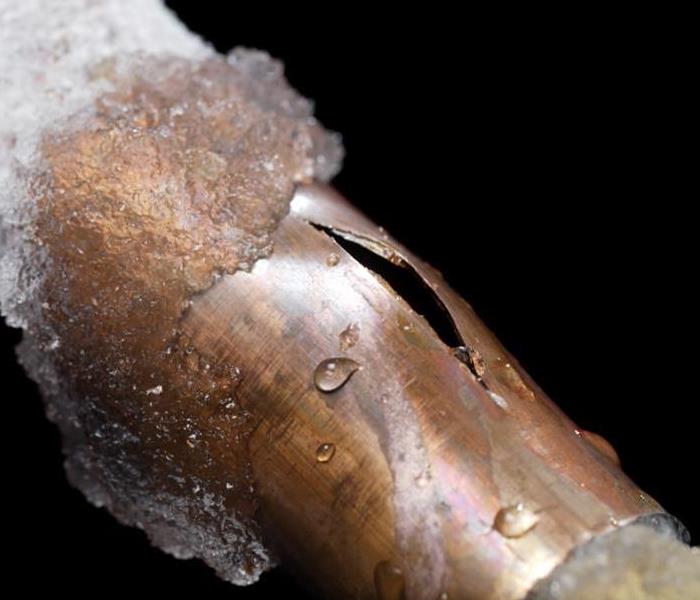 Don't let frozen pipes flood your life with unexpected problems!
Don't let frozen pipes flood your life with unexpected problems!
Why Pipe Freezing is a Problem
Water has a unique property in it that expands as it freezes. This expansion puts tremendous pressure on whatever is containing it, including metal or plastic pipes. No matter the “strength” of a container, expanding water can cause pipes to break. Pipes that freeze most frequently are those that are exposed to severe cold, like outdoor hose bibs, swimming pool supply lines, water sprinkler lines, and water supply pipes in unheated interior areas like basements and crawl spaces, attics, garages, or kitchen cabinets. Pipes that run against exterior walls that have little or no insulation are also subject to freezing.
If your pipes do freeze and cause damage to your home or business, STAY CALM AND CALL SERVPRO Raytown / East Kansas City, we can make it “Like it never even happened.®”
During a freeze, Take Preventative Action
- Keep garage doors closed if there are water supply lines in the garage.
- Open kitchen and bathroom cabinet doors to allow warmer air to circulate around the plumbing. Be sure to move any harmful cleaners and household chemicals up out of the reach of children.
- When the weather is very cold outside, let the cold water drip from the faucet served by exposed pipes. Running water through the pipe - even at a trickle - helps prevent pipes from freezing.
- Keep the thermostat set to the same temperature both during the day and at night. By temporarily suspending the use of lower nighttime temperatures, you may incur a higher heating bill, but you can prevent a much more costly repair job if pipes freeze and burst.
- If you will be going away during cold weather, leave the heat on in your home, set to a temperature no lower than 55°F.
To Thaw Frozen Pipes
- If you turn on a faucet and only a trickle comes out, suspect a frozen pipe. Likely places for frozen pipes include against exterior walls or where your water service enters your home through the foundation.
- Keep the faucet open. As you treat the frozen pipe and the frozen area begins to melt, water will begin to flow through the frozen area. Running water through the pipe will help melt ice in the pipe.
- Apply heat to the section of pipe using an electrical heating pad wrapped around the pipe, an electric hair dryer, a portable space heater (kept away from flammable materials), or by wrapping pipes in towels soaked by hot water. Do not use a blowtorch, kerosene or propane heater, charcoal stove, or other open flame device.
- Apply heat until full water pressure is restored. If you are unable to locate the frozen area, if the frozen area is not accessible, or if you can not thaw the pipe, call a licensed plumber.
Check all other faucets in your home to find out if you have additional frozen pipes. If one pipe freezes, others may freeze, too.
Commercial Cleaning Services
10/31/2017 (Permalink)
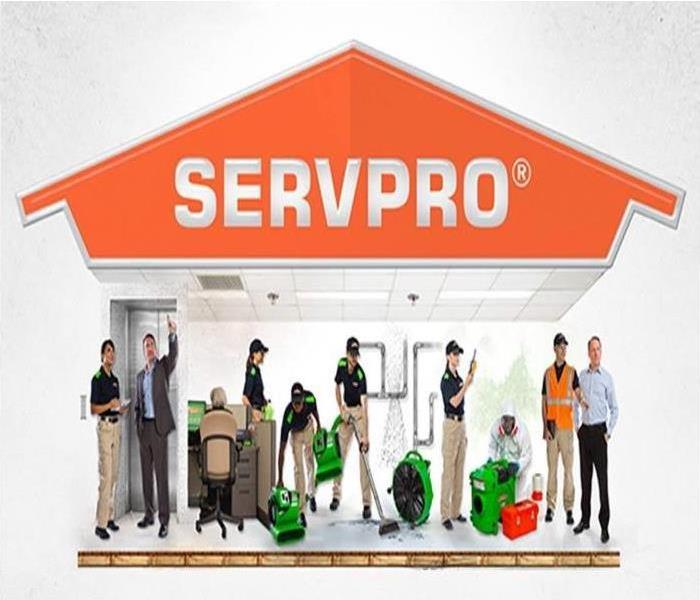 Call us today 816-737-8776
Call us today 816-737-8776
If you are a business owner, or run a particular business that receives a lot of visitors and foot-traffic, you know how important it is to keep your business looking clean and in good shape. A lot of times, you don't have the time to worry about the common wear and tear that gradually soils your office.
When grime, odor, and moisture challenges go beyond the scope of your regular janitorial staff, you should call SERVPRO of Raytown/East Kansas City for prompt service. Whether it’s removing an odor problem or deep cleaning flooring or carpets, you can rely on us to make your workspace look its very best.
SERVPRO of Raytown/East Kansas City offer cleaning services ranging from cleaning restaurant hoods to removing biohazard contaminants. We have the specialized training and products to get your property back to business. Our cleaning services include the following:
- Air Ducts and HVAC
- Biohazard and Sewage
- Trauma and Crime Scene
- Carpet and Upholstery
- Drapes and Blinds
- Ceilings, Walls, and Hard Floors
- Odor Removal and Deodorization
- Vandalism
3 Warning Signs of Mold
10/27/2017 (Permalink)
 Be on the lookout for these signs of mold!
Be on the lookout for these signs of mold!
Nothing sends shivers through a homeowner's spine like mentioning the word "mold." Not only can it cause damage to your home and make it hard to sell, it also can be a health hazard to you and your family. Here are three warning signs of this insidious fungus that you don't want to ignore:
1) Water spots
Any wet spot in your home can be a potential sign of fungus growth. This can include water spots on your ceilings or walls, or on floors in your basement or crawlspace. If you find evidence of water spots, you need to find the potential moisture source and get it taken care of promptly. Using a highly-recommended remediation company like SERVPRO of Raytown/East Kansas City is the best option.
2) Discoloration
If you find a spot on a wall or floor that's discolored, it is a potential sign of mold. Discoloration that is green or black is a definite warning sign of fungus growth. However, any discoloration can mean growth is present, even if it isn't of the tell-tale colors.
3) Bad smell
If you have fungus growth in your home, it can cause a bad smell. Depending on the type of growth and how much of it you have, you could have a very strong smell or one that is faint. It can smell musty or earthy, or it can produce a smell that is more pungent. Any bad smell needs to be investigated.
Mold can be harmful and is not something to be ignored. If you experience any of these warning signs, call SERVPRO of Raytown/East Kansas City to investigate. Our staff receives extensive training on how to effectively deal with mold infestations. We also have the equipment and start of the art techniques to carry out remediation tasks and keep your home safe and clean.
How SERVPRO Assesses Flood Damage After a Dishwasher Breakdown
10/25/2017 (Permalink)
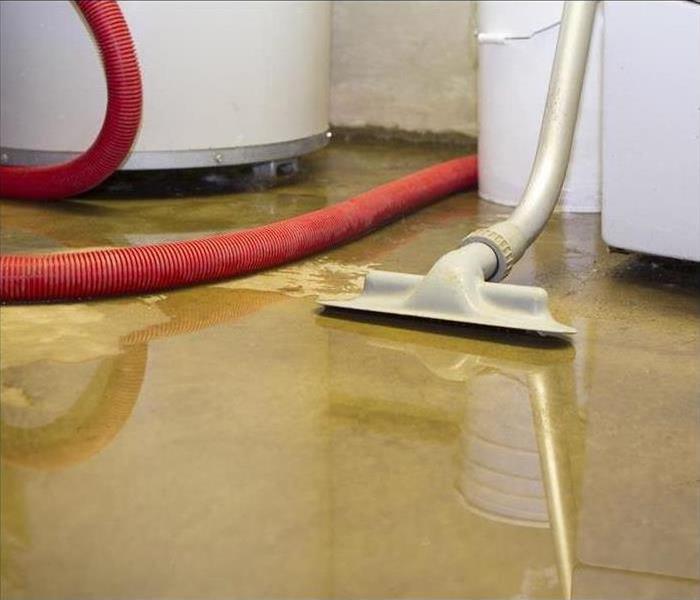 Raytown/East Kansas City relies on SERVPRO for cleanup and water removal.
Raytown/East Kansas City relies on SERVPRO for cleanup and water removal.
SERVPRO's Array of Measuring Devices Ensures a Dry Home Post Flooding
Dishwashers are a welcome addition to many households. After all, who does not love being able to simply rinse the dishes, set the cycle, and let the machine do the work? It is very convenient. However, like any other appliance, a dishwasher might malfunction, and a dishwasher breakdown often equals a flood of water in your kitchen.
Flood damage to your Raytown/East Kansas City home can be a serious cause for concern. A dishwasher might cause a surprisingly large flood in your kitchen, so naturally, you want to get that cleaned up as quickly as possible to mitigate any further damage. That is why we recommend you put in a call to SERVPRO at once -We’re Faster To Any Size Disaster.
An essential element of our job is assessing the damage to your home. A thorough assessment lets our experts know how much moisture is present, which is vital information that we need to decide upon the best course of action.
A visual inspection is an important first start, but of course, that is only one part of the process. Our teams come prepared with a range of powerful equipment to help us assess the flood damage to your home:
A moisture sensor to help us ascertain how deeply water has penetrated into soft materials. The sensor displays a blinking light and makes an audible beep when moisture is present, and this allows us to measure the extent of the damage. We have other models that work silently.
A moisture meter to help us measure how much moisture is in any structure. Meters are useful for testing the damp content of every part surrounding your dishwasher including not only the floor but also walls, wall insulation, cabinets, and rugs or carpets. Do not worry if you have a wooden floor. Our SERVPRO experts also come equipped with penetrating moisture meters that can be used to take a reading under wood flooring or even inside the wall. Our technicians calibrate the instrument to suit the material that we are testing.
Thermo-hygrometers. Thermo-hygrometers measure the temperature and the relative humidity in your kitchen. Our technicians use these readings to determine the extent of the water damage. This is usually used after the water has been removed, a verification that a standard RH has been attained.
A complete evaluation of the situation assists us in drawing up an effective individual drying plan for your kitchen. We monitor moisture and humidity throughout the drying process so you can rest assured your kitchen is at optimum dryness and humidity before we call the job done. We can also provide documentation to your insurance company.
Dangers of Flash Flooding
10/23/2017 (Permalink)
 If flooding does occur in your area, listen to and adhere to weather alerts and warnings and know your risk!
If flooding does occur in your area, listen to and adhere to weather alerts and warnings and know your risk!
Flooding is the number #1 weather related cause of death, with majority of those deaths caused by flash flooding. Flash flooding is when there is a large amount of rain that comes down within minutes or hours. Other causes can be heavy rain associated with a severe thunderstorm, hurricane, tropical storm, or melt water from ice or snow flowing over ice sheets or snowfields.
If flooding does occur in your area, please remember
- Listen to NOAA Weather Radio for current and forecasted conditions in your area.
- If flooding begins in your area, go to higher ground immediately.
- When driving, always be aware that the road bed under flood waters may be severely damaged. NEVER drive through flooded roadways. Remember that it takes only two feet of water to carry away a vehicle, including pickups and SUVs.
- When walking, do not attempt to cross flowing streams. Remember that it takes only six inches of rushing water to knock an adult off his feet.
- If your vehicle stalls, get out immediately and go to higher ground.
- Be extra cautious at night, when it is harder to see possible flood dangers.
- These four words could save your life: TURN AROUND, DON’T DROWN.
When it comes to water damage from flooding, safety is the number one priority. When you can insure the safety of your family and conditions have improved, that is when to call in the professionals and assess damage. Our SERVPRO team is ready for whatever happens.
The Different Causes of Commercial Water Damage
10/19/2017 (Permalink)
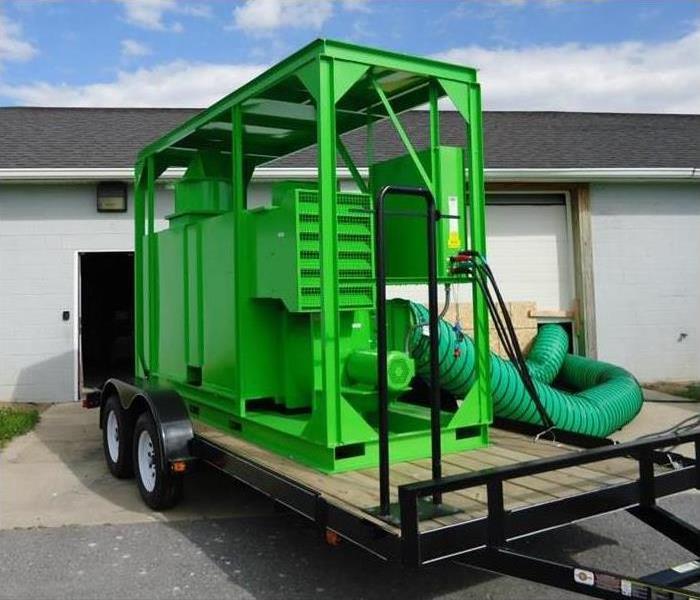 Speciality drying equipment for large commercial water damages.
Speciality drying equipment for large commercial water damages.
Work Place Water Damage is Restored by SERVPRO
When business owners visualize water damage, they often picture a massive storm wiping out power lines, flooding offices, and shutting down businesses for days at a time. It is true that commercial water damage is often the result of floods and water that stems from weather events and storms.
However, many entrepreneurs and business space renters forget that storms and severe weather aren't the only causes of floods and water damage. Here are some of the typical causes of water damage to commercial buildings.
1. Malfunctioning sprinkler systems
Some older office and retail buildings still have outdated sprinkler systems that work in conjunction with fire protection systems. While such sprinklers can come in handy during a fire emergency, they can also cause commercial flood damage if they are faulty or in need of replacement. This could easily damage inventory and business assets.
2. Damaged appliances and equipment
This cause of commercial flood damage is more common in restaurants and catering facilities, as well as any business that has appliances and equipment that make use of water. If the appliance fails and sends water across your building, especially during late hours when no one is around, you may come back to work and face a water emergency.
3. Broken pipes and plumbing
Just like in a residence, if the plumbing system in your workplace fails water damage could be the result.
4. Backed up sewer lines
This is another cause of commercial water damage that often catches business owners by surprise. Should the sewer line to your building back up or become damaged, realize the potential dangers of contaminated Black Water which can cause health effects and ruin products and office furnishings.
Storm Preparation: Are You and Your Family Ready?
10/17/2017 (Permalink)
 Call us today with more information 816-737-8776
Call us today with more information 816-737-8776
When the weatherman says take cover because there’s a hurricane on its way, the last thing you need to worry about is storm preparation. A little effort now, before disaster strikes, can bring peace of mind and yield big savings in the future. Here are some tips to help you plan ahead, so that you won’t have to face storms unprepared.
- Check your insurance policy to make sure it reflects the present state of your home. Think about adding flood insurance, as well as coverage for extra living expenses in case you are unable to stay in your home immediately after a storm.
- Making a home inventory is a critical component of storm preparation since it will make filing a claim easier and save time. Document the contents with a video camera or some other inventory tool. Retain receipts for any valuable items and consider getting separate coverage for these.
- Make an emergency supply kit containing basic survival items. This should include a 2-week supply of water and non-perishable, ready to eat food for each member of the family, as well as pets. If you need to evacuate your home, you’ll want a three-day supply of the same.
- Storm preparation must also include an evacuation plan.
- Gather important documents to take with you – for example, personal ID or driver’s license, insurance policies, social security cards, marriage and birth certificates, etc.
Contact our emergency restoration specialists at SERVPRO when fire or water damage occurs in your business or home. We’ll start your journey to a full recovery with our vast experience and state-of-the-art equipment, and we’ll work with your insurance company.
What to do if you Find Mold in Your Home
10/11/2017 (Permalink)
 If you have any questions about Mold, do not hesitate to contact Raytown / East Kansas City SERVPRO directly at (816) 737-8776
If you have any questions about Mold, do not hesitate to contact Raytown / East Kansas City SERVPRO directly at (816) 737-8776
In as little as 48 hours, mold can quickly become a problem in your home or business when there’s a water intrusion, like a roof leak or leaking water line. Mold can cause health effects and can also cause significant damage to your property. SERVPRO of Raytown/East Kansas City has the training, protective gear, and specialized equipment necessary to handle your mold problem.
If you have a mold problem in your home or business, consider the following facts:
- Significant mold growth can occur in 48-72 hours.
- Mold may present a greater risk to children, the elderly, and anyone with respiratory problems.
- A strong, musty odor may indicate hidden mold behind drywall or under carpeting.
What to Do:
- Stay out of affected areas.
- Turn off the HVAC system and fans.
- Contact SERVPRO of Raytown/East Kansas City for mold remediation services.
What Not to Do:
- Don’t touch or disturb the mold.
- Don’t blow air across any surfaces with visible or suspected mold growth.
- Don’t attempt to dry the area yourself.
- Don’t spray bleach or other disinfectants on the mold.
Preventing Puffbacks
10/6/2017 (Permalink)
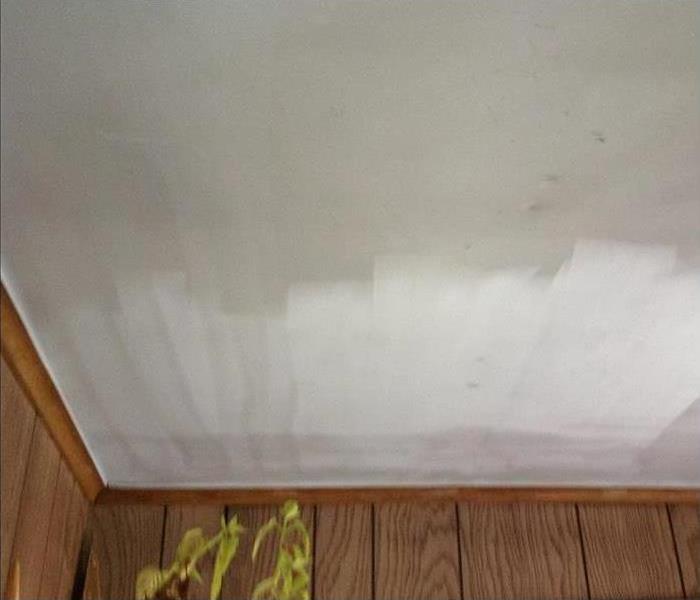 During the cleaning process after a puffback.
During the cleaning process after a puffback.
A puffback is a messy furnace malfunction that occurs when an oil burning furnace backfires, sending soot throughout the interior of a property. It can happen all at once, covering the interior in grimy soot, or it can leak soot more gradually.
Initially, many people mistake soot for dust and simply wipe it away. However, once cleaned, this “dust” often reappears and can sometimes be accompanied by a strong, oily odor. There are several steps you can take to prevent damage to your home:
- Have the oil-burning furnace professionally checked and cleaned annually.
- Keep an eye out for traces of soot around your home.
- Install a carbon monoxide monitor. Puffbacks (and the soot they create) will increase the carbon monoxide levels in your home. A carbon monoxide monitor can help to detect the puffback in its early stages.
If soot begins accumulating on objects or walls within your home, you should turn off the heating system immediately. Contact a heating professional to service the heater and restore it to proper working order. If the oil-burning furnace is left on it can carry it through the duct work to other portions of the home.
Fortunately, if you do experience a puffback, SERVPRO® has the knowledge and experience to complete a thorough cleaning and removal of any soot and odors. Depending on the severity we are able to perform a pack out to ensure your items are properly restored, cleaned, or removed for your safety and health.
Our Fire Restoration Team will respond immediately and give you the steps to ensure we can make it "Like it never even happened."
Do you Have a Smelly Restaurant?
10/2/2017 (Permalink)
 Keep your restaurant fresh for your customers and employees!
Keep your restaurant fresh for your customers and employees!
Does your Raytown/East Kansas City restaurant smell like a bad recipe? Do you have customers come into your place and wrinkle up their nose? Or they walk in and then leave without ordering anything. You know you’re in need of odor removal when customers suddenly lose their appetite when entering your restaurant in Raytown/East Kansas City. We know it’s not a pleasant topic, but it’s one we, at SERVPRO of Raytown/East Kansas City, have experience correcting! So, how can we help you with your odor problems? Read on and discover 3 ways we will get your restaurant sweet-smelling once again.
Deep cleaning
Sometimes you need a bit more than the everyday cleaning job your staff does. Just like we do deep cleaning a couple times a year in our homes, it is essential to have this done in our restaurants as well. Restaurants enjoy a thorough cleaning of the floors, drapes, blinds, carpeting, and upholstery. Food smells can become trapped in fabrics leaving a sour or greasy smell. We have specialty cleaning services to ensure your restaurant gets deep cleaned.
Deodorization
Not only does your Raytown/East Kansas City restaurant need a deep cleaning, but it needs an odor removal process using deodorization. Our staff is trained to discover what is causing the odors. This is an important first step in eliminating the odors. Once our staff knows where the smell is emanating from, then we can use the proper formula to remove it. We have several different deodorizing formulas created to get to the source of the bad smells. Odor removal is not just about hiding or covering up offending smells, but it’s essential to go to the root of the problem and neutralize it.
Inspect for mold
Mold is one thing that not only leaves a musty odor, but it has a negative impact on your health. That’s why it’s so important to determine if mold is the culprit and, if so, to begin action right away to combat it. We have tools and equipment that help us determine if there is a mold problem. It doesn’t take much for mold to develop and then spread. If you suspect mold, we will discover the source and work to isolate, then eliminate it.
We make cleaning and restoration our expertise. We train and educate our staff to combat stinky smells wherever they may be. If you have a restaurant that does not smell too sweet, contact us today.
Mold Damaged Documents
9/28/2017 (Permalink)
 Call SERVPRO of Raytown/East Kansas City today.
Call SERVPRO of Raytown/East Kansas City today.
If your home or business has important documents that are affected by Mold, we can HELP!
We use a specialized process called Gamma Irradiation. This is used for cleaning/ disinfection and decontaminating documents or other consumer goods. In gamma irradiation, high-energy photons are emitted from an isotope source (Colbalt 60) producing ionization(electron disruptions) throughout a product. In a CAT 3 situation (sewage or flood water), documents are not only deteriorating but are also infected with all types of bacteria. In most storm situations you are dealing with CAT 3 water: therefore, most of the affected documents that you will encounter will be contaminated. If this is the case then decontamination is always a must. In Living cells, these disruptions result in damage to the DNA and other cellular structures. These photon-induced changes at the molecular level cause death to the organism or render the organism incapable of reproduction. The gamma process does not create residuals or impart radioactivity in processed products.
For additional information or questions on processes involving fire, water, or mold damaged documents please call our office - 816-737-8776, and we would be happy to further discuss and provide a free estimate for services.
Commercial Damage in the Food Service
9/26/2017 (Permalink)
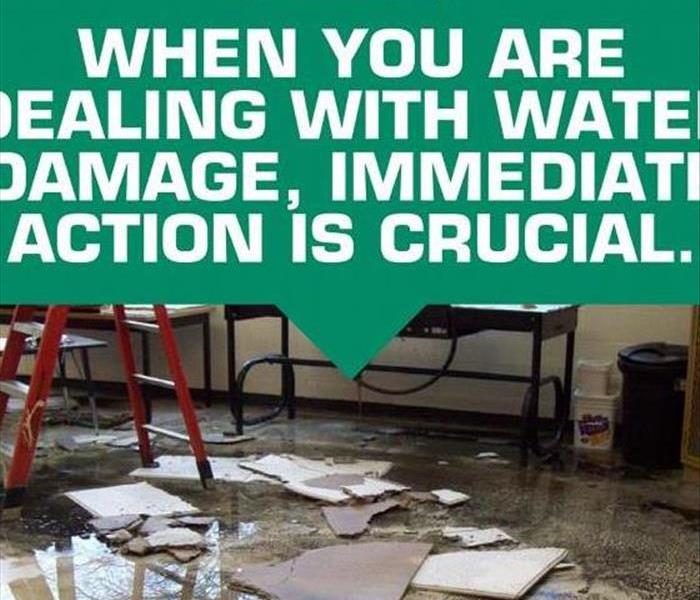 When you are facing commercial water damage, call SERVPRO to assess.
When you are facing commercial water damage, call SERVPRO to assess.
Don't Let Water Damage Ruin Your Business
For a local bakery, the chemical agents we use for cleaning may not be an option. Food is very sensitive to absorbing orders, and even the lingering odor from a strong antimicrobial agent could render ingredients useless and serving areas irritating to customer's noses.
This means that cleaning up commercial water damage in a bakery may take a bit longer. Instead of using cleaning agents, our technicians here at SERVPRO will rely on the air moving equipment in our inventory to dry the building and reopen the doors for business.
Lower speed air movers work well to push wet air out of a room or hallway. By using a shroud with them to direct the air, these movers are also excellent for drying out the moisture that can be trapped between sheets of drywall or under cabinets.
The air movers we use are designed to not just dry out a room, but with the right attachment (a special clamp), our higher speed models can also be used to dry out a carpet and carpet pad in less than a day. If we can start this process quickly enough after standing water has been removed (and if the water was not contaminated), then we can restore most carpeted areas in a day or two without the need of chemical cleaning agents.
For large areas such as kitchens, we will use venting box fans to exchange the wet air for dry air. It is also in areas like this with large surfaces (preparations tables) where we may need to use some cleaning agents. The box fans will speed up removing odors as our technicians employ the chemical cleaners.
Restoring a food service business brings its own set of problems. SERVPRO of Raytown/East Kansas City has the experience and the equipment to get the job done. If you have a water problem in your business, call us today at 816-737-8776 to begin restoration and get your doors open to customers once more.
Why Water Damage Restoration Services are Imperative After a Flood
9/18/2017 (Permalink)
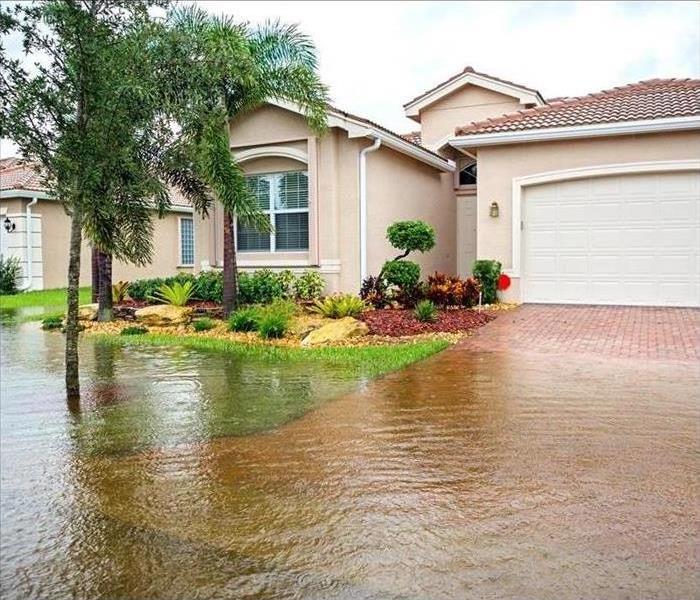 Call SERVPRO of Raytown/East Kansas City with any water damage restoration needs 816-737-8776
Call SERVPRO of Raytown/East Kansas City with any water damage restoration needs 816-737-8776
Flooded water in the home or water in the business needs to be handled immediately. The flooding could be as a result of a supply line break or a pipe break. Regardless of the cause water damage, restoration services need to be sought early. The first approach after a flooded home should be mitigation so as to prevent further flood damage. Water cleanup and drying services need to follow. Dealing water damage mitigation on your own can be overwhelming. Again, you may not have the necessary water cleanup tools to handle the flooded home or flood damage. When contemplating on whether to hire the services of a restoration company, home and business owners should consider the following benefits.
Prompt Restoration Services
When dealing with a flooded home, timing is everything. Your main concern should be to avoid secondary water damage. This is why you need to bring in a professional restoration company on board. They will conduct mitigation, water cleanup and drying services within a short span of time. This is because they have extensive experience in water damage restoration. These professionals will send multiple contractors to the site so as to get the work done in the shortest time possible. The restoration company will also get to the root cause of the water in the home or water in the business flood damage. If it is a supply line break or a pipe break, then they will fix it as well.
Mildew and Mold Growth Prevention
Flooded water and secondary water damage can provide a good breeding ground for mold and mildew. Flood damage mitigation professionals will conduct drying to avoid the growth of fungi and other harmful microorganisms. If mold is already present, the professionals will use grade cleaner and disinfectants to eliminate the mold. This will prevent mold exposure, which can affect your health.
Holistic Help
A Water restoration company will offer more than drying and water cleanup services. Their services are holistic and beneficial to the home or business owner. A flooded home comes with other issues that are subject to the flood damage. These professionals also offer additional services such as deodorization, vent cleaning, sanitation, and content restoration. Their main objective is to restore the home or business to its previous condition prior to water in the home or water in the business damage. These professionals will also take care of any supply line break or pipe break.
Reduced Drying Time
Reduced drying time is another advantage of hiring prompt services. This is made possible by quick water extraction methods. Water restoration experts have the necessary tools and skills to extract excess water, especially on carpets and drugs. They also get rid of standing water. These prompt services eliminate further loss and save the home or business owner. Fast water removal services are also important because mold spores can grow in 48 hours after a flood. Timing is therefore crucial for the success of the water removal process. Home and business owners can also salvage items such as carpets and furniture if the cleanup is done in good time.
Tips and Advice
Prevention is always safer as opposed to dealing with a flooded home. Once you have experienced a flood, you do not want to go through this again. Supply line breaks and a pipe break can be very expensive to repair. Leaking pipes have the potential to cause extensive water damage. This can even damage the structure of a building. It is prudent for home and business owners to conduct regular inspections of their supply lines.
Water removal professionals will also offer tips and advice and how to check for leaks. Common signs of water problems include wet carpets, drippings on the wall, exaggerated water bill and signs of rust. Prevention and mitigation strategies can help to avoid costly repairs after water in the home or water in the business damage. The effects of water can be mitigated by enlisting professional help in good time.
Storm Damage? NO problem for SERVPRO of Raytown/East Kansas City
9/12/2017 (Permalink)
 We will get your business back up and running as quickly as possible!
We will get your business back up and running as quickly as possible!
When Raytown/East Kansas City businesses suffer serious damage after storm events, SERVPRO of Raytown/East Kansas City will work around the clock to clean up any debris and to restore the property to pre-storm conditions. We understand that commercial storm damage can be very costly in terms of productivity; that is why it is always our goal to get your business back up and running as quickly and as seamlessly as possible.
We Have the Resources to Handle Large Commercial Storm Damage
When a storm hits Raytown/East Kansas City, we can scale our resources to handle large-loss commercial restoration projects. We have access to equipment and personnel from a network of over 1,600 Franchises across the country.
If you business is ever damaged by sever floods or storms, call us right away 816-737-8776. Disaster can strike when we lease expect it, but SERVPRO Raytown/East Kansas City will be there to help you weather the storm.
National Preparedness Month
9/5/2017 (Permalink)
 Be Prepared! Call Raytown/East Kansas City SERVPRO to start your ERP today! (816) 737-8776
Be Prepared! Call Raytown/East Kansas City SERVPRO to start your ERP today! (816) 737-8776
September is National Preparedness Month and a good reminder that we all have a responsibility to protect ourselves, our families and our communities. Emergencies will happen, but taking action now can help everyone minimize the impact of the disaster.
NOW is the best time to plan for an emergency. Make your Emergency Plan today!
You can start by taking these simple steps:
- Be informed. Know the hazards and risks in your area, and learn what you need to do to get ready for them.
- Make a emergency plan, so you know how you would communicate with and find your loved ones if a disaster hits.
- Build an emergency supply kit - both at home and in the car - that includes water, food, and first aid supplies to help you survive if you lost power or get stranded in your car.
- Get Involved - safety and emergency preparedness. Most communities have established emergency procedures and participate in activities planned to communicate those procedures.
Watch a short video and learn more about our ERP APP so you can be prepared at: https://www.youtube.com/watch?v=2JZzd0OQzM4
Shut Off Valves at Work
8/31/2017 (Permalink)
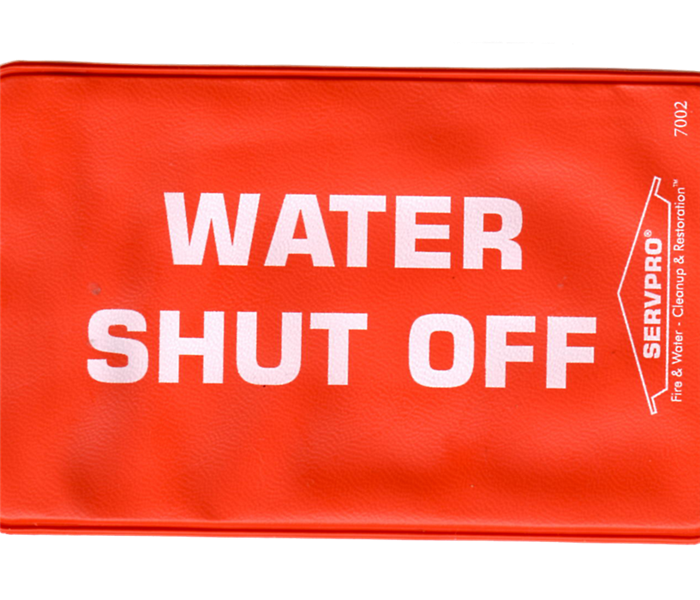 We also have shut off tags you can put on your water valves so they are easily noticeable.
We also have shut off tags you can put on your water valves so they are easily noticeable.
Many workplaces always call's on the boss or the maintenance man when something goes wrong. What if they were home sick, or in a meeting and you need to locate the water shut off, where do you start?
SERVPRO of Raytown/East Kansas City can help commercial property in planning for a water, fire, storm damage. How, with a free Emergency Response Profile created by the SERVPRO Marketing Department.
By having a plan of action and including it into your regular training at your office you can minimize the cost if an unplanned event happens like a frozen pipe, fire, or anything.
Some property manager use this as a tool to keep everything organized in one central location.
Is your business ready for a disaster. Even a simple pipe burst can cause a lot of damage and headache. With a SERVPRO® Emergency READY Profile it can have the critical information to minimize damages, provide the resources for the employee's of the company, and provide property details and information. This is a FREE services that we provide to commercial properties.
Make an appointment today to get started!
If the unthinkable happens, call your local SERVPRO of Lee's Summit Professionals at 816-737-8776 seven days a week 24/7 to help you avoid the cost and hassle of secondary damages. We will help make it "Like it never even happened."
Biohazard Cleanup
8/29/2017 (Permalink)
 We will make it look "Like it never even happened."
We will make it look "Like it never even happened."
When you need a plan for emergency Biohazard clean up and disinfection, SERVPRO of Raytown/East Kansas City has professionals on call.
Our customers do not have to go through this alone, we are here to help in any way possible.
Biohazard cleanup may involve bodily fluids, sewage, rodent feces and many other contaminates that have to be handled with care. Our certified professionals use proper personal protective equipment to protect themselves from spreading possible illness.
Please call SERVPRO of Raytown/East Kansas City (816) 737-8776 for an estimate and leave biohazard clean up to the professionals.
Highly Trained Restoration Specialists
From initial and ongoing training at SERVPRO's Corporate Training Facility to regular IIRC industry certifications, our professionals are equipped with the knowledge to restore your property. The SERVPRO training program includes the following:
- IICRC Training
- Employee Certification Training
- Initial Franchise Training
- e-Learings
- Continuing Education Classes
SERVPRO Professionals are the Storm Damage Experts
8/24/2017 (Permalink)
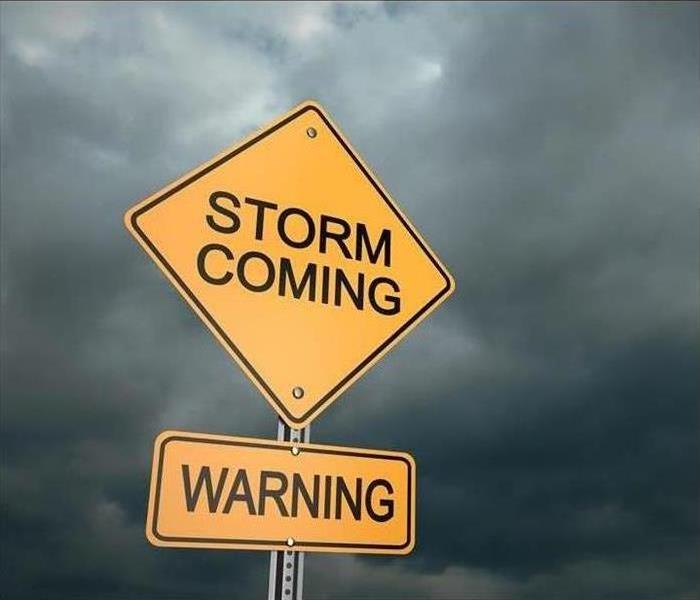 We are ready to deal with any size storm damage! Call today!
We are ready to deal with any size storm damage! Call today!
Quick Response and High Standards Will Leave you Satisfied after Remediation
When heavy rains and high winds hit hard, property destruction and loss can be devastating to you as a homeowner. Structural damage to the exterior of your home is followed by interior devastation from water and winds. Storm damage is rarely isolated to just a few buildings in an area adding the challenge of finding a restoration company that can respond swiftly to your needs to an already anxiety provoking situation. SERVPRO delivers the help you need swiftly even when a local disaster is widespread as we are able to call upon a network of over 1,650 franchises nationwide to respond if the need is great.
Storm damage in Raytown / East Kansas City can feel overwhelming, but your fear and panic will disappear when our team of professionals responds to your water, wind and flooding repair and restoration needs. Your particular situation is of paramount importance to us, and you need not worry that your repairs and restoration will take a back seat even when many in your area are struggling to recover from the same issues you face. Choosing our company puts in motion a vast support system, but our local ownership means you will receive a personalized approach to your particular situation, efficiently returning your home back to its pre-storm condition just “like it never even happened.”
Placing your trust in SERVPRO for your storm damage needs will reap you benefits that less qualified companies simply cannot deliver. We use state of the art equipment to clean, repair and restore your home and in the process, we also restore your and your family’s peace of mind. Our technicians are highly trained and qualified. We also work closely with your insurance company, ensuring that all the work necessary is approved and compensated according to the terms of your policy. Our high standards and relentless drive to do the job on time while meeting local specifications means you and your family will quickly return to the quiet enjoyment of your house and neighborhood. We are not satisfied until you are happily back in your restored dwelling.
Once you make sure that your family is safe after a major storm, your first call should be to SERVPRO of Raytown / East Kansas City. Call 816-737-8776 24/7 and begin the road to recovery by scheduling an inspection with our storm damage experts.
August Ladder Safety
8/22/2017 (Permalink)
 Be safe and use a ladder.
Be safe and use a ladder.
As the scorching heats slowly cools down, people are having outside work done to get ready for the Fall season.
Ladder climbing takes place various outside jobs; painting, cleaning cutters and trimming trees.
Take precautions and follow these safety tips:
- Make sure to inspect the ladder before using it. Check for broken or missing parts, as well as slippery spots.
- Place the ladder on a firm, even ground to ensure stability.
- Use the 4 to 1 rule; if the ladder touches the wall 16 feet above the ground, the feet of the ladder should be 4 feet away from the wall.
- Always check to make sure the braces are fully extended and locked in place before climbing up.
- Keep you feet braced against the side rails and lean sightly forward. Never reach more than a comfortable arm's length away.
- Always face the ladder when ascending or descending.
- If at all possible; work within sight of someone in case of emergency.
Understanding Mold
8/21/2017 (Permalink)
 Samples of different types of mold
Samples of different types of mold
Mold is a problem that homeowners have been dealing with for centuries. In fact, every house and environment has mold spores; they are a normal part of the air we breathe. When there is a greater concentration of mold spores is when mold becomes a problem.
Mold needs three things in order to thrive: a source of food, an ideal temperature, and moisture. Mold will feed on dirt and dust which is present in every home. And most houses are kept at temperatures that are almost always ideal for mold growth. As for moisture? Moisture can come in more than one form. Most people believe that you need to have experienced some kind of water damage (i.e. flooding, burst pipe, malfunctioning appliance) to encourage mold growth. While that can be true, especially if remediation isn't done within 24-48 hours, this is not always the case. If your home has a relative humidity of 60% or greater, mold can grow in your home, regardless of if you experienced water damage or not. A musty smell is usually the first sign that you have a mold problem in your Raytown/East Kansas City home.
Finding mold in your home or business can be panic-inducing, but that is what we are here for. SERVPRO of Raytown/East Kansas City is here to help. We have a great, professional team of highly-trained technicians that will make your mold problem "Like it never even happened."
816-737-8776
Benefits for Commercial Clients
8/17/2017 (Permalink)
 A broken water main resulting in partial foundation replacement.
A broken water main resulting in partial foundation replacement.
Commercial Property Managers
If you work in the property management industry you understand the value of a quick response and fast turn round time when it comes to an emergency situation. A quick response time can mean a reduction in the size and scope of the damage, it can also mean the difference between having a chance at saving business critical documents and equipment for the clients that are most important to you.
Commercial Client Benefits
Choosing SERVPRO of Raytown/East Kansas City for your commercial damage mitigation accrues you benefits not limited to:
- Working with you to tailor the solution to you, priding ourselves in accurate and straightforward communication.
- Every large commercial loss is supervised by a local commercial operations manager to help ensure seamless communication and timely mitigation.
- The SERVPRO Commercial Large Loss Division is composed of our best of the best in restoration. Our elite large-loss specialists are pre-qualified and strategically positioned throughout the United States to handle any size disaster.
Call us Today!
Contact the Commercial Fire and Water damage experts at SERVPRO of Raytown/East Kansas City when you discover damage at your business. 816-737-8776 to set up an appointment for an inspection and consultation.
Back to School Home Safety
8/15/2017 (Permalink)
 Safety First!
Safety First!
Right now, parents are only thinking about the last few days they have before school starts again. Some things they should be thinking about are some safety precautions around the house.
In the Kitchen:
- Are knives, forks, scissors, and other sharp tools in a drawer with a childproof latch?
- Are glass objects out of reach?
- Are matches and lighters stored somewhere safe? (Locked cabinet)
In Bedrooms:
- Are the smoke alarms full of battery and working?
In Bathrooms:
- Are razor blades, tweezers and other sharp objects out of reach?
- Are all of the medication bottles in the medicine cabinet or out of reach?
Electrical:
- Are all unused outlets covered with safety plugs?
- Have you checked for overloaded electrical sockets and other potential electrical fire hazards?
Make sure your home is safe!
The Steps We Take for the Cleanup of Water Damage
8/11/2017 (Permalink)
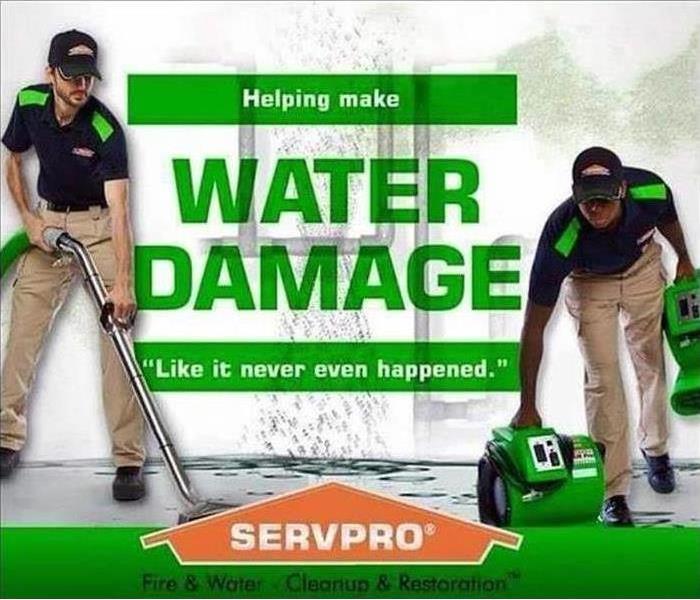 We are "Here To Help"
We are "Here To Help"
SERVPRO Handles the Entire Remediation Process
Water damage can come from many different sources, with varying intensities, danger levels, and reach of damage. Ultimately, many different objects, surfaces, and materials in a home can suffer water damage from the same event, and many homeowners question how a company such as SERVPRO handles a comprehensive water damage cleanup job. In this blog post, you'll learn about some of the ways our technicians control and repair water damage in local residences.
Identifying the Source and Water Type
Before all, water damage in Raytown/East Kansas City must be correctly defined by water type and source. Did it come from a storm or flood, or was it a pipe burst? There are also different types of water, typically categorized as either clean, gray, or black, each one with different safety and cleanup protocols. If necessary, our crew will work to stop the water flow as quickly as possible, to avert further damage to your home.
Surveying Damage and Mold
After we understand what type of damage we're dealing with, our technicians search the home visually and with moisture detection equipment to find out what objects have been affected, and what else needs to be done. Additionally, we look for signs of mold growth, which often takes priority in a cleanup operation.
Furniture and Water Removal
The next step is to remove all furniture from affected areas, and then pump out water if necessary. We use industrial-grade machinery to pump water from the interior to the exterior of the home, with either a portable or a truck-mounted pump.
Drying and Odor Treatments
At this point, we bring out more heavy machinery to begin drying and deodorizing the affected area, to make sure no more damage or mold growth occurs and any bad smells are removed.
Carpet Removal and Final Cleaning
In many cases, some or all of the carpeting in a room will need replacing. We make sure to evaluate carpeting carefully for moisture so as not to incur extra expenses. Sometimes, a cleaning may only be necessary, particularly when water damage is contained early on. After that is done, final cleanup and sanitization are done on walls and objects, and furniture is brought back into the home or rooms affected.
SERVPRO of Raytown/East Kansas City employs certified and well-trained technicians who are experienced with all kinds of water damage restoration and cleanup jobs. If you need our services for any type or volume of water damage to your home, call us at 816-737-8776 for 24/7 emergency service.
The Impact of Fire Damage on Your Property
8/8/2017 (Permalink)
 House fires cause unforeseen damage to your home.
House fires cause unforeseen damage to your home.
The Impact of Fire Damage on Your Property
Fire damage can have a detrimental impact on a person’s life. Whether there is a fire in home, or a fire in business, fire loss can be heart breaking. Soot damage and some damage can ruin so much of a person’s home. Not only is the fire itself terrible and devastating, but the actual fire cleanup can be awful as well. If a fire has recently occurred and caused commercial fire damage, or if the fire damage occurred die to a fire in home, this article is here to help you determine the best ways to address the aftermath.
First before any fire cleanup can occur it’s important to make sure that the fire in home or the fire in business is no longer a safety risk, especially if there was commercial fire damage. The local fire department can determine whether there is still a health risk in returning to cleanup the fire damage, the soot damage, or the smoke damage that has occurred. Fire loss is no laughing matter and should be addressed sagely and carefully.
Once you have had the notification that it’s now safe to enter your home to start the cleanup process, the actual soot damage, smoke damage, and amount of fire loss can be appraised. This can help to get the fire cleanup process settled so that you know the extent of the damage and make a plan to combat the fire damage. Before anything it’s important to stat ti our out the building, whether the damage was from a fire in home, or a fire in business. This will help the air quality and allow the prices of the cleanup of the soot damage or smoke damage to begin.
To start cleaning the soot damage and smoke damage it is absolutely crucial to make sure the air quality is fine before you begin, because too much smoke can have a detrimental impact on your heath. To begin this fire cleanup from the fire in home, fire in business, or commercial fire damage, you will need protective frat such as rubber gloves and eye protection. A bucket and spine will also be needed so that the soot damage can be scrubbed off from the walls. There are cleaning solutions that are available commercially to help you with this project. To make extra sure that the air quality is suitable it may be necessary to open a window. This is to ensure the air quality is not impacted by any apsidal smoke, and the air quality is not impacted by the cleaning agents being used.
After the walls have been cleaned the fire cleanup from other areas can being. Now the fire loss impact must be determined, and the items from the fire loss must be cleaned or discarded if they are beyond repair. This fire cleanup hopefully will not be too substantial, but it may be. If there is a large scale of destruction to may be a better idea to call professionals who can evaluate the damage and clean the mess for you. However, even if there was a fire in business or commercial fire damage you may be able to take care to the situation yourself be removing the soot form the commercial fire damage with a vacuum cleaner and rags.
Storm Damage Can Happen Anywhere!
8/3/2017 (Permalink)
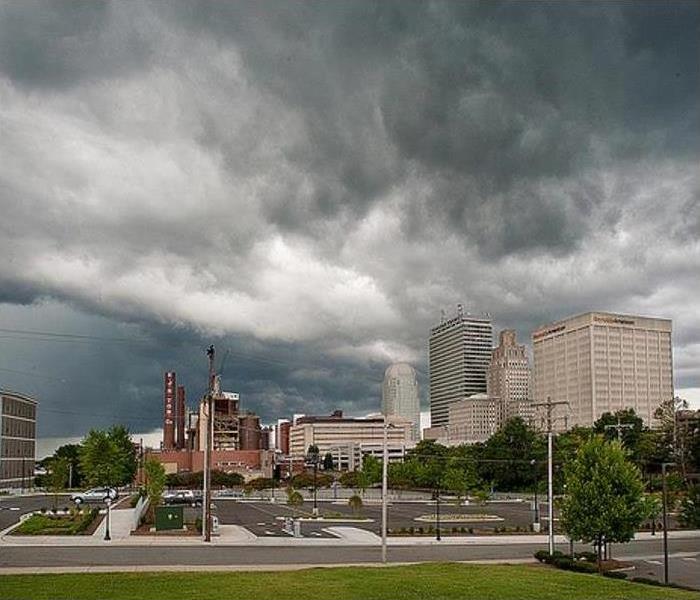 Call Raytown / East Kansas City SERVPRO today to begin your ERP. (816) 737-8776
Call Raytown / East Kansas City SERVPRO today to begin your ERP. (816) 737-8776
According to the National Weather Service (NOAA), “Approximately seventy-five percent of all Presidential disaster declarations are associated with flooding.” NOAA lists the most common flood hazards in the United States as:
- Flash Flooding
- River Flooding
- Storm Surge and Coastal Inundation from Tropical and Non-Tropical Systems
- Burn Scars/Debris Flows (Caused by Wildfires)
- Ice/Debris Jams
- Snowmelt
- Dry Wash (Caused by heavy rainfall in dry areas)
- Dam Breaks/Levee Failure
Just because you haven’t experienced a flood doesn’t mean you won’t in the future. In fact, 20% of all claims paid by the National Flood Insurance Program (NFIP) were for policies in low-risk communities. On average, floods cost $3.5 billion in annual losses in the U.S., and commercial flood claims average more than $75,000 (NFIP).
When catastrophic water damage happens to you, SERVPRO® Raytown/East Kansas City Professionals can help. They can help you prepare ahead of time with an Emergency Ready Profile® (ERP), or respond to any size disaster to begin cleanup and restoration to get you back in business as soon as possible.
Your local SERVPRO® Raytown/East Kansas City Professionals are ready to help make it “Like it never even happened.”
SERVPRO: Your Experts in Commercial Water Damage in Raytown/East Kansas City
8/1/2017 (Permalink)
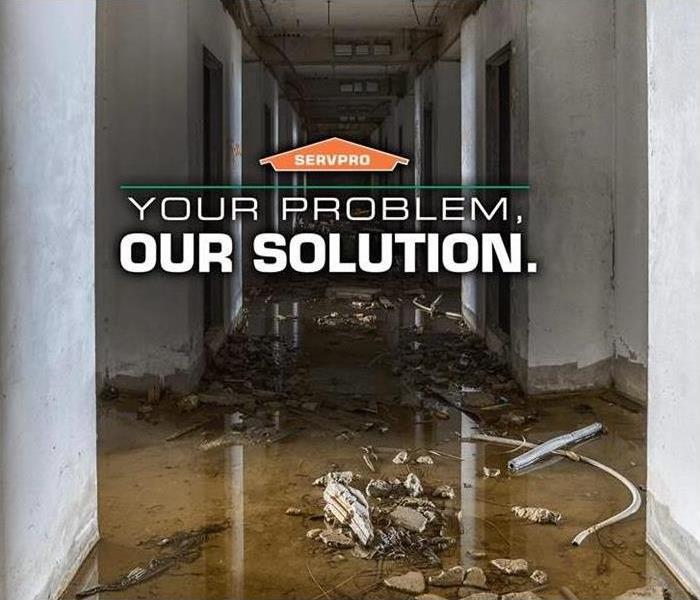 Have Questions? Call Us Today - (816)737-8776
Have Questions? Call Us Today - (816)737-8776
If you have recently become a victim of commercial water damage in Raytown/East Kansas City, MO, you may be wondering what you can do to mitigate your damages. There is a critical period in which certain actions must be taken to preserve as much of your property as possible and to decrease any health risks when water damage has occurred in a commercial space.
Preparing a Space for Water Damage Restoration
Before you enter your commercial space or any flooded building, you will need to make sure the electrical power to the structure is shut off. You should also be aware that during a flooding event, small animals or reptiles tend to seek shelter inside of buildings. Be prepared to deal with the discovery of wild animals in your space.
Protect yourself from entering any flooded building by wearing an organic vapor respirator. You can purchase these at any local paint and building supply stores. You also want to have rubber gloves, protective clothing, and eye protection. The first thing you should do is ventilate the affected areas by opening the windows and placing fans where possible.
Unfortunately, there likely will be items that you need to throw away. Any items that are porous and have absorbed contaminated floodwater cannot be restored. If your commercial space has drywall, mattresses, pillows, box springs, particle board, carpets or carpet pads, these will need to be discarded if they have become saturated. However, there is good news: If you have clothing or household fabrics that can be machine-washed, you may be able to salvage them. Use your washing machine to clean these items with a 10-minute soak at the minimum in hot water with detergent. The soap and normal wash should remove most of the contamination and any staining that is present.
Be aware that your commercial space will need a thorough professional inspection, cleaning and possibly restructuring. Water damaged walls and installations must be removed and repaired, and pockets of saturation should be exposed for drying and sanitizing. Always remember that mold growth could take a few days to appear as it thrives in a moist environment with organic-type materials such as paper or particle board and in temperatures that range between 60 and 86 degrees Fahrenheit. Keep good airflow throughout the interior environment, and maintain moderate temperatures to decrease the risk of any mold growth. It is also important that you let your space dry out before any rebuilding occurs.
Services You Can Count On in Raytown/East Kansas City, MO
You can depend on SERVPRO to provide reasonable prices for commercial damages and other services in the Raytown/East Kansas City area. Our restoration services include cleanup after water damage, fire damage, and storm damage. We also assist with mold remediation, and we're qualified to provide cleaning and building services. Our trained and certified IICRC technicians are available 24 hours a day, seven days a week to begin your restoration.
Fire Escape Planning for Your Business
7/30/2017 (Permalink)
 Are you prepared?
Are you prepared?
An emergency plan is not required for all businesses, however, OSHA recommends building an emergency action plan to protect yourself, your employees, and your business during an emergency. OSHA suggests the following steps when developing a plan.
Organize an Emergency Preparedness Procedures review with employees to review your company’s emergency plans. You may wish to select an individual or team of individuals to lead and coordinate your emergency plan.
Once a plan is developed, post evacuation procedures, including routes and exits, where they are easily accessible to all employees. Ensure all exits and routes are clearly marked, and well lit, wide enough to accommodate the number of evacuating personnel, and unobstructed and clear of debris at all times.
Conduct office evacuation exercises and drills. Designate a safe spot outside of the facility where employees can regroup, recover and conduct a head count. Once completed, evaluate how well the plan worked and if additional training or exercises are needed.
Is There Mold Hidden in YOUR Home?
7/29/2017 (Permalink)
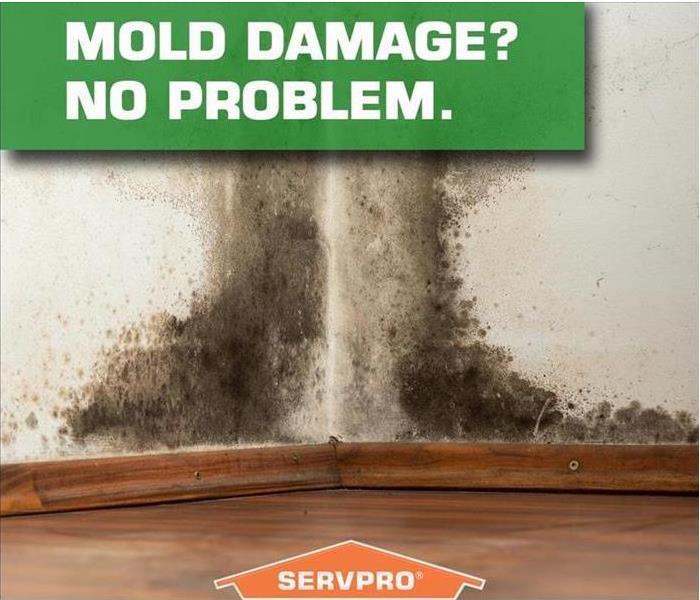 Call Raytown / East Kansas City SERVPRO with any mold problems. (816) 737-8776
Call Raytown / East Kansas City SERVPRO with any mold problems. (816) 737-8776
Mold can occur anywhere in a home but mainly is concentrated to areas where moisture is present. These moisture areas are common to the bathroom and basements. Mold can cause respiratory problems and should be removed, if found, as soon as possible. Most restoration companies only do mold inspections if the mold is visible, an industrial hygienist would come in and search for traces of mold that are not visible.
One of the first places mold can collect and you may not think to check is under the refrigerator. Under the fridge tends to collect moisture and dirt which can cause a breeding ground for bacteria and mold.
Another place is the AC unit. AC units are known to collect debris, dust and moisture from the air, which can lead to mold spores.
Mold can even grow in or around a washing machine or its parts. Moisture and lint can cause a presence of mold spores.
Other areas in the house include anywhere moisture and dirt may form such as window corners.
Mold Remediation Process
7/25/2017 (Permalink)
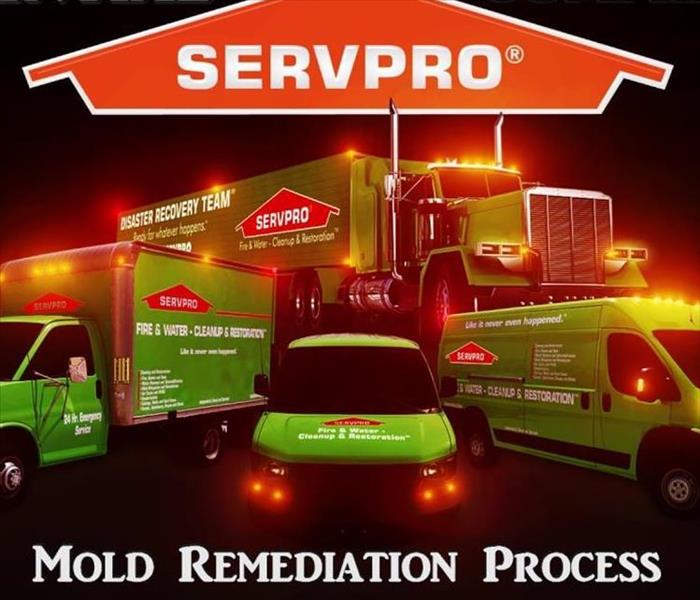 Call Raytown / East Kansas City SERVPRO today if you have any mold issues. (816) 737-8776
Call Raytown / East Kansas City SERVPRO today if you have any mold issues. (816) 737-8776
Mold Remediation Process
Every mold damage scenario is different and requires a unique solution, but the general mold remediation process stays the same. The steps listed below illustrate the “typical” process:
•The mold cleanup and restoration process begins when you call SERVPRO of Raytown / East Kansas City (816) 737-8776. Our representative will ask a series of questions to help us determine the necessary equipment, resources, and personnel.
•SERVPRO Franchise Professionals will carefully inspect your property for visible signs of mold. Mold feeds on cellulose and water and can be hidden from plain view. They use various technologies to detect mold and hidden water sources.
•They use various containment procedures to prevent the spread of mold. They may use advanced containment procedures like negative air chambers to isolate the contaminated area with physical barriers and negative air pressure to keep the mold spores from spreading during the cleanup process. All fans and heating and cooling systems will be turned off to prevent the spread of mold.
•Their specialized filtration equipment allows their Professionals to capture microscopic mold spores out of the air. They utilize powerful “air scrubbers” and HEPA vacuums to prevent the spread of these mold spores while the mold remediation is in process.
•The mold remediation process depends on the amount of mold growth and the types of surfaces on which the mold appears. SERVPRO of Raytown / East Kansas City uses anti-fungal and antimicrobial treatments to eliminate mold colonies and to help prevent new colonies from forming. Removing and disposing of mold-infested porous materials, like drywall and carpeting, may be necessary to remediate heavy mold growth.
•SERVPRO of Raytown / East Kansas City will clean your furniture, decorative items, curtains, clothing, and other restorable items affected by mold. They use a variety of cleaning techniques to clean and sanitize your belongings. They’re also trained to remove odors and deodorization using fogging equipment.
•Depending on the level of mold damage, drywall, subfloors, and other building materials may be removed. Restoration may involve minor repairs, such as replacing drywall, painting, and installing new carpet; or it may entail major repairs such as the reconstruction of various areas or rooms in a home or business.
Turn and Test
7/24/2017 (Permalink)
 When in doubt, test it out!
When in doubt, test it out!
Great Advice from American Red Cross!
Did you know:
- Every day 7 people die in the United States due to a home fire
- You have two minutes- that 120 seconds – to escape a home fire
- On an annual average, the Ohio Buckeye Region of the Red Cross responds to over 3 home fires per day in our 45 counties!
The American Red Cross cares about your safety and encourages you to test your smoke alarms and replace your batteries as needed. This is a lifesaving action of our Home Fire Preparedness Campaign, which rallies communities across the country to protest people from these every day disasters. Don't ignore the beeping sound of batteries going dead on a fire alarm, take a few minutes and go change the batteries right away! Your safety is in your own hands!
SERVPRO Carpet Cleaning Options
7/22/2017 (Permalink)
 Extend the life of your carpets, have them cleaned by professional from SERVPRO of Raytown/East Kansas City.
Extend the life of your carpets, have them cleaned by professional from SERVPRO of Raytown/East Kansas City.
Today's carpet and upholstery materials vary dramatically. SERVPRO of Raytown / East Kansas City offers a number of cleaning options to match any type of upholstery or carpet.
SERVPRO of Raytown / East Kansas City Professionals also offer a range of specialized carpet cleaning methods:
• Bonnet Cleaning: A less aggressive method for short piled carpets.
• Hot Water Extraction: A deeper cleaning method for all carpet types.
• Deluxe Precondition and Rinse: Helps restore deeply soiled areas.
• Showcase Premier Cleaning: The most thorough cleaning method in the industry.
• Dry Cleaning: When color-fastness is an issue.
Preventative Maintenance
Carpets act as a filter, trapping dust, dirt, gases, animal hair, and other soils. All carpet manufacturers agree on actions you can take between carpet cleanings to increase the life span of your carpet.
IICRC states that 79% of soil in carpet is dry soil. Vacuuming is a key component to proper care and maintenance of carpet.
Preventative maintenance actions include:
•Regular vacuuming
•Spot removal
•Pilating the carpet to prevent matting
•Moving furniture to change traffic patterns
•Using walk-off mats to limit the amount of soil tracked onto the carpet
Water Damage Restoration Tips For Your House After A Flood
7/3/2017 (Permalink)
 Contact SERVPRO of Raytown / East Kansas City today to be prepared for when natural disasters like this strike near you.
Contact SERVPRO of Raytown / East Kansas City today to be prepared for when natural disasters like this strike near you.
Water Damage Restoration Tips For Your House After A Flood
A few years back, homes, business properties and personal items devastated by flood water were considered lost. Today, with innovations in technology, the losses due to flood damage can now be restored to their former state. The process is not easy, it requires extensive mopping up and drying of the property after a severe water damage.
Flood water in home or business can damage your walls, floors, carpets and other personal belongings too. Extracting the water is impossible without proper equipment while sun drying does not guarantee your assets' restoration to their former state before the incident. There is also an additional risk the water in the home might have damaged electrical equipment or wires. Anyone tampering with either could be in for a horrible electrocution during the water cleanup and restoration.
For these reasons, water cleanup and restoration is best handled by professionals. They have to requisite experience, state-of-the-art equipment and techniques to do the job properly and offer mitigation against further damage. If the renovation job requires extensive work, promptness in beginning the works is paramount. The less the time-frame between flood damage and refurbishment, the greater the ease of reinstating a property or item to its preloss state. There are four fundamental steps to follow with any renovation job after a water damage:
- Removal of the Flood Water
The first important step to restoring a property after damaging from water in home or business premise is removing the stagnant water. Often, a submersible pump is used to remove the water accumulation in various structures around the premises.
2. Moisture Mapping
It is crucial to get an idea of the extent of water damage and take the first mitigation steps against mold growth. The step uses detection equipment to obtain and appropriately map the moisture values on the property. Properly trained technicians use infrared and digital imaging to determine the damage extent.
3. Mold Inspection and Removal
After moisture mapping, the house will need to be prepared to repel mold and mildew. Any residual stagnant water in business or homestead leads to a favorable habitat for the fungi to thrive thus mitigation against it is essential. Water cleanup professionals make use of special detergents to sterilize the area and make the surroundings unfavorable for mold growth. Some renovation firms take advantage of deodorization and ventilation during this step to remove any airborne contaminants and lingering, unpleasant odors.
4. Water Drying
This last step ensures the property is completely dry and humidity is brought back to its normal state after flood damage. There are various water drying techniques and the one used will depend on the situation’s severity. These techniques include:
- Air Movers- They help dry the establishment by controlling humidity and promoting air circulation. Working in sections, the air movers remove liquids from all porous materials including carpets and wood. Any remaining water in home or business premises is left for more sophisticated machines.
- Dehumidifiers- They remove moisture form the air and help extract any remaining water in business or home environment. Broadly, professional use either desiccant or refrigerant dehumidifier. Desiccant dehumidifiers operate by cooling the air to make it reduce its ability to retain water. As a result, condensation occurs around the equipment’s cooling coils. Applying these machines on a large scale promptly extracts excess humidity from the air leaving no more water in business or household and thus no further water damage. The particular type of equipment, however, depends on the tired company and how extensive the restoration job is.
With the right professionals, a successful water cleanup is possible, and any damage from water in business or home establishment can be fixed. Each job, however, is unique and requires prompt, proper investigation. This helps come up with a plan based on the steps above to restore the property after water damage. Visit http://www.SERVPROraytowneastkansascity.com/water-damage-restoration for more information on water damage.
New Marketing Car
10/1/2013 (Permalink)
 Take your picture with me for a chance to WIN a dinner for 2!
Take your picture with me for a chance to WIN a dinner for 2!
We have added a New Marketing Car to our fleet! If you see it out snap a picture of yourself next to it and upload it on our facebook for a chance to WIN a dinner for 2!





 24/7 Emergency Service
24/7 Emergency Service

